Starliner CST-100 (Crew Space Transportation-100)
Non-EO
NASA
Human Spaceflight
Quick facts
Overview
| Mission type | Non-EO |
| Agency | NASA |
| Launch date | 20 Dec 2019 |
Starliner CST-100 (Crew Space Transportation-100) System of Boeing
The CST-100 Starliner crew capsule is a spacecraft design constructed by Boeing in collaboration with Bigelow Aerospace as their entry for NASA's Commercial Crew Development (CCDev) program. Its primary purpose is to transport crew to the ISS (International Space Station) and to private space stations such as the proposed Bigelow Aerospace Commercial Space Station.
Background
NASA's Commercial Crew Development(CCDev) program started in 2006 with the goal of establishing a US commercial crew space transportation capability to achieve safe, reliable and cost-effective access to LEO (Low Earth Orbit) and the ISS (International Space Station). To achieve this goal by 2017, NASA is supporting a number of commercial companies by providing funds, data and assistance as these companies go through their development efforts and meet milestones which are reviewed by NASA.
• In the first phase of the program, NASA provided a combined $50 million in 2010 to five American companies, intended to foster research and development into human spaceflight concepts and technologies in the private sector.
• A second set of Commercial Crew Development proposals were solicited by NASA in October 2010 for technology development project durations of up to 14 months.
• In August 2012, NASA awarded Space Act Agreements for the third phase, named CCiCap (Commercial Crew Integrated Capability). NASA partnered with companies to mature the design and development of transportation systems that include spacecraft, launch vehicles, and ground and mission systems.
• As of August 31, 2013, NASA has spent $1.1 billion of seed money on its commercial crew development efforts in a public/private partnership. NASA is currently working with three companies – The Boeing Company (Boeing), Space Exploration Technologies Corporation (SpaceX), and Sierra Nevada Corporation (Sierra Nevada) – using a combination of funded Space Act Agreements and contracts based on the Federal Acquisition Regulation (FAR) to develop commercial crew transportation capabilities. 1)
NASA's Acquisition Strategy
1) NASA awarded firm-fixed-price contracts to Boeing, SpaceX, and Sierra Nevada for delivery and acceptance of certification plans for their crew transportation system.
2) In mid-summer 2014, NASA plans to enter into at least one but ideally two firm-fixed-price contracts for the verification, validation, test, and final certification of a crew transportation system or systems.
3) NASA plans to implement Part 3 of the acquisition strategy by issuing a firm-fixed-price ISS transportation services contract to at least one partner in 2017.
In May 2014, NASA and Industry completed the First Phase to Certify New Crew Transportation Systems. Under the contracts, The Boeing Company, Sierra Nevada Corporation Space Systems (SNC) and Space Exploration Technologies (SpaceX) completed reviews detailing how each plans to meet NASA's certification requirements to transport space station crew members to and from the orbiting laboratory. NASA awarded the contracts totaling $30 million in December 2012. 2)
CCDev projects:
• The Boeing entry is called CST-100 (Crew Space Transportation-100)
• The Dragon Spacecraft is the entry of SpaceX
• The SNC (Sierra Nevada Corporation) entry is the Dream Chaser spaceplane.
Transportation of U.S. Astronauts to the International Space Station 3)
On Sept. 16, 2014, NASA Administrator Charles Bolden announced the selection of Boeing and SpaceX to transport U.S. crews to and from the space station using their CST-100 and Crew Dragon spacecraft (Dragon V2), respectively, with a goal of ending the nation’s sole reliance on Russia in 2017.
These Commercial Crew Transportation Capability (CCtCap) contracts are designed to complete the NASA certification for human space transportation systems capable of carrying people into orbit. Once certification is complete, NASA plans to use these systems to ferry astronauts to the International Space Station and return them safely to Earth.
The companies selected to provide this transportation capability and the maximum potential value of their FAR (Federal Acquisition Regulation)-based firm fixed-price contracts are:
• The Boeing Company, Houston, $4.2 billion
• Space Exploration Technologies Corp., Hawthorne, California, $2.6 billion
The awards from NASA’s Commercial Crew Program (CCP) offices will continue to be implemented as a PPP (Public-Private Partnership) service and are the fruition of NASA’s strategy to foster the development of privately built human spaceships that began in 2010.
Design
The design draws upon Boeing's experience with NASA's Apollo, Space Shuttle and ISS programs as well as the Orbital Express project sponsored by the Department of Defense. The CST-100 has no Orion heritage, but it is sometimes confused with the earlier and similar Orion-derived Orion Lite proposal that Bigelow Aerospace was reportedly working on with technical assistance from Lockheed Martin.
It will use the NASA Docking System for docking and use the Boeing Lightweight Ablator for its heatshield. The Starliner's solar cells will provide more than 2.9 kW of electricity, will be placed on top of the micro-meteoroid debris shield located at the bottom of the spacecraft's service module.
The Starliner was designed to accommodate seven passengers, or a mix of crew and cargo, for missions to low-Earth orbit. For NASA service missions to the International Space Station, it will carry up to four NASA-sponsored crew members and time-critical scientific research. The Starliner has an innovative, weldless structure and is reusable up to 10 times with a six-month turnaround time. It also features wireless internet and tablet technology for crew interfaces. 4)
For NASA service missions to the International Space Station, it will carry up to four NASA-sponsored crew members and time-critical scientific research. The Starliner has an innovative, weldless structure and is reusable up to 10 times with a six-month turnaround time. It also features wireless internet and tablet technology for crew interfaces.
As a 21st century, fully self-flying spacecraft, Starliner will seek out the International Space Station, dock with it, undock and then safely land, all without human intervention. Manual controls, designed in part by Boeing astronaut Chris Ferguson, are always available as a backup, but crew members are intended to be able to enjoy the orbital cruise.
Rendezvous and docking are among the most difficult spaceflight challenges, and starliner does both completely autonomously. Rendezvous procedures start dozens of kilometers away, when Starliner's camera spot the space station as a bright spot of light in front of a sea of stars. Then, an intricate orbital maneuver begins as Starliner drift closer and closer to the station. Hundreds of finely tuned thruster firings then guide Starliner into dock.
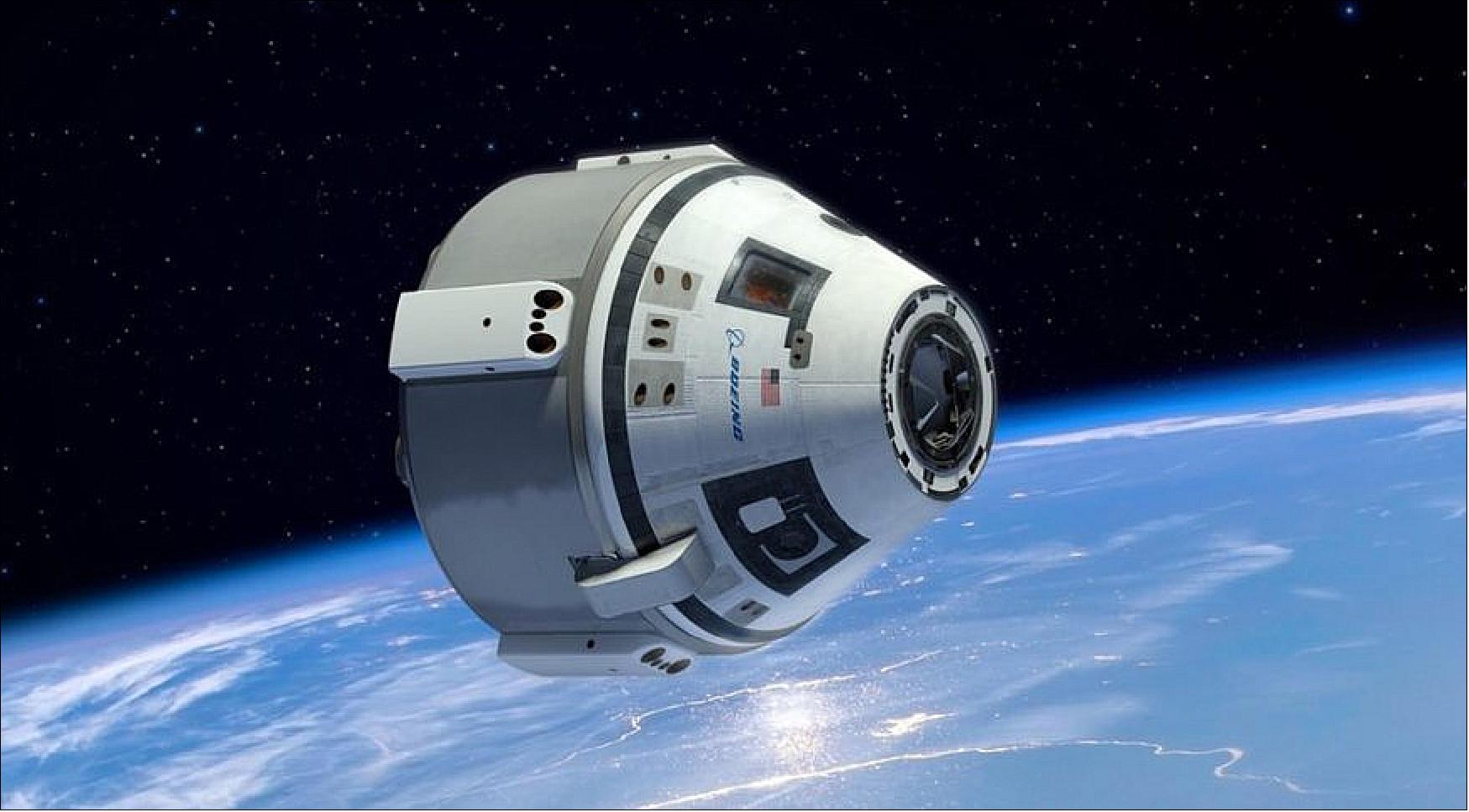
Development Status/ Events of CST-100 Starliner
• July 28, 2022: Boeing said July 27 it will take another charge against its earnings because of the CST-100 Starliner commercial crew program as the company and NASA get closer to a first flight of the vehicle with astronauts on board. 5)
- Boeing, in its second quarter financial results release, said it recorded a $93 million charge in the quarter from its commercial crew program, “driven by launch manifest updates and additional costs associated with OFT-2,” the second uncrewed test flight of the vehicle that took place in May.
- The company did not elaborate on the specific issues that caused the charge, and only briefly mentioned the program during an earnings call with financial analysts dominated by the company’s commercial airliner programs.
- “It was important. It was an emotional ‘up’ for all of us at Boeing to get back on track,” David Calhoun, president and chief executive of Boeing, said in the call, referring to the OFT-2 test. He later called the mission “a pivotal and emotional test for The Boeing Company and we feel good about it and we’re ready for the crewed flight.”
- Boeing has now recorded $688 million in charges related to development of Starliner. The company took a $410 million charge in January 2020, a month after the original and unsuccessful Orbital Flight Test mission, to cover the costs of investigating the problems and flying a second mission. The company took an additional $185 million charge against earnings in October 2021 after a valve problem delayed the OFT-2 launch last August.
- The six-day OFT-2 mission in May, though, was largely successful, with no major issues reported during the spacecraft’s launch, docking with the International Space Station and return to Earth. That leaves open the possibility of proceeding with Starliner’s first flight with astronauts on board, called the Crew Test Flight (CFT), before the end of the year.
- “You saw the Starliner dock with the ISS, setting the stage for the Crew Flight Test later this year and achieving the domestic redundancy that is so important to the ISS mission,” John Mulholland, vice president and program manager for the ISS at Boeing, said in remarks July 26 at the ISS Research and Development Conference here.
- NASA announced June 16 that CFT will fly two astronauts, Suni Williams and Butch Wilmore, rather than the three originally planned to fly the mission. Williams was moved up to CFT from Starliner-1, the first operational Starliner mission. Nicole Mann, who has originally been assigned to CFT, was reassigned last year to SpaceX’s Crew-5 mission launching in September. Mike Fincke, also previously assigned to CFT, will train as a backup for CFT and be available for future flight assignments.
- The CFT mission, NASA announced then, will last two weeks after earlier proposing to keep it at the station for up to six months. A two-week mission, the agency said, “is sufficient to meet all NASA and Boeing test objectives for CFT,” and a longer stay is not needed since Crew Dragon is now handling crew rotation missions.
- If CFT is successful, Starliner could start operational missions as soon as the fall of 2023, after the SpaceX Crew-6 mission launching in the spring of 2023. That will be the first of six missions under its Commercial Crew Transportation Capabilities, or CCtCap, contract awarded in 2014. NASA has already added three flights to the six awarded to SpaceX under its own CCtCap contact, and announced June 1 its intent to add five more.
• June 16, 2022: NASA will fly two astronaut test pilots aboard the agency’s Boeing Crew Flight Test (CFT) mission to the International Space Station, where they will live and work off the Earth for about two weeks. 6)
- CFT commander Barry “Butch” Wilmore, whom NASA assigned to the prime crew in October 2020, will join NASA astronaut Suni Williams, who will serve as pilot. Williams previously served as the backup test pilot for CFT while assigned as commander of NASA’s Boeing Starliner-1 mission, Starliner’s first post-certification mission. As CFT pilot, Williams takes the place of NASA astronaut Nicole Mann, originally assigned to the mission in 2018. NASA reassigned Mann to the agency’s SpaceX Crew-5 mission in 2021.
- Based upon current space station resources and scheduling needs, a short duration mission with two astronaut test pilots is sufficient to meet all NASA and Boeing test objectives for CFT, which include demonstrating Starliner’s ability to safely fly operational crewed missions to and from the space station. To protect against unforeseen events with crew transportation to the station, NASA may extend the CFT docked duration up to six months and add an additional astronaut later, if needed.
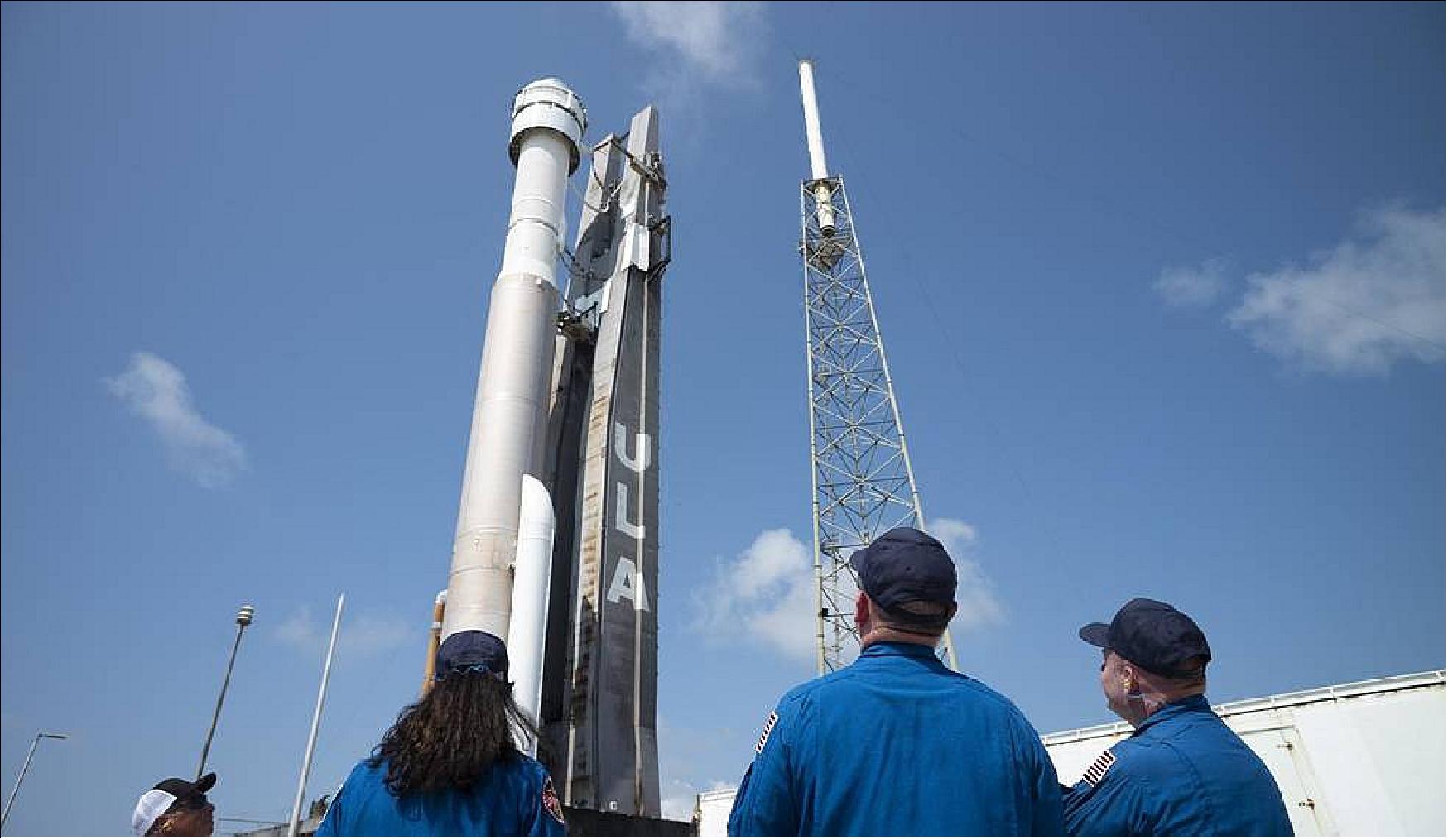
- NASA astronaut Mike Fincke, whom the agency previously assigned as the Joint Operations Commander for CFT, will now train as the backup spacecraft test pilot and remains eligible for assignment to a future mission. Fincke’s unique expertise will continue to benefit the team as he retains his position as flight test lead, filling a vital role in Starliner certification.
- "Mike Fincke has dedicated the last nine years of his career to these first Boeing missions and Suni the last seven. Butch has done a marvelous job leading the team as the spacecraft commander since 2020,” said Reid Wiseman, chief, Astronaut Office at NASA’s Johnson Space Center in Houston. “It was great to see Starliner’s successful journey to the International Space Station during the Orbital Flight Test-2 (OFT-2) mission last month. We are all looking forward to cheering on Butch and Suni as they fly the first crewed Starliner mission."
- Wilmore, Williams, and Fincke each have flown previously as long-duration crew members aboard the space station.
- NASA astronaut Jeanette Epps continues to prepare for an upcoming long duration mission aboard Starliner-1. NASA also has identified backup flight opportunities for Epps on the SpaceX Crew Dragon spacecraft for additional scheduling and resource flexibility. Epps has begun cross-training on the SpaceX Crew Dragon spacecraft to prepare for this possibility.
- Meanwhile, NASA and Boeing are continuing to conduct OFT-2 data reviews while assessing future CFT launch opportunities. Following successful completion of the uncrewed OFT-2 mission, the Starliner crew module has returned to Boeing’s Commercial Crew and Cargo Processing Facility at NASA’s Kennedy Space Center in Florida, where it will undergo system checkouts and vehicle inspections. The Starliner team is in the process of delivering the initial test flight data to NASA and jointly determining forward work ahead of a crewed flight. These engineering and program reviews are expected to continue for several weeks, culminating in a launch schedule assessment at the end of July, based upon spacecraft readiness, space station scheduling needs, and Eastern Range availability.
- “Starliner and the Atlas V performed well during all phases of OFT-2, and now we are taking a methodical look at each system to determine what needs to be upgraded or improved ahead of CFT, just as we do with every other crewed flight,” said Steve Stich, manager, NASA’s Commercial Crew Program. “Additionally, Butch, Suni, and Mike have been instrumental in the development of Starliner on the path to having a second space station crew transportation system.”
- For the crewed flight test, Boeing’s Starliner will launch aboard a United Launch Alliance Atlas V rocket from Space Launch Complex-41 at Cape Canaveral Space Force Station in Florida.
- Following a successful CFT mission, NASA will begin the final process of certifying the Starliner spacecraft and systems for crew missions to the space station. Regular, long-duration commercial crew rotation missions enable NASA to continue the important research and technology investigations taking place aboard the orbiting laboratory. Such research benefits people on Earth and lays the groundwork for future exploration of the Moon and Mars, starting with the agency’s Artemis missions, which include landing the first woman and first person of color on the lunar surface.
• May 26, 2022: NASA and Boeing safely landed the company’s CST-100 Starliner spacecraft Wednesday in the desert of the western United States, completing the uncrewed Orbital Flight Test-2 (OFT-2) to the International Space Station to help prove the system is ready to fly astronauts. 7)
- About four hours after departing the space station, Starliner touched down onto its airbags at 4:49 p.m. MDT (22:49 UTC on 25 May 2022), wrapping up the six-day flight, which tested the end-to-end capabilities of the crew-capable spacecraft. The landing followed a deorbit burn at 4:05 p.m. (22:05 UTC), separation of the spacecraft’s service module, and successful deployment of its three main parachutes and six airbags.
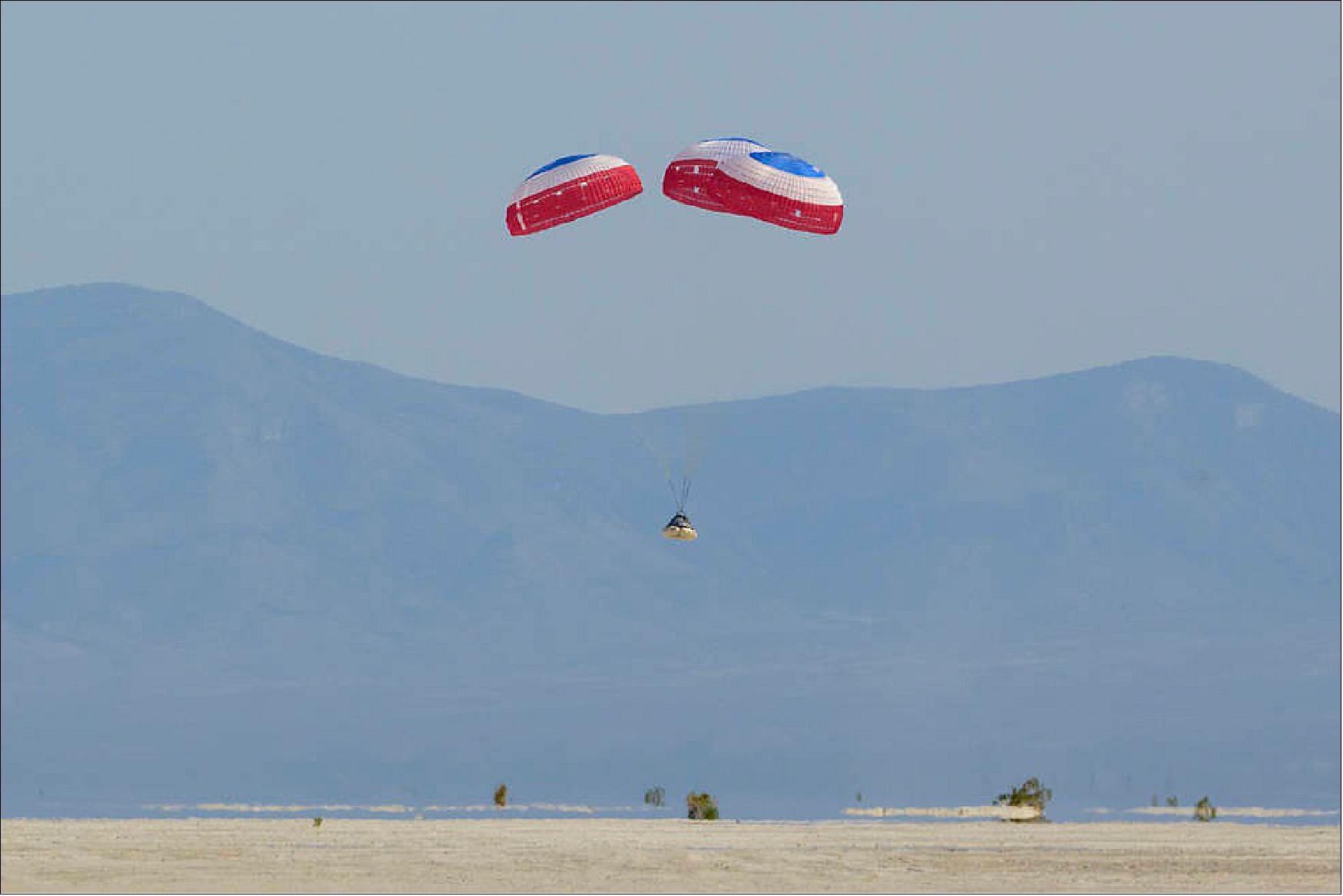
- “NASA’s Commercial Crew Program and our industry partner, Boeing, today took a major and successful step on the journey to enabling more human spaceflight missions to the International Space Station on American spacecraft from American soil,” said NASA Administrator Bill Nelson. “The OFT-2 mission represents the power of collaboration, which allows us to innovate for the benefit of humanity and inspire the world through discovery. This golden era of spaceflight wouldn’t be possible without the thousands of individuals who persevered and poured their passion into this great achievement.”
- As part of the flight test for NASA’s Commercial Crew Program, Boeing accomplished planned test objectives, including:
a) Starliner launch and normal trajectory to orbital insertion
b) Launch of United Launch Alliance’s (ULA) Atlas V and dual-engine Centaur second stage
c) Ascent abort emergency detection system validation
d) Starliner separation from the Atlas V rocket
e) Approach, rendezvous, and docking with International Space Station
f) Starliner hatch opening and closing, astronaut ingress, and quiescent mode
g) Crew habitability and internal interface evaluation
h) Starliner undocking and departure from space station
i) Starliner deorbit, and crew module separation from service module
j) Starliner descent and atmospheric entry with aero-deceleration system
k) Precision targeted landing and recovery.
- “I am incredibly proud of the dedication and perseverance shown by the NASA, Boeing and ULA team culminating in the successful completion of Starliner’s second Orbital Flight Test from start to finish,” said Steve Stich, manager, NASA’s Commercial Crew Program. “Throughout this process, Starliner has provided a tremendous amount of valuable data, which we’re continuing to assess in our effort to bring the spacecraft online and fully operational for crew flights to the space station as soon as it is safe to do so.”
- The flight test began Thursday, May 19, when Starliner launched on the ULA Atlas V rocket from Space Launch Complex-41 at Cape Canaveral Space Force Station in Florida.
- Following liftoff, Starliner successfully entered Earth’s orbit, performed a series of demonstrations of its capabilities, and docked with the orbital outpost 26 hours after launch. The Expedition 67 crew aboard the station opened hatches and entered the capsule for the first time, inspecting the spacecraft and verifying integration with power and communications station systems for longer stays in the future. The station crew also unloaded 500 pounds of cargo delivered by Starliner and sent 600 pounds of cargo back to Earth.
- “Congratulations to the NASA and Boeing teams,” said Joel Montalbano, manager of NASA’s International Space Station Program. “I am excited to see the completion of a critical step in bringing another system online to transport long-duration crew members to and from the International Space Station. Soon, we hope to see crews arrive to the space station on Starliner to continue the important microgravity scientific research and discovery made possible by the orbiting laboratory.”
- A critical step in validating the performance of Boeing’s systems, OFT-2 brings the nation a significant step closer to having two unique human transportation systems to carry astronauts to and from the space station from U.S. soil.
- “We have had an excellent flight test of a complex system that we expected to learn from along the way and we have,” said Mark Nappi, vice president and program manager, Boeing Commercial Crew Program. “With the completion of OFT-2, we will incorporate lessons learned and continue working to prepare for the crewed flight test and NASA certification. Thank you to the NASA and Boeing teammates who have put so much of themselves into Starliner.”
- Starliner carried a “passenger” on this flight test – a lifelike test device named Rosie.
- During OFT-1, Rosie was outfitted with 15 sensors to collect data on what astronauts will experience during flights on Starliner. For OFT-2, spacecraft data capture ports previously connected to Rosie’s 15 sensors were used to collect data from sensors placed along the seat pallet, which is the infrastructure that holds all the crew seats in place. Among the cargo returned were three Nitrogen Oxygen Recharge System reusable tanks that provide breathable air to station crew members. The tanks will be refurbished on Earth and sent back to station on a future flight.
- Boeing retrieved the spacecraft from the desert and will transport it back to the company’s Commercial Crew and Cargo Processing Facility at NASA’s Kennedy Space Center in Florida for processing.
- After NASA and Boeing review processes data from this test flight, teams will continue plans for Starliner and its next mission, the Crew Flight Test to the space station.
• May 23, 2022: As Boeing’s CST-100 Starliner prepares to return from its brief trip to the International Space Station, NASA officials say they’ll wait until this summer to determine the schedule for the vehicle’s first crewed flight and the astronauts who will fly it. 8)
- NASA said May 23 it would proceed with plans to have Starliner return to Earth May 25, six days after its launch on the Orbital Flight Test (OFT-2) uncrewed mission. The astronauts on the ISS will close Starliner’s hatch May 24, with undocking about 24 hours later at 2:36 p.m. Eastern May 25. That would allow Starliner to land at White Sands Space Harbor in New Mexico at 6:49 p.m. Eastern that day.
- In prelaunch briefings, NASA officials declined to set a date for the next test flight, the Crew Flight Test (CFT), which will carry people for the first time. The schedule, they said, will depend on any modifications to the spacecraft that emerged from OFT-2. The current mission has experienced several minor issues with malfunctioning thrusters and cooling systems, none serious enough to alter the mission.
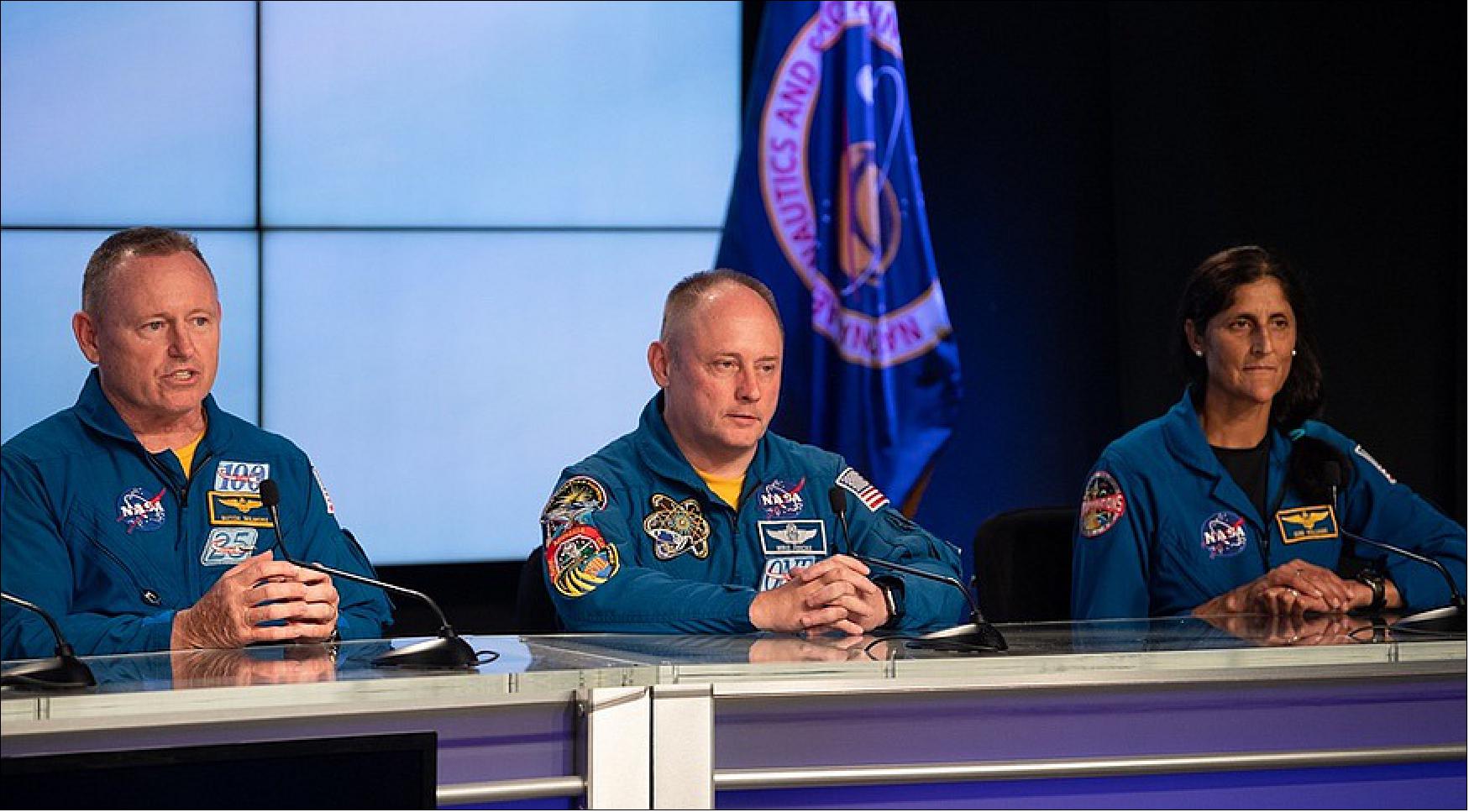
- “One of the things we have to do is do this mission,” Kathy Lueders, NASA associate administrator for space operations, said of OFT-2 at a May 18 briefing. “We know we’ll have learning out of this mission, and then lay that into our plans and our schedule with the Boeing folks.” She anticipated knowing more details about CFT in the summer.
- That includes determining who will fly on CFT. NASA announced in October 2021 that Nicole Mann, who had been previously assigned to CFT, would instead fly on the Crew-5 Crew Dragon mission to the ISS, scheduled for launch this September. NASA also reassigned Josh Cassada, who previously was set to fly on the first operational Starliner mission, called Starliner-1, to Crew-5.
- At the time, NASA said it was keeping the other two veteran astronauts on CFT, Mike Fincke and Butch Wilmore, with Suni Williams also remaining on Starliner-1 with Jeanette Epps. But at the May 18 briefing, Fincke, Wilmore and Williams said they were training together as a “cadre” that could go on either mission.
- “We had a launch attempt with a valve issue back in late July, early August, of last year that changed things,” Wilmore said, referring to the initial OFT-2 launch attempt that was postponed because of stuck propellant valves in the spacecraft’s service module. “Since that time in August, the three of us have been working as a cadre supporting Starliner, and we know we are not necessarily assigned to CFT.”
- There are no plans, she added, to fly a Boeing astronaut on CFT. The mission originally included Chris Ferguson, a former NASA astronaut who now works for Boeing, as a commercial astronaut with two NASA astronauts. However, Ferguson dropped out of the mission in October 2020 citing family obligations when CFT was anticipated for 2021. Wilmore replaced Ferguson on the mission.
- If CFT solely serves as a test flight, Lueders said it will probably last only five to seven days. SpaceX’s crewed test flight, Demo-2, spent two months at the station in 2020 to provide additional crew given only three people were at the station at the time. The mission will have a minimum of two people, she said.
- Another factor for planning future crews is a still-pending agreement with Roscosmos that will allow Russian cosmonauts to fly on commercial crew vehicles in exchange for NASA astronauts going on Soyuz spacecraft. Agency officials say they remain hopeful an agreement can be reached in time for a Russian cosmonaut to be on the Crew-5 mission launching in early September.
- It’s not clear, though, when Roscosmos would be willing to allow cosmonauts to fly on Starliner, given that agency’s initial reticence to flying cosmonauts on Crew Dragon until it performed several crewed flights. “They’re going to want to see the results from our test flights and they’re going to want us finish CFT and then we’ll have similar conversations,” Dana Weigel, NASA ISS deputy program manager, said May 17.
- That could make crew swaps challenging if Roscosmos is willing to fly cosmonauts on Crew Dragon but not Starliner, given NASA’s plans to alternate commercial crew missions between the two spacecraft once Starliner is certified.
- “It’s another complexity going forward,” Lueders acknowledged, with the agency hoping to know “fairly quickly” when Roscosmos would allow cosmonauts to go on Starliner. “It’s another piece of the puzzle.”
• May 23, 2022: Two Expedition 67 astronauts are unloading cargo delivered inside Boeing’s Starliner crew ship and testing its systems ahead of its departure this week. Meanwhile, the other residents aboard the International Space Station are juggling advanced space research and orbital lab maintenance. 9)
- NASA Flight Engineers Kjell Lindgren and Bob Hines have been unpacking some of the 500 pounds of NASA cargo delivered aboard Starliner on Friday. The duo has also been testing the commercial crew vehicle’s communications and power systems.
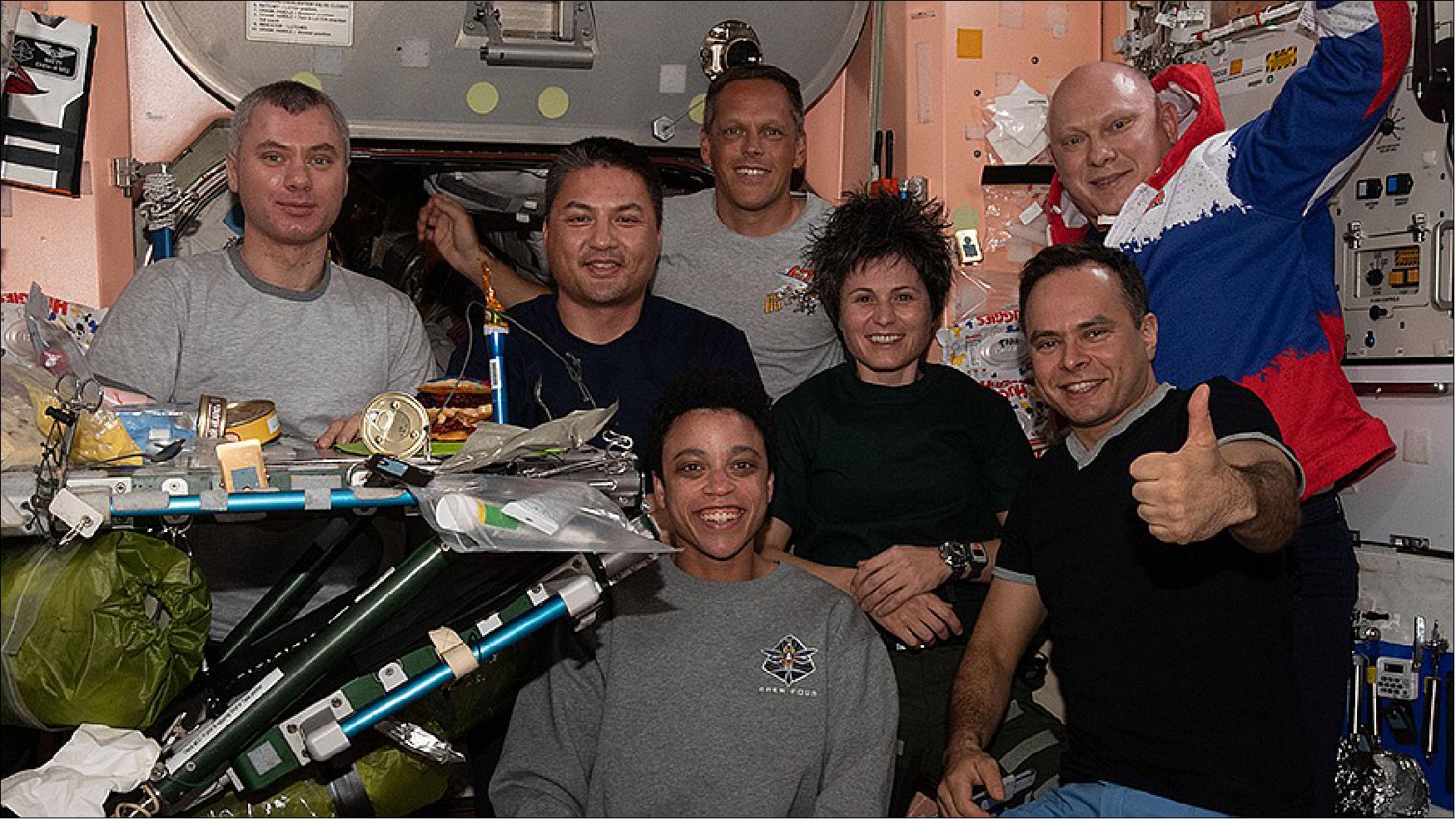
- They will turn their attention on Tuesday to readying Starliner for its undocking and return to Earth on Wednesday. Lindgren and Hines will pack Starliner with 600 pounds of return cargo, close the vehicle’s hatch, and monitor its departure set for 2:36 p.m. EDT on Wednesday. It will parachute to a landing in White Sands Space Harbor in New Mexico at 6:49 p.m. (4:49 p.m. Mountain Time) the same day.
- Science is always underway on the orbiting lab with the crew exploring a multitude of phenomena to benefit humans living on Earth and in space. Today, NASA Flight Engineer Jessica Watkins attached electrodes to herself and scanned her neck, chest and leg with an Ultrasound device for the Vascular Echo study. The experiment investigates how microgravity affects an astronaut’s arteries and veins with insights possibly improving cardiovascular conditions on Earth.
- Astronaut Samantha Cristoforetti of ESA (European Space Agency) worked on complex research hardware and supported a space botany experiment on Monday. Cristoforetti replaced a sensor on the Materials Science Laboratory then swapped components inside the DECLIC device that supports fluid and material physics research. She also refilled water and nutrients in the XROOTS facility that explores growing plants in space using hydroponics and aeroponics.
- Over in the station’s Russian segment, Commander Oleg Artemyev checked thermal control system pipes then serviced the Elektron oxygen generator. He also joined Flight Engineer Denis Matveev and tested communication systems aboard the ISS Progress 79 cargo craft. Matveev also installed radiation detectors then unpacked cargo from the inside the ISS Progress 80 resupply ship. Flight Engineer Sergey Korsakov worked on ventilation and orbital systems then set up gear for the future installation of a glovebox facility inside the Nauka multipurpose laboratory module.
• May 22, 2022: Boeing and United Launch Alliance say they remain committed to launching future CST-100 Starliner commercial crew missions on Atlas 5 rockets even after that vehicle is effectively retired for other missions. 10)
- As with the Orbital Flight Test (OFT) mission in late 2019, an Atlas 5 launched Starliner on the OFT-2 mission May 19. Boeing has a contract with ULA to launch both the Crew Flight Test (CFT) mission, the first Starliner mission to carry astronauts, and six operational or post-certification missions on Atlas 5 vehicles as well.
- With NASA planning to alternate between Boeing’s Starliner and SpaceX’s Crew Dragon for International Space Station crew rotation missions once Starliner is certified, each flying once a year, it implies that Atlas 5 launches of Starliner could continue well into the latter half of the decade. ULA, which has stopped selling Atlas 5 launches, has previously discussed phasing out Atlas 5 in favor of Vulcan Centaur around the middle of the decade.
- NASA’s Aerospace Safety Advisory Panel raised concerns about how delays in Starliner’s development might affect the availability of the Atlas 5 at its May 12 meeting. “Any further delays with Starliner launches would exacerbate this concern,” said David West, a member of the panel, adding that certifying Vulcan for crewed launches “could take years.”
- At a May 17 prelaunch briefing, NASA and ULA officials said that all the remaining Starliner missions under contract, including CFT and the six post-certification missions, would remain on Atlas 5 regardless of schedule.
- “From a resource perspective, we have measures in place to protect the talent and to ensure we retain the critical skills to be able to fly an Atlas as late as we need to,” said Gary Wentz, vice president of government and commercial programs at ULA. “We’re in conversations with Boeing and other customers for that capability.”
- Even at a pace of one mission a year, though, and with no other customers for Starliner, the supply of Atlas vehicles would be exhausted before the projected retirement of the ISS in 2030. “We would look, toward the end of the decade, to award other flights, or have other flights potentially for Boeing,” said Steve Stich, NASA commercial crew program manager. “We would look for a new system.” He added NASA would support human-rating a new system “when Boeing and ULA are ready.”
- ULA has not announced plans to human-rate Vulcan. However, Wentz said that “over 90%” of Vulcan Centaur hardware is already flying on Atlas 5, simplifying any human-rating process. One key change, he said, would be transferring the emergency detection system currently on Atlas, which alerts the spacecraft of any problems with the rocket to trigger its abort system, to Vulcan. The other major change, he said, would be human-rating the BE-4 engines used on Vulcan’s first stage.
- Boeing may not be the only customer, or even the first, to seek human-rating of Vulcan. Sierra Space is planning a crewed version of its Dream Chaser cargo spacecraft. The cargo version will launch on Vulcan rockets starting in 2023, and a crewed version could be ready as soon as 2026.
• May 21, 2022: Astronauts living aboard the International Space Station opened the hatch for the first time to Boeing’s CST-100 Starliner spacecraft at 12:04 p.m. EDT Saturday, May 21, on its uncrewed Orbital Flight Test-2. 11)
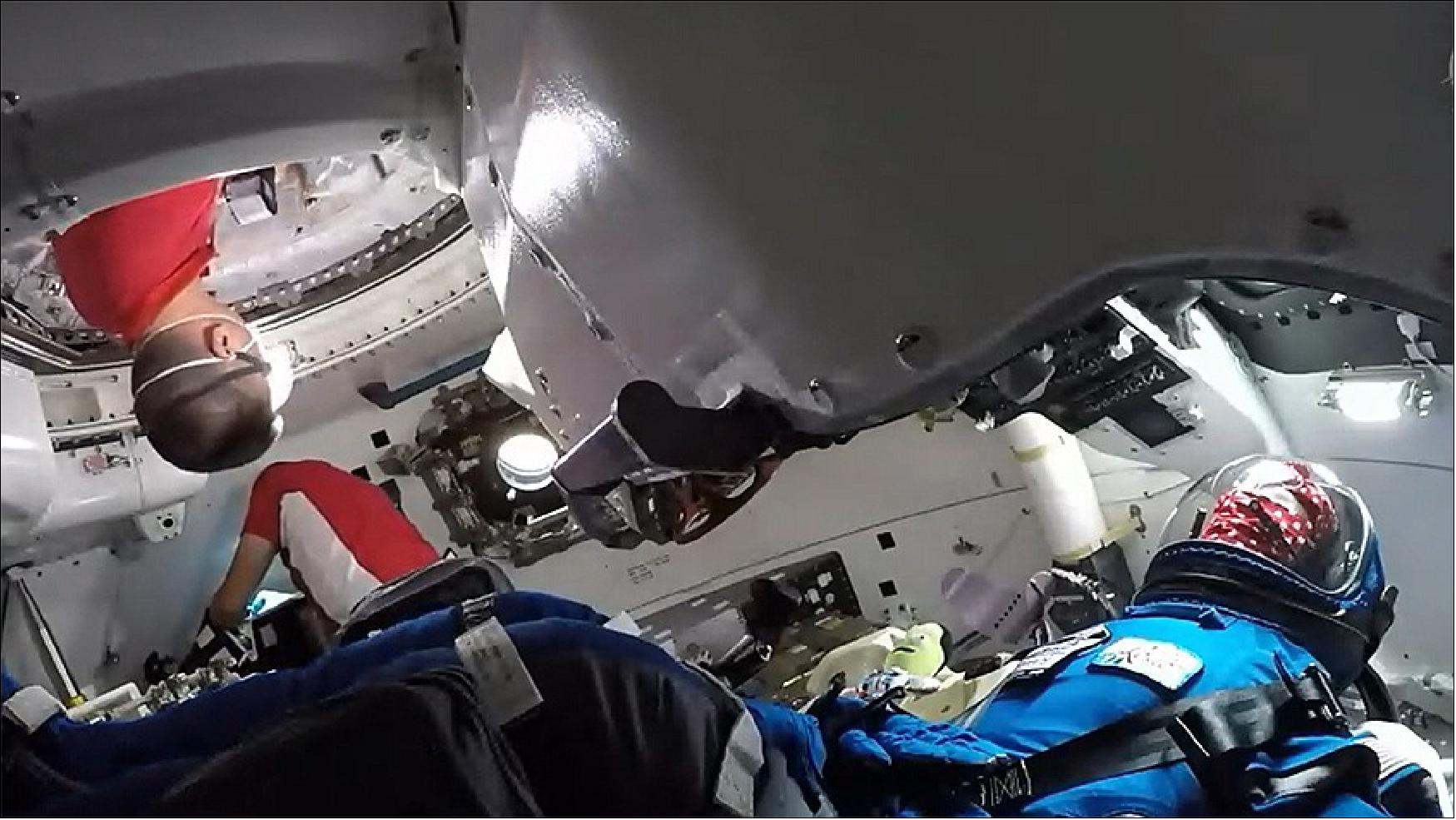
- Starliner launched on a United Launch Alliance Atlas V rocket on a flight test to the International Space Station at 6:54 p.m. on Thursday, May 19, from Space Launch Complex-41 at Cape Canaveral Space Force Station in Florida. The uncrewed spacecraft successfully docked to the space station’s Harmony module at 8:28 p.m. EDT Friday, May 20.
- For the flight test, Starliner is carrying about 500 pounds of NASA cargo and crew supplies and more than 300 pounds of Boeing cargo to the International Space Station. Following certification, NASA missions aboard Starliner will carry up to four crew members to the station, enabling the continued expansion of the crew and increasing the amount of science and research that can be performed aboard the orbiting laboratory.
- The uncrewed flight test is designed to test the end-to-end capabilities of the crew-capable system as part of NASA’s Commercial Crew Program. OFT-2 will provide valuable data toward NASA certifying Boeing’s crew transportation system for regular flights with astronauts to and from the space station.
- Starliner is scheduled to depart the space station Wednesday, May 25, when it will undock and return to Earth, with a desert landing in the western U.S. The spacecraft will return with more than 600 pounds of cargo, including Nitrogen Oxygen Recharge System reusable tanks that provide breathable air to station crew members. The tanks will be refurbished on Earth and sent back to station on a future flight.
• May 20, 2022: Boeing’s CST-100 Starliner spacecraft successfully docked with the International Space Station May 20, a little more than 24 hours after its launch. 12)
- The spacecraft docked with the forward docking port on the Harmony module of the station at 8:28 p.m. EDT. Controllers reported a hard docking securing the spacecraft to the station about 20 minutes later, although hatches separating the spacecraft from the station won’t open until around 11:45 EDT May 21 (15:45 GMT).
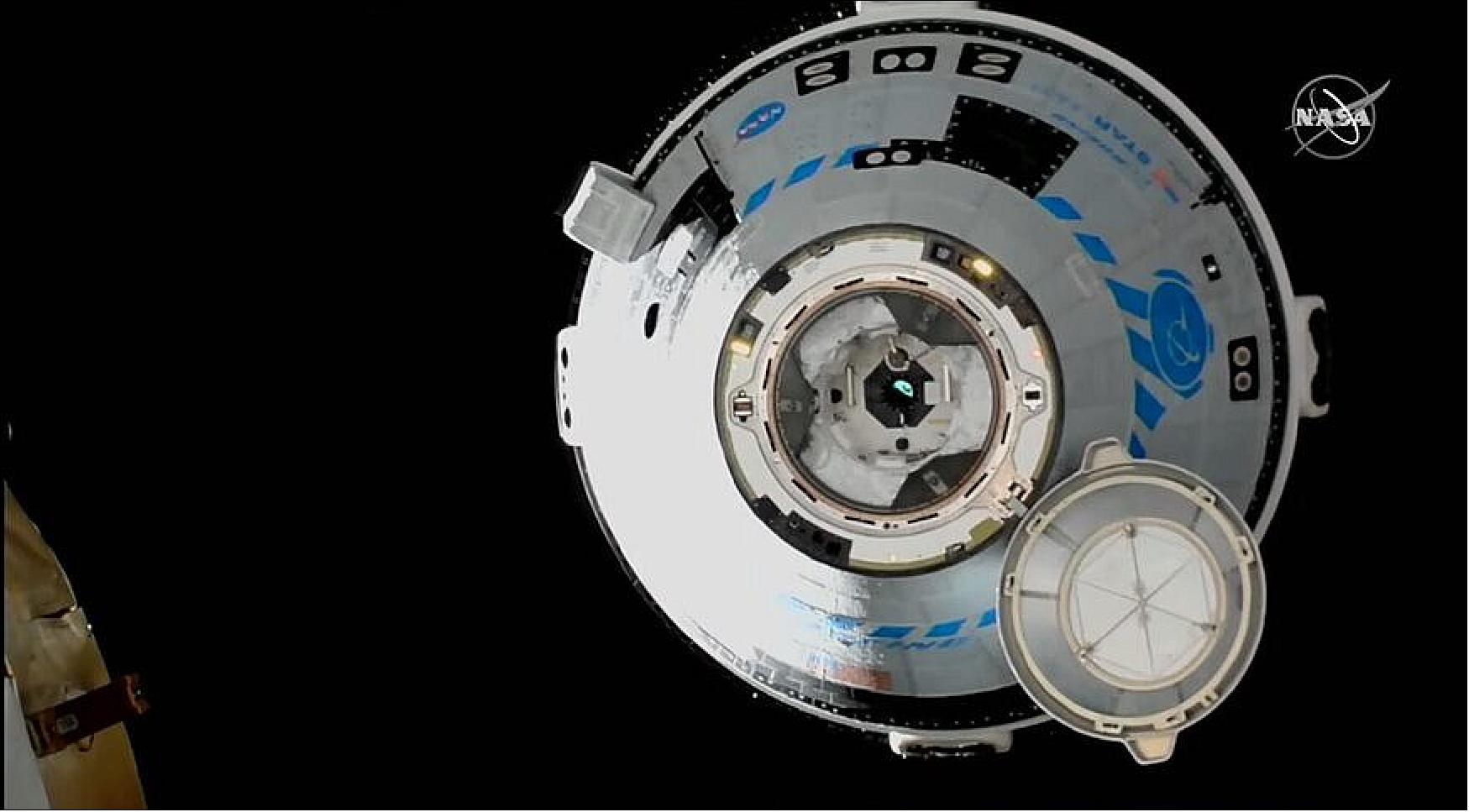
- The docking took place more than an hour later than the original schedule as controllers worked through several minor issues. That included the spacecraft’s docking ring, which needed to be retracted and extended again before the spacecraft could make its final approach.
- “To the joint Boeing and NASA team, the crew of Expedition 67 would like to offer our congratulations on this momentous occasion,” NASA astronaut Bob Hines, currently on the station, said after the docking was confirmed. “Today marks a great milestone towards providing additional commercial access to low Earth orbit, sustaining the ISS and enabling NASA’s goal of returning humans to the moon and eventually to Mars.”
- “This was a really critical demonstration mission,” Kathy Lueders, NASA associate administrator for space operations, said in a briefing an hour after docking. “Seeing that vehicle docked now to the ISS is just phenomenal.”
- Neither NASA nor Boeing provided updates about the status of the Orbital Flight Test (OFT-2) mission for more than 17 hours after a postlaunch briefing May 19, an unusual silence that raised concerns that there was a problem with the spacecraft. A Boeing spokesperson told SpaceNews that the company would provide an update about the mission “in a bit” but the company did not release that update until more than three hours later.
- In that update, Boeing confirmed that the spacecraft was generally in good condition, having conducted several tests as planned. One issue was “off-nominal behavior” of a thermal cooling loop on the spacecraft, but the company said the system was still maintaining stable temperatures.
- “The ground team did a great job of managing those loops,” said Steve Stich, NASA commercial crew program manager, at the post-docking briefing. He said some moisture may have gotten into the coolant loops that froze out and clogged a filter, causing a pressure rise in the loop. Controllers were able to manage the temperature of those coolant loops, and there was plenty of margin in the system.
- The other issue was the failure of 2 of 12 aft-facing Orbital Maneuvering and Attitude Control (OMAC) thrusters during the spacecraft’s orbit insertion burn shortly after launch. In the statement, Boeing said a drop in chamber pressure likely caused the thrusters to shut down.
- Mark Nappi, Boeing vice president and commercial crew program manager, said engineers developed a fault three and identified “three or so” plausible causes, which he did not identify, later suggesting the two thrusters may have failed for different reasons. “We may never know what the real cause of what this is because we don’t get this vehicle back,” he said. The thrusters are located in the service module, which is jettisoned before reentry and burns up in the atmosphere.
- Other OMAC thrusters continued to work well, performing several maneuvers as the spacecraft approached the station before smaller reaction control system (RSC) thrusters took over for the final approach. The OMAC thrusters will not be used again until the spacecraft’s deorbit burn at the end of the mission.
- In addition to the two OMAC thruster failures, two RCS thrusters also shut down during the approach to the station after suffering a drop in chamber pressure. “I don’t think we know quite yet what happened to those thrusters, but the vehicle has plenty of redundancy,” Stich said, including for undocking and landing.
- Starliner is expected to remain at the station until at least May 25. Stich said the earliest undocking opportunity would set up a landing at White Sands Space Harbor in New Mexico at 6:46 p.m. Eastern that day, weather permitting. “We’re not in any hurry to come back. We want to learn as much from this vehicle as we can while it’s on orbit.”
• May 19, 2022: Boeing’s CST-100 Starliner is in orbit, heading for the International Space Station following launch Thursday of the next-generation spacecraft on a United Launch Alliance (ULA) Atlas V rocket on a mission designed to test the end-to-end capabilities of the crew-capable system as part of NASA’s Commercial Crew Program. 13)
- Starliner lifted off on NASA’s Boeing Orbital Flight Test-2 (OFT-2) at 6:54 p.m. EDT on 19 May 2022 (22:54 GMT) from Space Launch Complex-41 at Cape Canaveral Space Force Station in Florida. Following an orbital insertion burn 31 minutes later, Starliner was on its way for a rendezvous and docking with the space station.
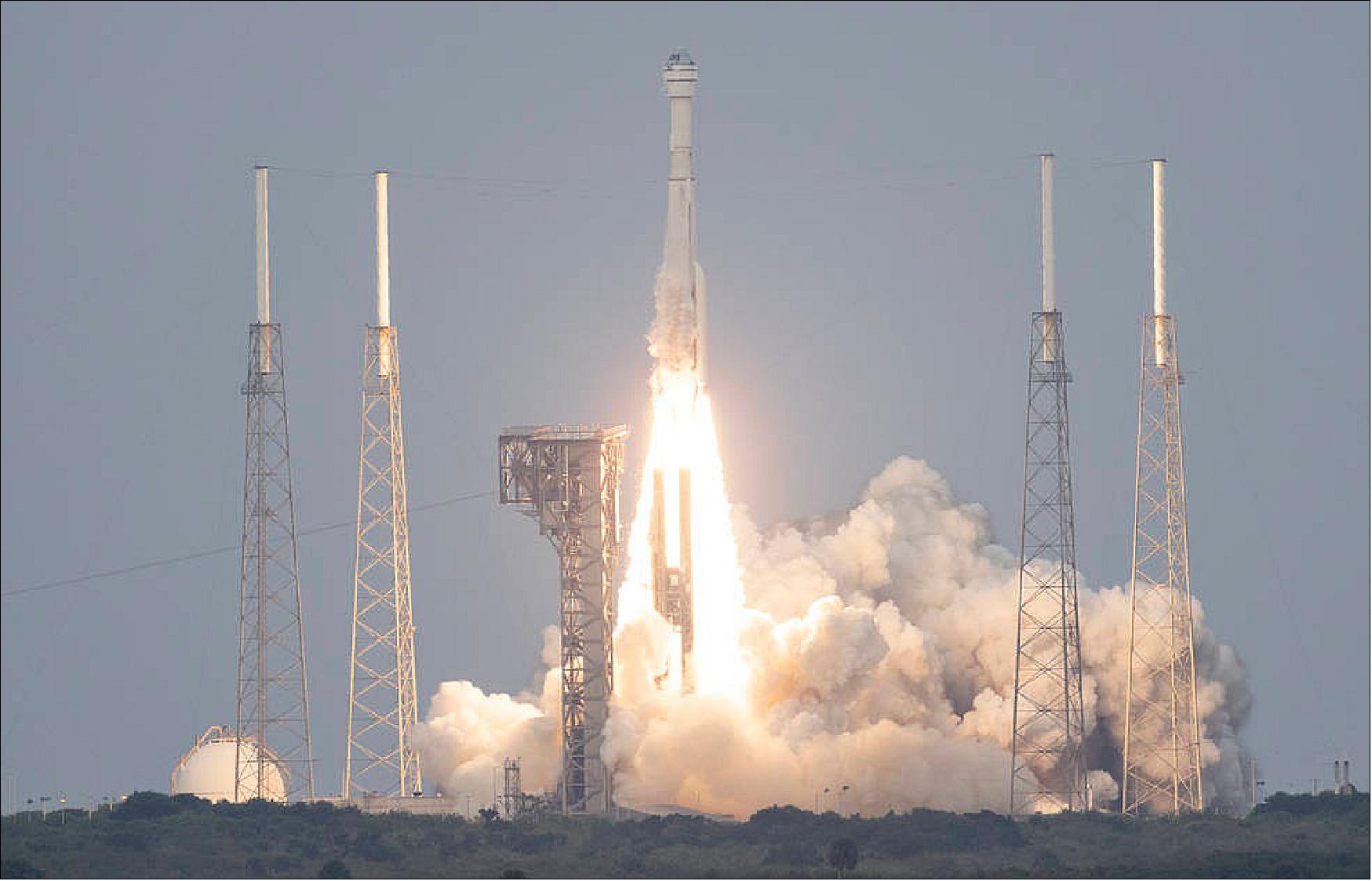
- “I am so proud of the NASA, Boeing and United Launch Alliance teams who have worked so hard to see Starliner on its way to the International Space Station,” said NASA Administrator Bill Nelson. “Through adversity, our teams have continued to innovate for the benefit of our nation and all of humanity. I look forward to a successful end-to-end test of the Starliner spacecraft, which will help enable missions with astronauts aboard.”
- Launch and orbital insertion are major milestones for the company’s second uncrewed flight, bringing the U.S. closer to having two independent crew systems flying missions to and from the space station.
- Starliner is scheduled to dock to the forward port of the station’s Harmony module about 7:10 p.m. Friday, May 20. After a successful docking, the crew of Expedition 67 will open Starliner’s hatch about 11:45 a.m. Saturday, May 21. Coverage of docking and hatch opening will air live on NASA Television, the NASA app, and the agency’s website.
- “I am incredibly grateful to our NASA, Boeing, and United Launch Alliance teams that have demonstrated persistence, resolve, and dedication to ensuring we were ready for launch today and for this flight test,” said Kathryn Lueders, NASA associate administrator for space operations at NASA Headquarters in Washington. “We have learned so much as we’ve worked together to prepare for this mission, and we look forward to watching the spacecraft arrive at the space station for the first time and continuing to learn and improve as we prepare to fly our astronauts on Starliner.”
- For the flight test, Starliner is carrying about 500 pounds of NASA cargo and crew supplies and more than 300 pounds of Boeing cargo to the International Space Station. Following certification, NASA missions aboard Starliner will carry up to four crew members to the station, enabling the continued expansion of the crew and increasing the amount of science and research that can be performed aboard the orbiting laboratory.
- OFT-2 will provide valuable data toward NASA certifying Boeing’s crew transportation system for regular flights with astronauts to and from the space station.
- “We’ve learned a lot about the capability of our spacecraft and the resilience of our team since the first Starliner launch,” said Mark Nappi, vice president and program manager, Boeing Commercial Crew Program. “We still have a lot of operational testing ahead as we prepare to rendezvous with the space station, but we’re ready to demonstrate the system we’ve worked so hard on is capable of carrying astronauts to space.”
- ULA controlled the launch of the Atlas V rocket from its Atlas Spaceflight Operations Center in Cape Canaveral. As Starliner ascended into space, Boeing commanded the spacecraft from its mission control center at NASA’s Kennedy Space Center in Florida. Boeing and ULA teams also provided support to controllers from Kennedy Space Center and Colorado, respectively, throughout the countdown to launch. NASA teams will monitor space station operations throughout the flight from Mission Control Center at the agency’s Johnson Space Center in Houston.
- “We are proud of our partnership role with Boeing in NASA’s Commercial Crew Program and want to thank our mission partners as this is truly a collective accomplishment,” said Tory Bruno, president and CEO, United Launch Alliance. “The successful launch today marks the first critical step toward the future of humans spaceflight onboard an Atlas V and we look forward to the remainder of the mission and to safely flying astronauts in the future.”
- Starliner is scheduled to depart the space station Wednesday, May 25, when it will undock and return to Earth, with a desert landing in the western U.S. The spacecraft will return with more than 600 pounds of cargo, including Nitrogen Oxygen Recharge System reusable tanks that provide breathable air to station crew members. The tanks will be refurbished on Earth and sent back to station on a future flight.
• May 16, 2022: NASA and Boeing are taking another major step on the path to 'regular' human spaceflight to the International Space Station using American rockets to launch spacecraft from American soil with the second uncrewed test flight of a commercial crew spacecraft. 14)
- NASA’s Boeing Orbital Flight Test-2 (OFT-2) is targeting launch of the CST-100 Starliner spacecraft on a United Launch Alliance Atlas V rocket at 6:54 p.m. EDT Thursday, May 19, from Space Launch Complex-41 on Cape Canaveral Space Force Station in Florida. Starliner is expected to arrive at the space station for docking about 24 hours later with more than 800 pounds of cargo, including about 500 pounds of NASA cargo and crew supplies.
- OFT-2 will test the end-to-end capabilities of Starliner from launch to docking, atmospheric re-entry, and a desert landing in the western United States. OFT-2 will provide valuable data that will help NASA certify Boeing’s crew transportation system to carry astronauts to and from the space station.
- Though no crew will be onboard the spacecraft for OFT-2, the Starliner commander’s seat will be occupied by Rosie the Rocketeer, the company’s anthropometric test device. During OFT-1, Rosie was outfitted with 15 sensors to collect data on what astronauts will experience during flights on Starliner. For OFT-2, spacecraft data capture ports previously connected to Rosie’s 15 sensors will be used to collect data from sensors placed along the seat pallet, which is the infrastructure that holds all the crew seats in place.
- During Starliner’s approach to the space station, NASA and Boeing will verify data links and command capabilities by the station crew, including a hold during approach commanded from the station by NASA astronaut Kjell Lindgren aboard station. Starliner also will demonstrate its ability to perform an automated retreat in the event an issue arises during approach.
- Starliner’s vision-based navigation system will be tested as it autonomously docks with the space station about 7:10 p.m. Friday, May 20, or about 24 hours after launch.
- After a successful docking, Starliner will spend five to 10 days aboard the orbiting laboratory before returning to Earth in the western United States. The spacecraft will return with nearly 600 pounds of cargo, including reusable Nitrogen Oxygen Recharge System tanks that provide breathable air to station crew members.
- OFT-2 is the second orbital flight for the CST-100 Starliner, and the first for the second crew module in the Starliner fleet. Boeing is flying this second orbital test to prove the Starliner system meets NASA’s requirements, including docking to the space station.
- OFT-2 will build on the mission objectives achieved during Starliner’s initial flight test, including:
a) In-orbit operation of the avionics, docking system, communications and telemetry systems, environmental control systems, solar arrays and electrical power systems and propulsion systems;
b) Performance of the guidance, navigation & control systems of the Starliner and Atlas V through ascent, on-orbit, and entry;
c) Acoustic and vibration levels, and loads across the Starliner exterior and interior;
d) Launch escape trigger monitoring; and
e) Performance of the Starliner system end-to-end mission operations.
- OFT-2 also will test the changes and improvements made to Starliner, and prove the system is ready to fly astronauts. NASA and Boeing engineers, technicians and flight control teams have all been working together to get Starliner back to space safely and efficiently for OFT-2. Following a successful flight test and subsequent data reviews, NASA and Boeing will set a target launch date for the Crew Flight Test (CFT) with astronauts on board.
- NASA’s Commercial Crew Program has delivered on its goal of safe, reliable, and cost-effective transportation to and from the International Space Station from the United States through a partnership with American private industry. This partnership is changing the arc of human spaceflight history by opening access to low-Earth orbit and the space station to more people, more science, and more commercial opportunities. The space station remains the springboard to NASA's next great leap in space exploration, including future missions to the Moon and, eventually, to Mars.
• May 3, 2022: Boeing's Starliner spacecraft may finally get off the ground for its second flight following an issue with the craft's propulsion system. 15)
- The capsule, designed to ferry astronauts to and from the International Space Station, is set to launch on its second uncrewed test flight on May 19, company officials confirmed during a teleconference on Tuesday.
- The mission, Orbital Flight Test-2 (OFT2), is part of NASA's Commercial Crew Program, in this case with the agency contracting Boeing and SpaceX to transport astronauts to the ISS.
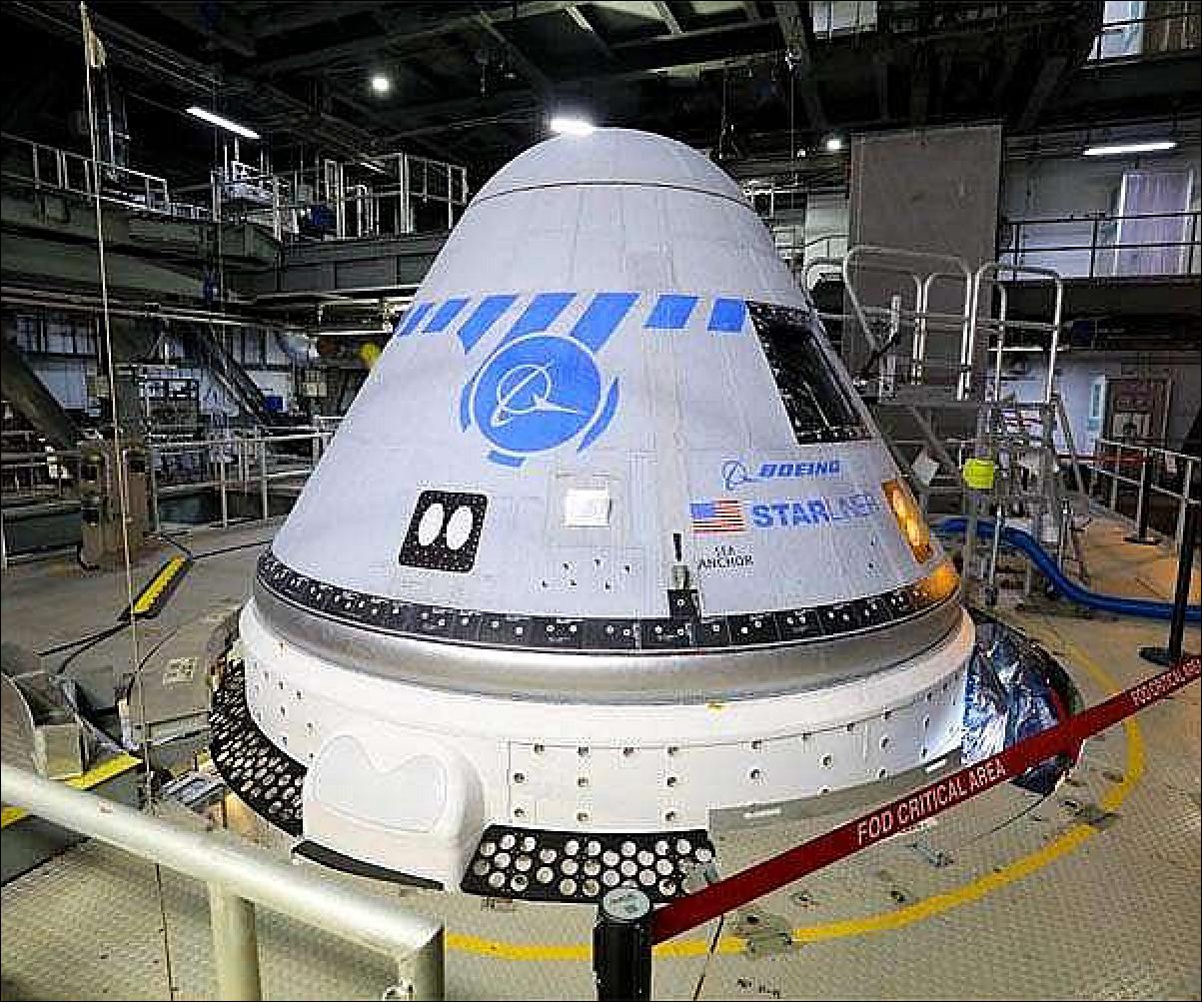
- The test was originally slated to take place last summer, but was canceled after engineers discovered 13 valves in the craft's propulsion system that were stuck in the closed position.
- Following extensive work and troubleshooting both at the launch pad and in the factory, Boeing determined that the valves were sealed shut due to corrosion from moisture interacting with an oxidizer, company officials said Tuesday during a phone briefing with reporters.
- Once Boeing got the vehicle back to its factory and took the valves apart, engineers were able to determine that a mixture of nitrogen tetroxide, or NTO, which is used as an oxidizer in rocket fuel, and ambient moisture interacted with the aluminum covering on the valves.
- "In order to mitigate corrosion and reduce moisture, going forward we will load the NTO later [in the fueling process] and cycle the valves every few days," Michelle Parker, vice president and deputy general manager for Boeing Space and Launch, said during the briefing.
- "We didn't find any other issues [with Starliner] when we were investigating the valve issue. Nothing was changed with the valves themselves, except for sealing a potential ambient moisture path in an electrical connector," Parker said.
- Based on data from the May 19 test flight, a crewed test flight could happen by the end of the year, Mark Nappi, vice president and manager of the Boeing commercial crew program, said during the briefing.
- That test would include a trio of astronauts — Butch Wilmore, Micke Fincke and a yet to be named mission specialist.
- Once Starliner has proven it can safely launch, dock itself and land, the spacecraft could begin regular crewed flights to the ISS, joining SpaceX in NASA's commercial crew program.
- Both SpaceX's Crew Dragon and Boeing's Starliner are fully autonomous and designed to dock themselves to the space station.
- Since there will not be a crew on board this flight, the astronauts on the space station will have the capability to remote pilot the craft if necessary as its docks to the ISS. If necessary, however, the spacecraft can also be controlled by folks on the ground.
- According to NASA's ISS program manager, Joel Montalbano, the agency's international partners — including Russia — have given Starliner the go ahead to dock with the orbital outpost, clearing the way for one of the last steps remaining to certify Starliner for human use.
• January 18, 2022: NASA’s safety advisers are calling on the agency to reexamine how it manages human spaceflight programs to reflect the changing relationship with industry and to better run its core exploration effort. 16)
- The central theme of the annual report of the Aerospace Safety Advisory Panel (ASAP), released Jan. 11, was a need to reexamine the roles and responsibilities of NASA as human spaceflight programs are increasingly managed by industry rather than NASA itself, as was the case for most of the agency’s history.
- “If these trends continue, which seems likely, the Panel believes it is crucial for NASA to strategically evaluate the path ahead and determine the future shape of the organization,” the report states. “Once the Agency has clarified a vision and strategy, it should then make the decisions, and take the necessary actions, to enable it to accomplish the required transformation.”
- The panel argued that this was time to address those issues as the agency was at an “inflection point” given both growing commercial capabilities and roles and the agency’s own long-term plans for human missions to the moon and Mars that need to fit within limited budgets. “Consequently, the Agency will need to operate differently—from strategic planning and how it approaches program management, to workforce development, facility maintenance, acquisition strategies, contract types, and partnerships,” it wrote.
- That transition is within the mandate of ASAP because of the implications such changes have on human spaceflight safety, the panel argued in the report. “The Panel believes that NASA’s vision for the future, and a clear definition of how it will evaluate and make decisions related to risk (in addition to how it will manage and execute programs), are extremely important factors in ensuring human space flight safety.”
- The shift to commercial crew transportation has created some specific issues in the last year mentioned in the report. The panel cited a “concerning dissonance” between NASA and SpaceX during preparations for the Crew-1 landing last May. The two organizations “differed in their understanding of the level of risk to be incurred” regarding a nighttime landing of the Crew Dragon spacecraft, with NASA initially preferring a daytime landing as the lowest risk option. SpaceX argued that a nighttime landing was acceptable and offered better sea state conditions than the proposed daytime landing. The report stated that “last-minute communications had been necessary to ensure NASA approved the plans for the night landing.”
- There was also a difference of opinion between NASA and Boeing involving the risk of stuck propulsion valves on the company’s CST-100 Starliner that delayed an uncrewed test flight last summer. Boeing evaluated the risk as low, the panel said, while NASA considered it moderate during a flight readiness review. That review, the panel concluded, “revealed NASA and Boeing do not share a common understanding of how to assess and characterize risk.”
- The language of the report suggested the issue came up in the flight readiness review held several days before the scheduled launch, while the problem itself was reported only after the launch was scrubbed a few hours before the scheduled liftoff. However, a company spokesman said that the problem was discovered after the flight readiness review, and also played down the difference in opinions highlighted in the ASAP report.
- “It is not uncommon to have differences in the risk scoring on the magnitude of various technical issues being addressed at the review. This is because we use different rubrics, or scoring systems, for our risk assessments,” Boeing said in a statement. “Using different assessments can be healthy for the program as it allows management to better understand the total level of risk as the scoring systems look through different lenses to ultimately drive down risk and increase crew safety.”
- The panel also took issue with the “disaggregated” way NASA’s exploration efforts are organized. That structure treats the Space Launch System, Orion spacecraft and Exploration Ground Systems as separate programs, which the panel attributes to the uncertain direction of the agency’s exploration programs after the cancellation of the Constellation program more than a decade ago.
- “In essence, it appears that the cancellation of the Constellation program has led to a cautious stance among NASA leaders driven by the assumption that having an Apollo-like program now is a problematic political optic, and like Constellation, a possible target for cancellation by a future Administration,” the panel wrote. “In effect, NASA has accepted the disaggregated program structure as normal, and is now propagating this structure as a preferred business and risk management model, even though it is essentially an untried approach for an integrated systems engineering effort of this magnitude and complexity.”
- Among the panel’s recommendations was to create an integrated Artemis program led by a single manager “endowed with authority, responsibility, and accountability” along with a bottoms-up approach to systems engineering and integration as well as risk management. NASA sometimes refers to an “Artemis program” today, the panel noted, but without the formal program architecture that risks “confusing both employees and contractors about who is ultimately responsible and accountable.”
- The panel recommended NASA establish a “board of directors” consisting of senior NASA Headquarters officials as well as its center directors. The members would examine agency issues outside of their perspectives as heads of programs or centers. It also recommended a strategic vision for the future of space exploration and operations that would look out at least 20 years, including roles for commercial and international partners and its workforce requirements.
- “NASA is no longer the sole driver or customer for human space flight capabilities and related technology, nor is it the sole organization creating demand,” the panel stated. “Consequently, it is imperative for NASA leaders to establish a clear vision of the future and an understanding of the Agency’s purpose to anchor its decisions today and tomorrow.”
• October 19,2021: NASA continues to stand behind Boeing as the company works to resolve a valve problem with its CST-100 Starliner that will push back operational missions of the commercial crew vehicle into 2023. 17)
- NASA and Boeing officials provided an update Oct. 19 on the investigation into the stuck valves in the Starliner’s propulsion system that scrubbed a launch attempt in early August. That eventually forced the company to remove the spacecraft from its Atlas 5 launch vehicle and postpone the launch of the Orbital Flight Test (OFT2) indefinitely.
- Boeing officials largely recapped their recent assessment of the valve issue, including their belief the leading cause was that nitrogen tetroxide (NTO) oxidizer, permeating Teflon seals in the valves, interacted with moisture on the other side. That created nitric acid that corroded the valves and caused them to stick in the closed position.
- Technicians have removed two of the valves from the spacecraft and are working on removing a third valve. Those valves will go to NASA’s Marshall Space Flight Center for detailed studies, including CT scans. Other valves like those on Starliner are being tested at NASA’s White Sands Testing Facility in New Mexico, which has experience dealing with hypergolic propellants.
- The moisture that interacted with the NTO was likely “normal environment humidity” in Florida, said Michelle Parker, vice president and chief engineer of space and launch engineering at Boeing, in a call with reporters.
- Another factor may have been the length of time the NTO was in the spacecraft: 46 days, versus 35 days on the original OFT mission, which had no valve problems. However, the vehicle was designed to store NTO for up to 60 days before launch. “We thought we’d be fine,” said John Vollmer, vice president and program manager of the commercial crew program at Boeing.
- While the investigation is ongoing, Boeing is already looking into potential solutions. “The basic design is sound,” Vollmer said of the valves. “Are there some slight modifications we need to make to the design? Is there additional purging that we need to do to make sure we don’t get moisture?”
- Technicians have added desiccant to vent holes near the valves to keep moisture from reaching the valves. Parker said Boeing is also considering adding heaters to the valves that would free up any corrosion products that do form on the valves. A design review for that is scheduled for the coming days.
- Steve Stich, NASA commercial crew program manager, said tests at White Sands will expose the valves to the same conditions they saw in Florida, including high humidity. “We’ll try to recreate the exact scenario a valve went through,” he said, measuring how the corrosion grows and how difficult it becomes to open and close the valve.
- As in a recent interview, Boeing executives said they were looking for launch opportunities in the first half of 2022 for OFT-2. An exact date will depend on the progress made in the investigation and repairs to the spacecraft, as well as launch vehicle availability and when docking ports on the International Space Station will be open.
- If OFT-2 does fly by the middle of next year, it’s possible that Boeing could follow up with the first crewed flight, the Crew Flight Test (CFT), before the end of next year. “We like to see six months between flights,” Vollmer said, to cover the turnaround time between missions. “We are aggressively working the CFT vehicle in parallel” to the investigation.
- The Starliner problems put Boeing far behind SpaceX, the other commercial crew company. SpaceX is set to launch its third operational Crew Dragon mission for NASA, Crew-3, Oct. 31. It will fly the Crew-4 and Crew-5 missions in 2022.
- The series of consecutive SpaceX missions means that company is approaching the end of its original contract with NASA, which included six operational or “post-certification” missions. With the station expected to operate through the end of the decade, Stich said that NASA was starting the process to add additional flights to those contracts.
- Once Boeing does complete its test flights and is certified for crew rotation missions, he said NASA will likely alternate between the two companies. “When we get into the long-term rotations, we would like to see SpaceX fly once a year and then Boeing fly one a year as well,” he said.
- Stich also reiterated his confidence that Starliner will get past its problems. “We have every confidence that Boeing will be flying crew soon,” he said. “I have no reason to believe that Boeing won’t be successful.”
- Boeing, which took a $410 million charge against earnings in January 2020 to pay for OFT-2, has not disclosed how much it’s spent on the mission, including the repairs. Vollmer confirmed that Boeing is covering the full cost of the work to investigate and repair Starliner. “NASA would not bear any responsibility for those costs,” he said.
- He declined to say how this work affected Boeing’s ability to make any profit on the program. “I will say we are 100% committed to fulfilling our contract with the government. We intend to do that.”
• October 9, 2021: NASA and Boeing are targeting the first half of 2022 to launch the rescheduled test flight of the CST-100 Starliner commercial crew vehicle as engineers continue to investigate a valve problem that postponed the mission two months ago. 18)
- In an Oct. 8 statement, NASA said engineers had managed to free all but one of 13 stuck propellant valves in the Starliner spacecraft. Those stuck valves forced the postponement of Boeing’s uncrewed Orbital Flight Test (OFT) 2 mission in early August. The one remaining valve still stuck closed is kept in that state deliberately “to preserve forensics for direct root cause analysis.”
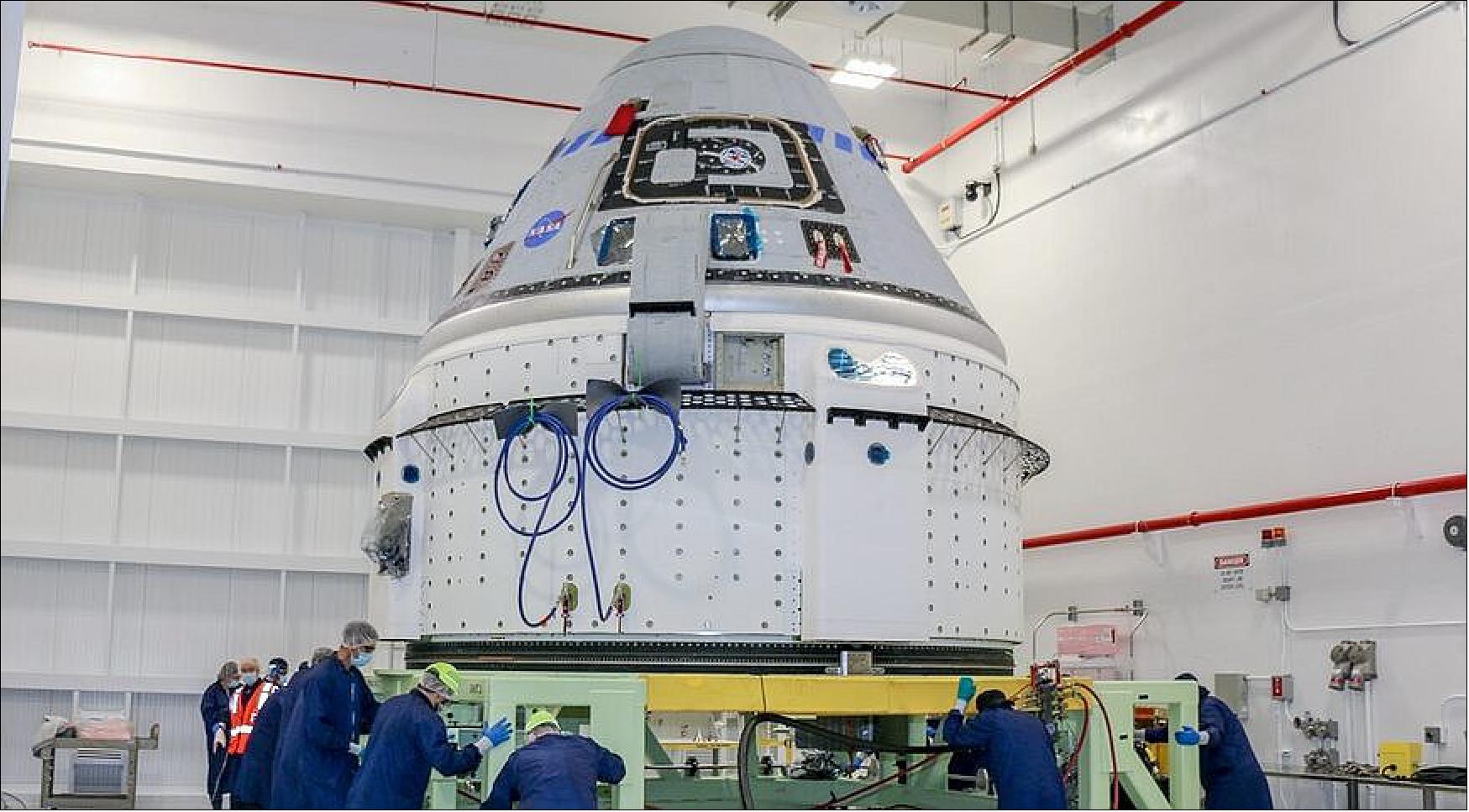
- The analysis has yet to determine the root cause for the stuck valves, but NASA stated Boeing believed the most probable cause was interaction between moisture and nitrogen tetroxide propellant, a cause Boeing officials offered in August. The source of the moisture was not included in the statement, which added that “although some verification work remains underway, our confidence is high enough that we are commencing corrective and preventive actions.”
- As part of those efforts, Boeing technicians partially disassembled three valves last month and will remove three others in the coming weeks for inspection. Those efforts will determine how Boeing will prepare the spacecraft for a new launch attempt, with options ranging from “minor refurbishment” of components in the Starliner’s service module to replacing the service module entirely.
- NASA confirmed in the statement that the next OFT-2 launch attempt will not be this year. “The team currently is working toward opportunities in the first half of 2022 pending hardware readiness, the rocket manifest, and space station availability,” the agency said.
- It had already been clear that OFT-2 was unlikely to fly this year because of both the ongoing investigation and other missions to the station. “The timeline and the manifest through the end of the year is pretty tight right now,” said Kathy Lueders, NASA associate administrator for space operations, at a Sept. 21 briefing. “My gut is that it would probably be more likely to be next year, but we’re still working through that timeline.”
- Steve Stich, NASA commercial crew program manager, offered the same assessment during an Oct. 6 briefing about the upcoming SpaceX Crew-3 commercial crew mission. “There’s really not an opportunity for OFT-2 to fly this year,” he said. “From a station perspective, it would be some time early next year where a window would open up for OFT-2.”
- Starliner would dock at one of two ports, one of which will be occupied by a Crew Dragon spacecraft. The other port will be occupied by a cargo Dragon spacecraft starting in early December, likely until early January. A commercial Crew Dragon spacecraft, flying the Ax-1 mission for Axiom Space, is scheduled to launch Feb. 21 and spend a week docked to the station using that other port.
- Stich said at the Oct. 6 briefing it was too soon to narrow down a launch date for OFT-2, given the uncertainties about vehicle readiness. “We really need to get to a root cause on the valve issue on the service module,” he said. “Once we do that, we’ll have a little more certainty on the path forward of when OFT-2 is, and then from that, where CFT is.” CFT, or Crew Flight Test, will be a crewed test flight with up to three NASA astronauts on board that follows OFT-2.
- The delays mean that more than two years will elapse between the original OFT mission in December 2019, which suffered several software and communications problems that truncated the flight, and OFT-2. SpaceX, meanwhile, has conducted since OFT the Demo-2 crewed test flight and the Crew-1 and Crew-2 operational missions. The next NASA Crew Dragon mission, Crew-3, is scheduled for launch Oct. 30, with Crew-4 and Crew-5 planned for 2022.
- At the briefing, NASA defended Boeing despite those extended delays. “We have not lost confidence in the Boeing team. The team is doing an incredible job of working through the root cause on the valve issue,” Stich said. “I have every bit of confidence that they’re going to figure out what the problem is and they’ll rectify it and we’ll get back to flight really soon.”
• October 7, 2021: NASA has reassigned two astronauts from Boeing commercial crew missions to a SpaceX one as the agency addresses delays in the development of the CST-100 Starliner and works out a seat barter agreement with Russia. 19)
- NASA announced Oct. 6 that astronauts Nicole Mann and Josh Cassada would be the commander and pilot, respectively, of the Crew-5 mission of SpaceX’s Crew Dragon, launching to the International Space Station no earlier than the fall of 2022. The other two people flying that mission will be announced later.
- Mann was previously part of the three-person Crew Flight Test (CFT) mission, the first crewed flight of Starliner. Cassada was part of Starliner-1, the first operational Starliner mission that will follow the CFT mission. Neither CFT nor Starliner-1 has firm launch dates because of continued delays in the second uncrewed Starliner mission, Orbital Flight Test 2. The reassignments were first reported by Ars Technica Oct. 5, which at the time did not expect a formal announcement for weeks or months.
- In a previously scheduled briefing about the upcoming SpaceX Crew-3 mission Oct. 6, NASA officials said they reassigned Cassada and Mann because they wanted to give the two rookie astronauts flight experience sooner rather than later. “To us, it seemed like the right time,” said Steve Stich, NASA commercial crew program manager. “We really wanted to get Nicole and Josh some experience and get them into space as soon as we can.”
- NASA astronauts Butch Wilmore and Mike Fincke remained assigned to the CFT mission and Suni Williams to Starliner-1. All three are veteran astronauts, and NASA said other astronauts will be added to those missions in the future.
- Also remaining on Starliner-1 is Jeanette Epps, another rookie astronaut who was removed from a Soyuz mission to the ISS in 2018 for reasons the agency declined to disclose at the time. “We’re reevaluating that flight assignment,” Stich said. “Since Starliner-1 is a little further out than CFT we’re in the process of looking at that assignment and see if that would change over time.”
- NASA is hoping that one of the two open seats on Crew-5 will be filled by a Russian cosmonaut. The agency is continuing discussions with Roscosmos on a seat barter agreement to allow NASA and other Western astronauts to fly on Soyuz spacecraft in exchange for Russian cosmonauts flying on commercial crew vehicles. Such “mixed crews” would ensure both astronauts and cosmonauts would be on the station if there is a problem with a Soyuz, Crew Dragon or Starliner spacecraft.
- “We have been working with our Russian partners on what we call a ‘crew swap’ strategy,” said Kathy Lueders, associate administrator for space operations at NASA, at the briefing. “We’ve demonstrated that the Crew Dragon is a capable vehicle going forward, and now it’s just a matter of putting the next layer of government-to-government agreements together to support that.”
- Joel Montalbano, NASA ISS program manager, said he met with Roscosmos officials last week in Moscow about the agreement. “Our target is still for Crew-5 in fall of ’22, to have a cosmonaut on that vehicle,” he said, “and we would have an American on the Soyuz in the same time frame.”
- That would rule out flying a cosmonaut on Crew-4, launching in the spring of 2022. NASA had left open one of the four seats on that mission in the event an agreement could be reached in time. Stich said a backup crew member for Crew-4 will be assigned to fill that seat “at the right time.”
- The next Soyuz crew rotation mission, launching in the spring of 2022, will have three Russian cosmonauts on board. Montalbano said NASA had no plans to acquire a seat on that flight, as it did early this year when it worked out an agreement through a third party, Axiom Space, to buy the seat and fly NASA astronaut Mark Vande Hei in the place of a Russian cosmonaut. Montalbano said the handover between the Crew-3 and Crew-4 missions will be timed “such that we maintain a U.S. presence on board.”
Crew Dragon Updates
- The briefing was primarily about the Crew-3 mission, launching Oct. 30 and sending to the ISS NASA astronauts Raja Chari, Tom Marshburn and Kayla Barron, and ESA astronaut Matthias Maurer.
- The flight will be the first for a new Crew Dragon spacecraft, the third in SpaceX’s fleet. SpaceX has made minor changes to this vehicle based on experience from previous flights, including the Crew-1 mission where, during its return to Earth, debris caused minor damage to one of the drogue parachutes.
- Stich said the issue was with a “minor sleeve” on the drogue intended to protect riser lines on the parachute from abrasion. “We already made a fix to that to enhancing some stitching on this little sleeve,” he said.
- Another issue is with the waste management system on the spacecraft, where a small connection “could be a bit loose,” said Sarah Walker, director of Dragon mission management at SpaceX. “We just rolled in an improvement to make that joint a little tighter.”
- SpaceX is also sharing with NASA data it collected on the Inspiration4 private Crew Dragon mission in September. Stich said that mission is of interest since it flew higher than those to the ISS, exposing the spacecraft to a higher amount of micrometeroids and orbital debris. The three-day flight also offered a more robust test of the life support system on the spacecraft.
- In addition to the new Crew Dragon for the Crew-3 mission, SpaceX is building a fourth Crew Dragon that Walker said should be ready in the spring of 2022, perhaps for the Crew-4 mission. There are no plans, she added, to build more Crew Dragon capsules at this time. “Those four Crew Dragon vehicles seem sufficient to meet our manifest, which is thriving.”
• August 13, 2021: A test flight of Boeing’s CST-100 Starliner commercial crew vehicle will be delayed for at least several months to fix a problem with valves on the spacecraft. 20)
- Boeing announced Aug. 13 that it will remove the Starliner spacecraft that was to launch this month on the Orbital Flight Test (OFT) 2 mission from its Atlas 5 rocket and return it to the company’s Commercial Crew and Cargo Processing Facility at the Kennedy Space Center for additional work.
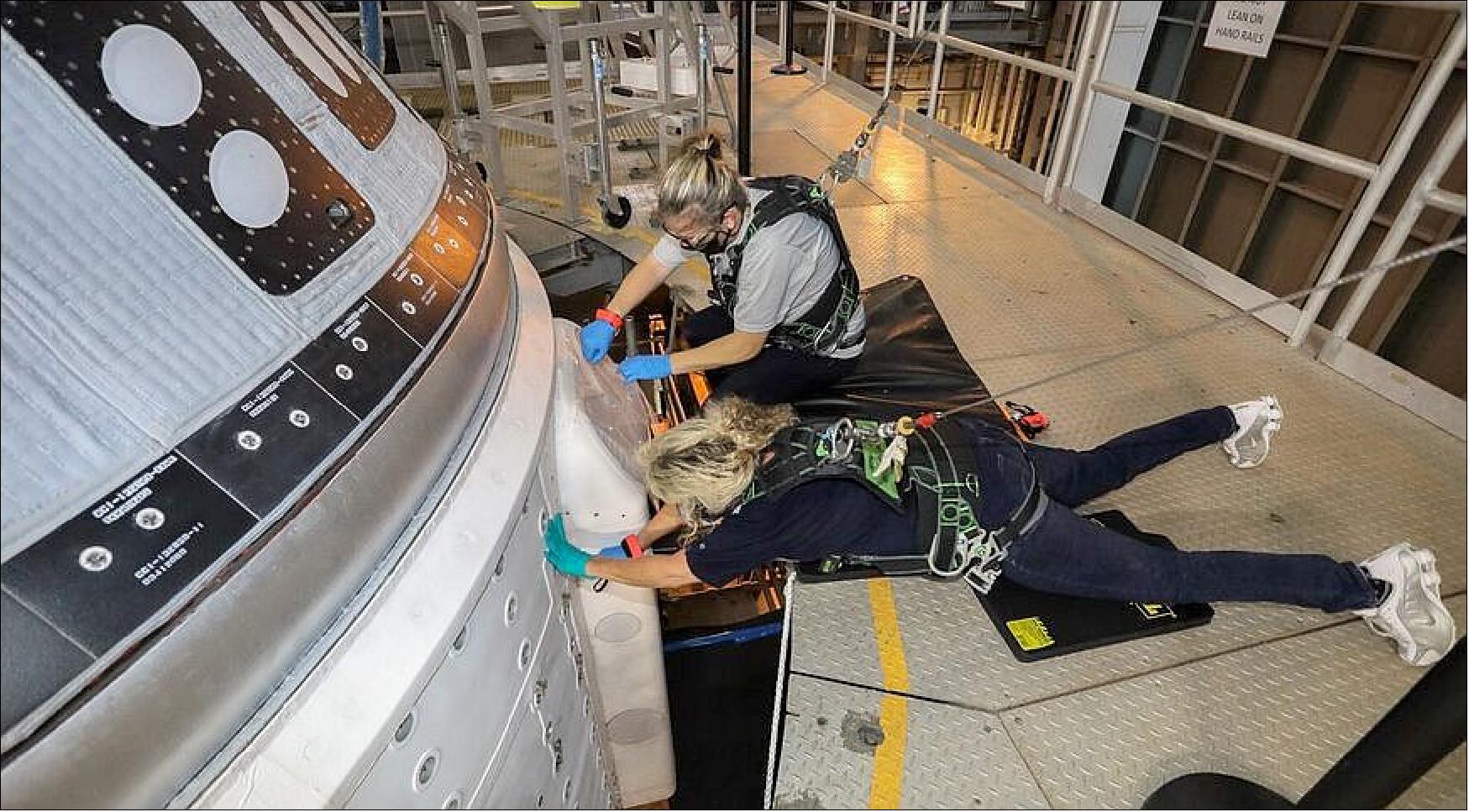
- “This is, obviously, a disappointing day,” Kathy Lueders, NASA associate administrator for human exploration and operations, said in a call with reporters Aug. 13. “This team is going to go figure this out and we will go fly when we are ready.”
- Boeing scrubbed an Aug. 3 launch attempt after discovering problems with what the company later said were 13 valves in the spacecraft’s propulsion system that were unexpectedly closed. After being unable to resolve the problem while the spacecraft was on the pad, Boeing and United Launch Alliance rolled the Atlas 5 back to its Vertical Integration Facility to give technicians access to the spacecraft.
- As of Aug. 12, Boeing said it had fixed 9 of the 13 valves “after the application of electrical and thermal techniques” to open them. Four other valves remained closed and were still being worked on.
- John Vollmer, vice president and program manager of Boeing’s commercial crew program, said on the media call that the leading cause of the valve problem is that nitrogen tetroxide (NTO), the oxidizer used for Starliner’s thrusters, permeated Teflon seals in the valves. That NTO interacted with moisture on the “dry” side of the valve, creating nitric acid. The acid corroded the valves, causing them to stick in the closed position.
- He said the nine valves they were able to open then worked normally, but the company ran out of options to fix the remaining four valves while still stacked on the Atlas 5. “We made the decision that we were just out of runway and we had to come back to the factory to complete anything else we needed to do,” he said.
- Boeing tested the valves when it fueled the spacecraft about five weeks before rolling out to the launch site in mid-July. “All of them operated perfectly,” Vollmer said. The valves, provided by Aerojet Rocketdyne, are the same as those used on the original OFT mission in December 2019 as well as a pad abort test in November 2019, which did not experience similar problems.
- Vollmer said it’s not certain where the moisture came from, but could have happened during assembly of the spacecraft in the factory or exposure to humid conditions on the pad just before launch. He ruled out water intrusion from a thunderstorm the night before the scheduled launch as a factor, although he said the storm did cause some erroneous sensor readings that took time to sort out.
- Once Starliner is back in the factory, he said engineers will take a deliberate process to study the valve problem, including determining what portions of the spacecraft need to be disassembled to correct the problem. He added it’s too soon to say if all the valves, including those working properly, will need to be replaced.
- The decision to remove Starliner from the Atlas 5 means an extended delay for OFT-2. Even if the problem is quickly solved, Boeing will have to wait until after the mid-October launch of NASA’s Lucy asteroid mission on another Atlas 5 before beginning preparations for another launch. That launch would wait until after the launch of SpaceX’s Crew-3 commercial crew mission, scheduled for the end of October, and the return to Earth of the Crew-2 spacecraft, freeing up the docking port for Starliner.
- “It’s pretty early to speculate on when the flight might end up,” said Steve Stich, NASA commercial crew program manager. “When we get to a point where we understand the cause and the fixes, we will work hard to find that slot and get the vehicle flown as soon as we can.”
- The launch of OFT-2, they acknowledged, could slip into 2022, or more than two years after the original, flawed OFT mission. “It’s probably too early to say whether it’s this year or not,” Vollmer said. “If we could fly this year, it would be fantastic.”
- Boeing said in January 2020 it would fly the OFT-2 mission at its own expense after correcting the software and communications problems found on the first test flight. However, when asked if Boeing would cover the costs of this latest delay, Vollmer declined to confirm it. “I don’t know that I have the complete answer to that,” he said.
- Lueders said she was not frustrated by the extended delay. “You might be hearing us sound a little tired, because teams have been working really hard, but we’re not frustrated,” she said. “I’m a little sad, because I wanted to go fly, but I’m also very proud of the team.”
• August 3, 2021: A problem with Boeing’s CST-100 Starliner commercial crew vehicle scrubbed a launch attempt Aug. 3, pushing back its uncrewed test flight by several days. 21)
- Boeing announced about three hours before the scheduled 1:20 p.m. Eastern liftoff that the launch had been postponed for the day. In a statement a short time later, the company said engineers detected “unexpected valve position indications in the propulsion system” of the spacecraft.
- The problem was originally noticed during checkouts of the spacecraft after lightning in the vicinity of the launch pad at Cape Canaveral Space Force Station the day before. The spacecraft, atop its Atlas 5 rocket, rolled out to the pad early that day. The company didn’t elaborate on the issue or why they scrubbed the launch at that point in the countdown.
- The company had not reported any other issues with the spacecraft during the countdown. Weather remained questionable, though, with a 50% chance of acceptable conditions at liftoff.
- “We’re disappointed with today’s outcome and the need to reschedule our Starliner launch,” John Vollmer, Boeing vice president and program manager of its commercial crew program, said in a statement. “Boeing and NASA teams will take the time they need to ensure the safety and integrity of the spacecraft and the achievement of our mission objectives.”
- Late Aug. 3, NASA and Boeing announced they would not attempt a launch on the next opportunity, Aug. 4. Boeing said engineers had ruled out a number of potential causes, including software, and needed more time to investigate the problem. Crews will roll the rocket back to its vertical integration facility on Aug. 4 to support additional investigation.
- After Aug. 4, the next launch opportunity, based on orbital mechanics, is Aug. 7, but NASA and Boeing did not state when they thought they would be ready to make the next launch attempt.
- The launch was scheduled for July 30, but postponed when the ISS temporarily lost attitude control when thrusters on the Nauka module fired several hours after the module docked with the station July 29.
- Starliner will launch on a mission called Orbital Flight Test (OFT) 2, a rerun of the original OFT mission launched in December 2019. That mission suffered serious software problems after reaching orbit, calling off a docking attempt with the ISS and forcing the spacecraft to land after just two days.
- An independent review in early 2020 made 80 recommendations to correct software issues with Starliner as well as communications problems it experienced during the flight. NASA and Boeing confirmed in prelaunch reviews for OFT-2 that the company had closed out all the recommendations.
- A successful OFT-2 mission would allow NASA and Boeing to proceed with a crewed flight test with three NASA astronauts on board as soon as the end of this year, although industry sources believe a launch in the first half of 2022 is more likely. It would leave Boeing at least a year and a half behind SpaceX, which first launched astronauts on its Crew Dragon spacecraft in May 2020 and is currently in the middle of its second operational mission to the station.
- “It’s extremely important to us that we’re successful on this flight. With all that we’ve done over the past 18 months, we are very confident that we are going to have a good flight,” Vollmer said at a July 22 briefing about the upcoming OFT-2 mission. “It is of paramount importance that we have a successful flight.”
• July 26, 2021: NASA and Boeing are taking another major step on the path to regular human spaceflight launches to the International Space Station on American rockets and spacecraft from American soil with the second uncrewed flight test of Boeing’s CST-100 Starliner as part of the agency’s Commercial Crew Program. 22)
- NASA’s Boeing Orbital Flight Test-2 (OFT-2) is targeting launch of the Starliner spacecraft on a United Launch Alliance Atlas V rocket at 2:53 p.m. EDT Friday, July 30, from Space Launch Complex-41 on Cape Canaveral Space Force Station in Florida. Starliner is expected to arrive at the space station for docking about 24 hours later with more than 400 pounds of NASA cargo and crew supplies.
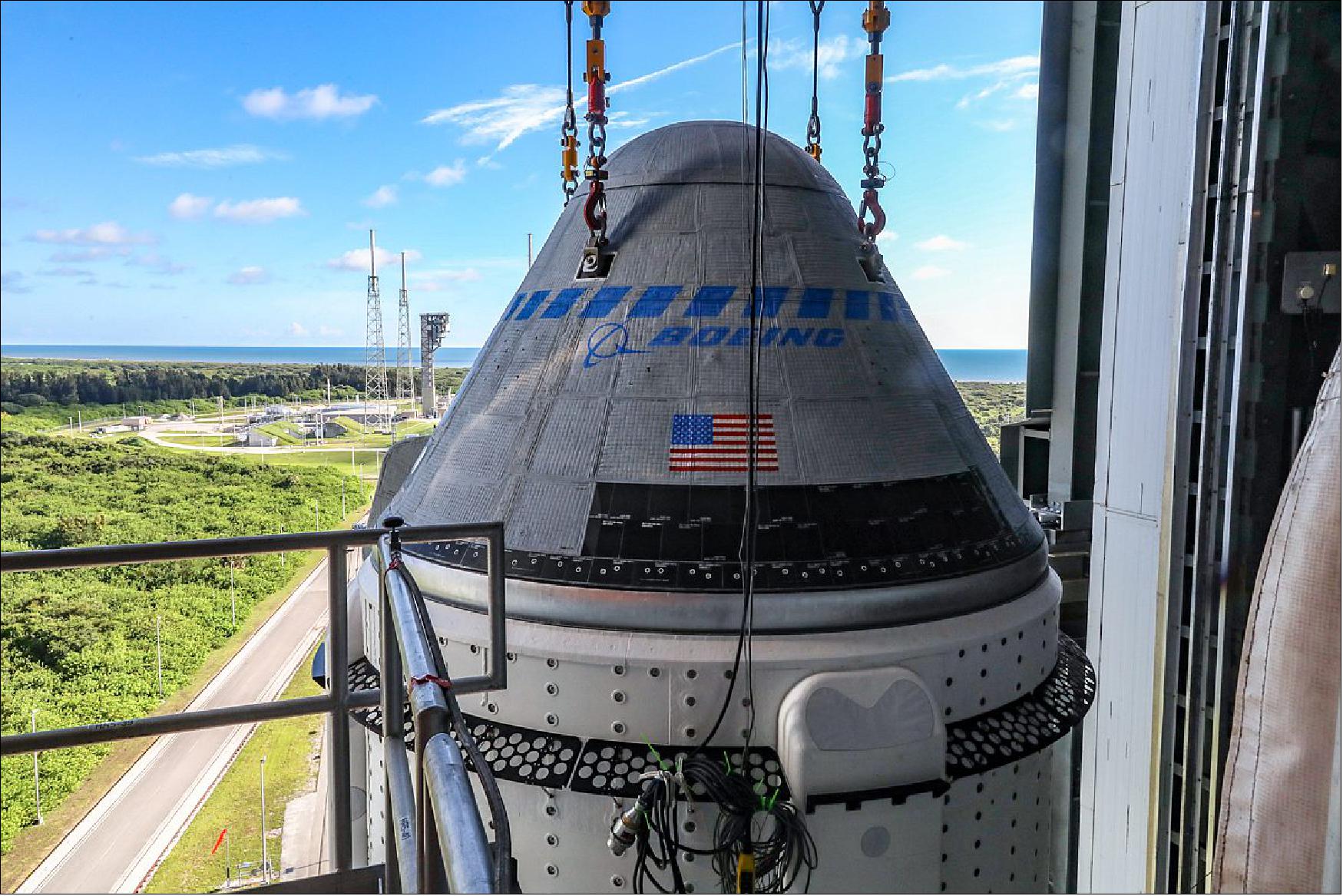
- The mission will test the end-to-end capabilities of Starliner from launch to docking, atmospheric re-entry, and a desert landing in the western United States. OFT-2 will provide valuable data that will help NASA certify Boeing’s crew transportation system to carry astronauts to and from the space station.
- Though no crew will be onboard the spacecraft for OFT-2, the Starliner commander’s seat will be occupied by Rosie the Rocketeer, the Boeing’s anthropometric test device.
- During OFT-1, Rosie was outfitted with 15 sensors to collect data on what astronauts will experience during flights on Starliner. For OFT-2, spacecraft data capture ports previously connected to Rosie’s 15 sensors will be used to collect data from sensors placed along the seat pallet, which is the infrastructure that holds all the crew seats in place.
- During Starliner’s approach to the space station, NASA and Boeing will verify data links and command capabilities by the station crew, including a commanded hold during approach by Japan Aerospace Exploration Agency astronaut and station commander Aki Hoshide. Starliner also will test an automated retreat capability during approach in the event an issue should occur on the docking axis.
- Starliner also will test its vision-based navigation system to autonomously dock with the space station. Docking is scheduled for 3:06 p.m. Saturday, July 31, or about 24 hours after launch.
- After a successful docking, Starliner will spend five to 10 days aboard the orbiting laboratory before returning to Earth in the western United States. The spacecraft will return with more than 550 pounds of cargo, including reusable Nitrogen Oxygen Recharge System (NORS) tanks that provide breathable air to station crew members.
- OFT-2 is the second orbital flight for the CST-100 Starliner, and the first for the second crew module in the Starliner fleet. Boeing is flying this second orbital test to prove the Starliner system meets NASA’s requirements, including docking to the space station.
- OFT-2 will build on the mission objectives achieved during Starliner’s flight test, including verifying:
a) In-orbit operation of the avionics, docking system, communications and telemetry systems, environmental control systems, solar arrays and electrical power systems and propulsion systems;
b) Performance of the guidance, navigation & control systems of the Starliner and Atlas V through ascent, on-orbit, and entry;
c) Acoustic and vibration levels, and loads across the Starliner exterior and interior;
d) Launch escape trigger monitoring;
e) Performance of the Starliner system end-to-end mission operations.
- The OFT-2 mission also will test the changes and improvements made to Starliner, and prove the system is ready to fly astronauts.
- In preparation for OFT-2, NASA and Boeing completed all actions recommended by the joint NASA-Boeing Independent Review Team, which was formed as a result of Starliner’s first test flight in December 2019. The review team’s recommendations included items relating to integrated testing and simulation, processes and operations, software, the crew module communication system, and organization. Boeing implemented all recommendations, including those that were not mandatory, ahead of Starliner’s upcoming flight.
- As long as Starliner’s second uncrewed mission meets all necessary objectives, NASA and Boeing will look for opportunities toward the end of this year to fly Starliner’s first crewed mission to the space station, the Crew Flight Test (CFT), with NASA astronauts Barry “Butch” Wilmore, Nicole Mann, and Mike Fincke on board.
- NASA’s Commercial Crew Program is delivering on its goal of safe, reliable, and cost-effective transportation to and from the International Space Station from the United States through partnership with American private industry.
- This partnership is changing human spaceflight history by opening access to low-Earth orbit and the International Space Station to more people, more science, and more commercial opportunities. The space station remains the springboard to NASA's next great leap in space exploration, including future missions to the Moon and, eventually, to Mars.
• July 23, 2021: NASA approved plans July 22 for the launch of Boeing’s CST-100 Starliner spacecraft on a second uncrewed test flight that seeks to demonstrate that the company has corrected the problems seen on the first. 23)
- At the conclusion of the flight readiness review, NASA gave the go-ahead for a July 30 launch of Starliner on the Orbital Flight Test (OFT) 2 mission. Liftoff of the spacecraft on a United Launch Alliance Atlas 5 is scheduled for 2:53 p.m. EDT that day. If the launch is postponed, the next opportunity is Aug. 3 because of range conflicts and orbital mechanics.
- A launch July 30 would set up a docking attempt by the Starliner with the International Space Station about 24 hours later. Starliner would remain docked to the station until Aug. 5, undocking and landing later that day at White Sands Space Harbor in New Mexico.
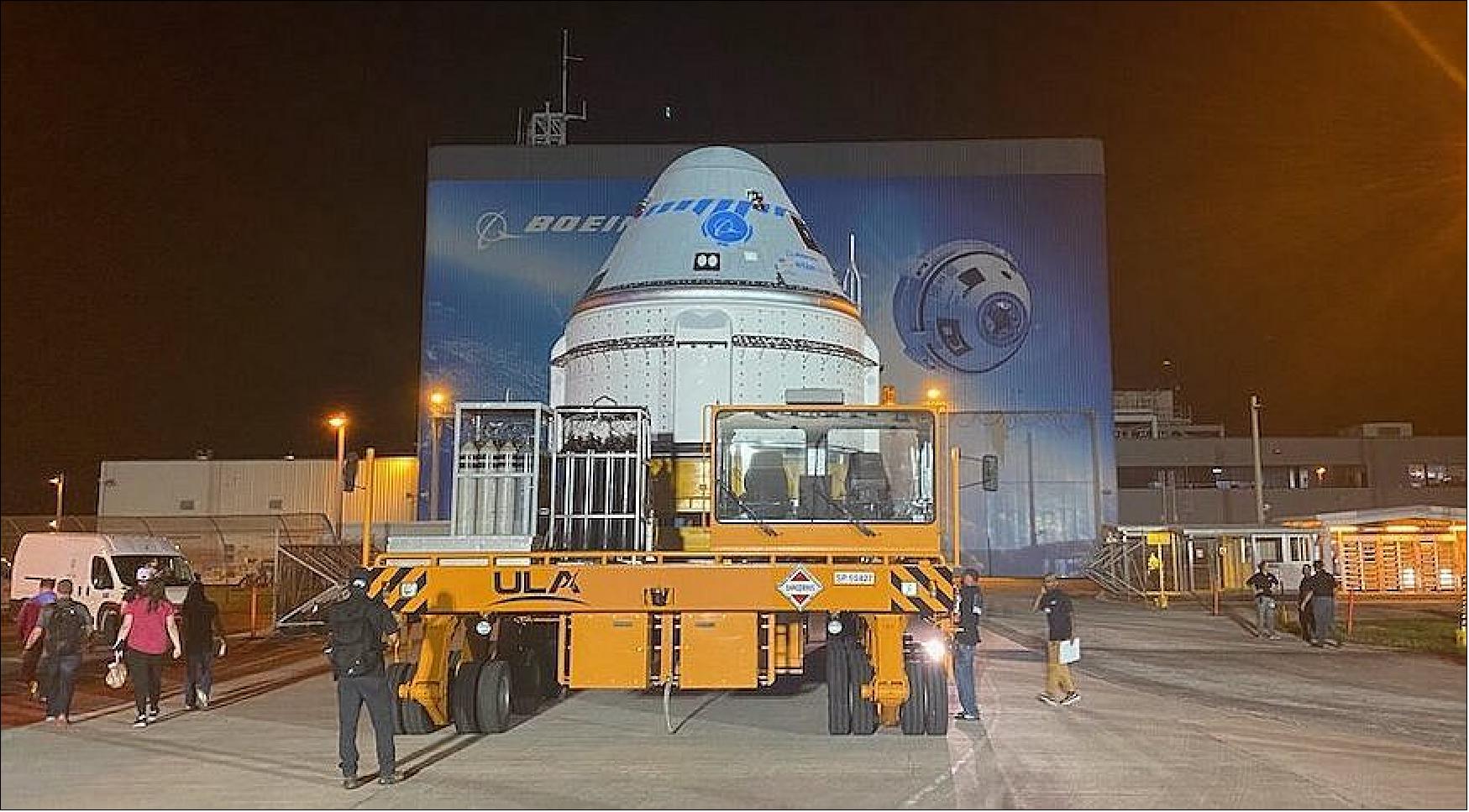
- The OFT-2 mission will come more than a year and a half after the original OFT flight in December 2019. Software problems encountered immediately after the spacecraft separated from its Centaur upper stage prevented it from going to the ISS, and it instead landed after just two days in space.
- The flight readiness review confirmed that Boeing had implemented 61 recommendations from an independent review team last year about software issues during the OFT mission as well as 19 recommendations to address communications problems encountered during the flight. “Those have been closed out,” Steve Stich, NASA commercial crew program manager, said in a call with reporters after the review.
- Among the changes made preparing for OFT-2 was a full mission rehearsal for the flight in a high-fidelity simulator. “We truly had an integrated mission rehearsal, a simulated mission from end to end,” said John Vollmer, vice president and program manager of the commercial crew program at Boeing. “We got a lot of learning out of that.”
- The mission plan for OFT-2 will be very similar to what had been planned for OFT, Vollmer said. One change is that the spacecraft will maneuver shortly after Centaur separation to better orient its antennas for communications during that critical early phase of the mission.
- The launch plans should not be affected by issues with Nauka, a new Russian module for the ISS launched July 21. That module has reportedly suffered issues with its propulsion system, although Roscosmos reported July 22 that the module has performed two maneuvers to raise its orbit. Nauka is scheduled to dock with the station July 29.
- “We’ve been working with Roscosmos to set up that choreography,” said Joel Montalbano, NASA ISS program manager. While not going into details about any issues with Nauka, also known as the Multipurpose Laboratory Module (MLM), he said that “we can support the OFT docking with or without the MLM.”
- A successful OFT-2 mission would allow NASA and Boeing to proceed with the Crew Flight Test (CFT), the first crewed Starliner mission that will carry three NASA astronauts. Stich said that the CFT mission could take place “as soon as later this year” but declined to offer a more specific date. Some industry sources are skeptical that CFT could launch this year, even if OFT-2 launches on schedule and is successful.
- “The most important thing, and the thing that the Boeing and NASA team have been focused on in the near term, is the execution of the orbital flight test. That has been our primary focus,” he said. Only after OFT-2 is complete and the data from it analyzed would NASA feel comfortable about setting a date for a crewed mission. “It looks like, right now, by the end of the year would be supportable, but again, we need to focus on the orbital flight test first and get that flight right.”
- One factor that could accelerate the schedule for CFT is that the Starliner flying OFT-2 is closer to the configuration for the crewed flight than the one used on the previous flight. That includes installing the launch abort thrusters that would allow Starliner to escape the rocket in the event of an emergency.
- NASA is anxious to get Starliner into service, providing redundancy for getting its astronauts to and from the ISS, a burden currently carried by SpaceX’s Crew Dragon spacecraft. “It’s very important for the commercial crew program to have two space transportation systems,” Stich said.
- The flight is also critical to Boeing, Vollmer acknowledged. “It’s extremely important to us that we’re successful on this flight. With all that we’ve done over the past 18 months, we are very confident that we are going to have a good flight,” he said.
- He added, though, that he expected there to be “some learning” from OFT-2. “It is a test flight,” he said. “It is of paramount importance that we have a successful flight.”
• June 17, 2021: Boeing has completed all the activities recommended by an independent review of the company’s first uncrewed CST-100 Starliner mission, allowing a second uncrewed mission to proceed for launch in late July. 24)
- NASA and Boeing announced June 16 that they had closed all the actions from an independent review in early 2020 to address problems with the first Orbital Flight Test (OFT) mission of the spacecraft in December 2019. That review made 80 recommendations involving testing, software development, communications and other issues.
- That mission was cut short, and a planned docking with the International Space Station canceled, because of software problems. An additional software problem, found and corrected in flight, could have damaged the spacecraft as it separated its service module just before reentry.

- “Closing all of the Independent Review Team findings for the software and communications systems is a huge milestone for the Commercial Crew Program and included many long hours of testing and reviews by our dedicated Boeing and NASA teams during this COVID-19 pandemic,” Steve Stich, manager of NASA’s commercial crew program, said in an agency statement.
- NASA confirmed that the second uncrewed test flight of Starliner, called OFT-2, remains on schedule for launch on an Atlas 5 July 30 from Cape Canaveral Space Force Station in Florida. That mission will carry out the tasks planned for the initial flight, including a space station docking, and spend 5 to 10 days in orbit before landing in the western United States.
- The launch date appeared to be in question earlier this month because of delays with another mission launching on an Atlas 5. United Launch Alliance said June 4 that it was delaying the Space Test Program (STP) 3 mission, which had been scheduled to launch June 23. The company said the delay was required to “evaluate launch vehicle readiness.”
- That initially raised concerns of a domino effect, with the delay of the STP-3 mission pushing back the Starliner launch. Tory Bruno, president and chief executive of United Launch Alliance, tweeted that the STP-3 delay was to investigate vibrations, or “ringing,” seen in a new nozzle extension on the RL10 engine that powers the Centaur upper stage. “We want to make sure we fully understand that behavior before flying this configuration again,” he wrote.
- However, the Centaur that will be used for the Starliner mission does not use that same nozzle extension. ULA tweeted June 10 that it was beginning preparations for the Starliner launch, calling it “our next Atlas 5 launch” and scheduled for July 30, the date previously announced by NASA and Boeing for the mission.
- NASA said that, if the OFT-2 mission launched on schedule and is successful, it is considering flying the first crewed flight of Starliner, the Crew Flight Test mission, this year. That will transport NASA astronauts Butch Wilmore, Nicole Mann and Mike Fincke to the station. NASA said in the statement that the agency and Boeing “will look for opportunities toward the end of this year” to fly the mission.
• May 6, 2021: NASA and Boeing recently completed an integrated mission dress rehearsal of Starliner’s uncrewed Orbital Flight Test-2 (OFT-2) mission to the International Space Station for NASA’s Commercial Crew Program. The campaign conducted largely inside Boeing’s Houston-based Avionics and Software Integration Lab (ASIL) culminated in a five-day end-to-end mission simulation known as the AMR (ASIL Mission Rehearsal). 25)
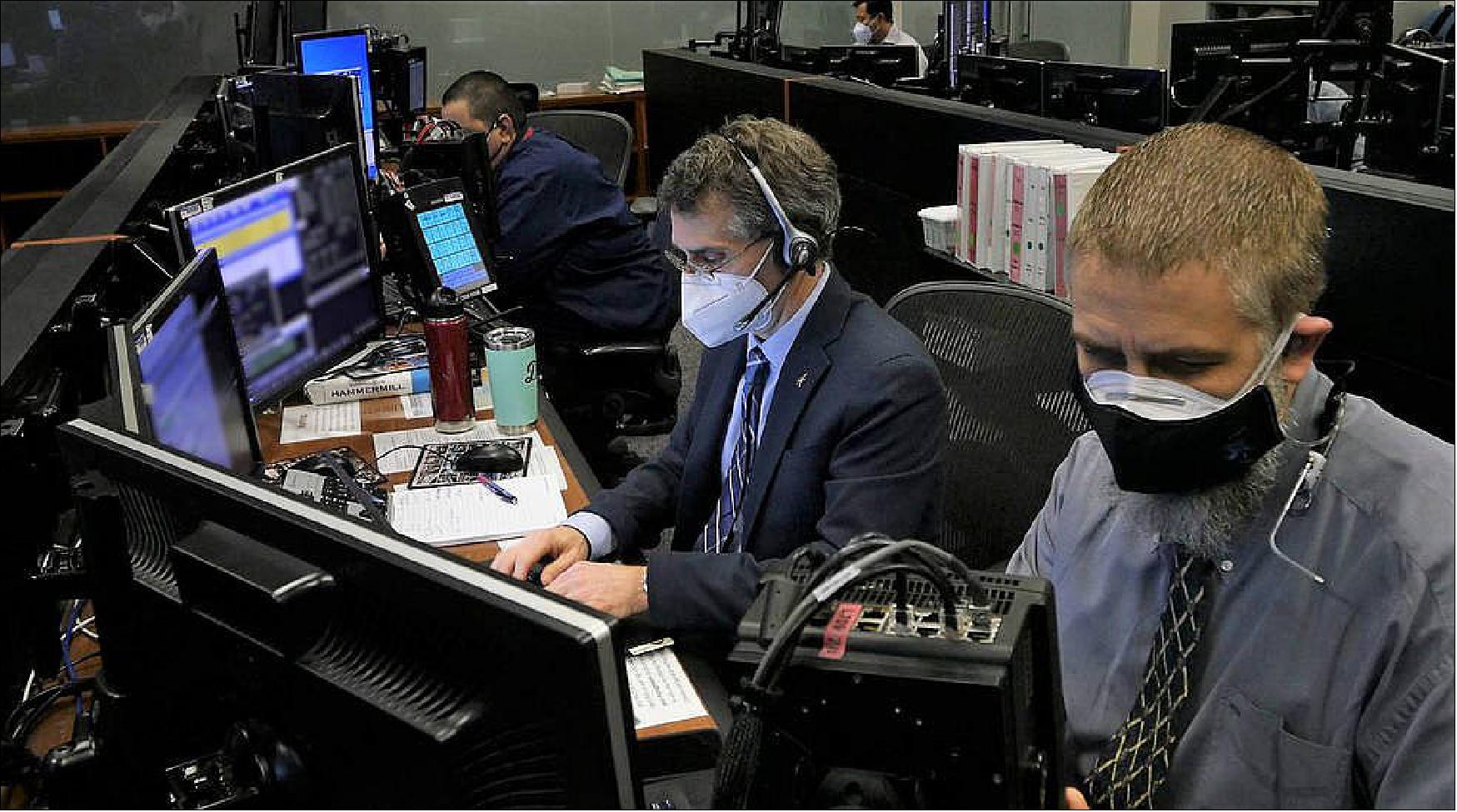
- Gearing up for the program’s first AMR took several months of preparation configuring hardware and software, routing communications channels, mapping simulated sensor data, verifying flight procedures, and completing weeks of dry runs.
- “The AMR is one of many examples of Boeing’s commitment to flying NASA astronauts as safely as possible,” said Chad Schaeffer, commercial crew software certification manager. “The joint Boeing and NASA system and software teams have worked very closely to prepare for the OFT-2 mission, including building stronger relationships and improved processes that are paying dividends for our commercial crew missions.”
- Mission operation teams inside flight control rooms at Johnson Space Center in Houston commanded the simulation using actual flight procedures. The run for record began 26 hours before launch and continued through docking, space station quiescent operations, 32 hours of power up procedures ahead of undocking, then landing and power down.
- NASA astronauts Barry “Butch” Wilmore and Mike Fincke monitored every dynamic event from inside the lab using crew displays connected to the simulator. Wilmore and Fincke will fly aboard Starliner’s Crew Flight Test along with NASA astronaut Nicole Mann. Launch control teams at Boeing’s Mission Control Center in Florida participated in the rehearsal along with United Launch Alliance (ULA), which supported onsite in Houston after testing Starliner’s hardware inside its own Denver-based integration lab earlier this year.
- “I can feel that on the NASA/Boeing team, there is a deep passion for spaceflight and doing what it takes to have a successful mission,” said NASA astronaut Mike Fincke. “I am glad to be on this team.”
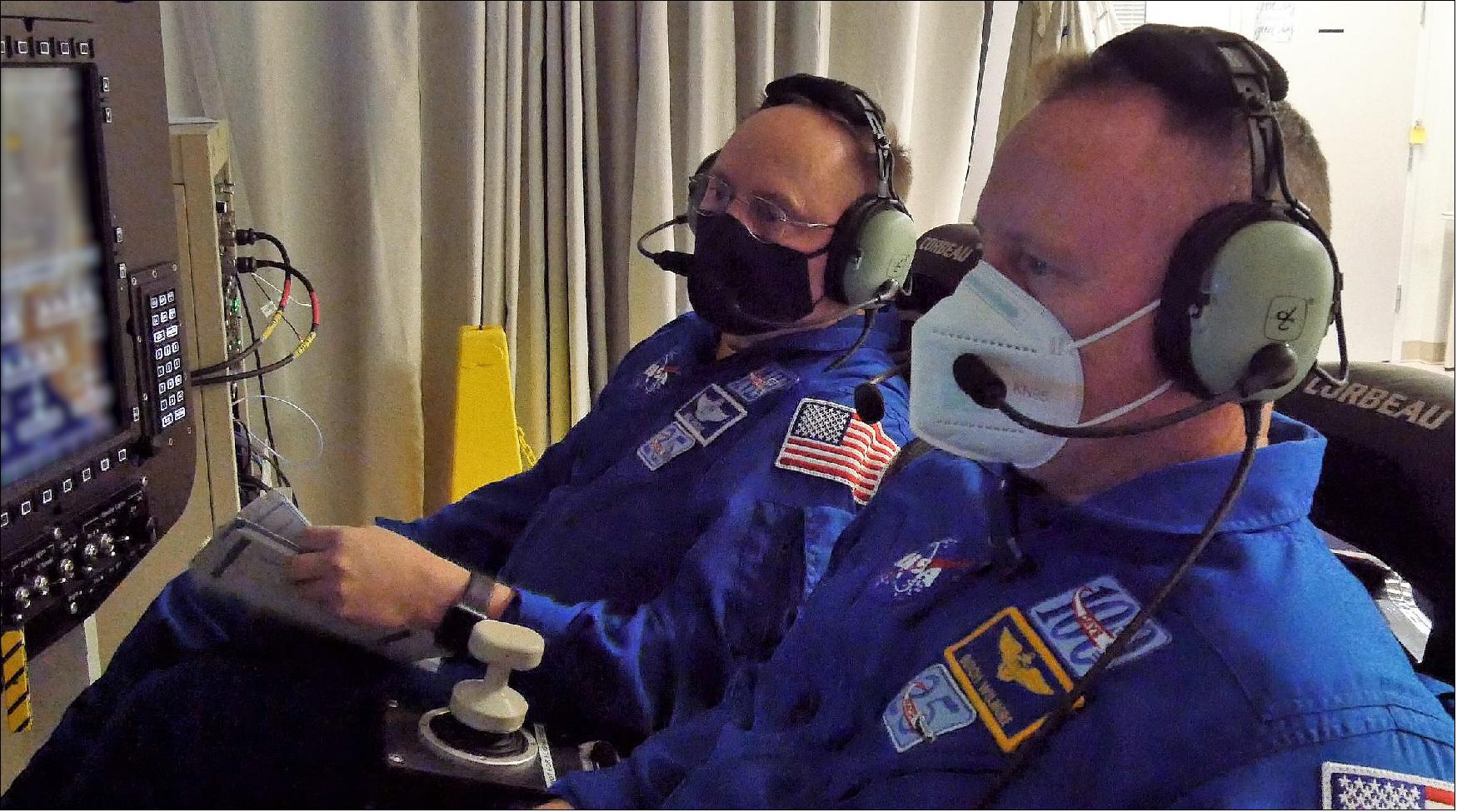
- An AMR will be conducted before every future flight serving as an additional confidence and integration test recommended by the NASA/Boeing Joint Independent Review Team as a result of Starliner’s first test flight. With the conclusion of the AMR, all the review team’s recommended actions relating to Starliner software are complete and pending closure by NASA. Boeing and NASA will continue supporting post-test reviews and updating the software to include lessons learned from the AMR campaign.
- NASA and Boeing are targeting 2:53 pm EDT Friday, 30 July 2021, for the launch of Starliner’s next test flight, OFT-2.
- “We’re feeling very confident in the software with the success of end-to-end testing,” said John Vollmer, Starliner program manager. “This campaign is about more than just our next mission. We’re working to ensure the safety and success of all future Starliner flights for NASA and every commercial customer to come.”
• April 18, 2021: Boeing said April 17 that the next test flight of its CST-100 Starliner commercial crew vehicle won’t take place until at least August, confirming a lengthy delay widely expected because of the schedule of other launches and International Space Station missions. 26)
- In a statement, Boeing said that the company and NASA are projecting the uncrewed Orbital Flight Test (OFT) 2 mission will take place in August or September. That date is “supported by a space station docking opportunity and the availability of the United Launch Alliance Atlas V rocket and Eastern Range.”
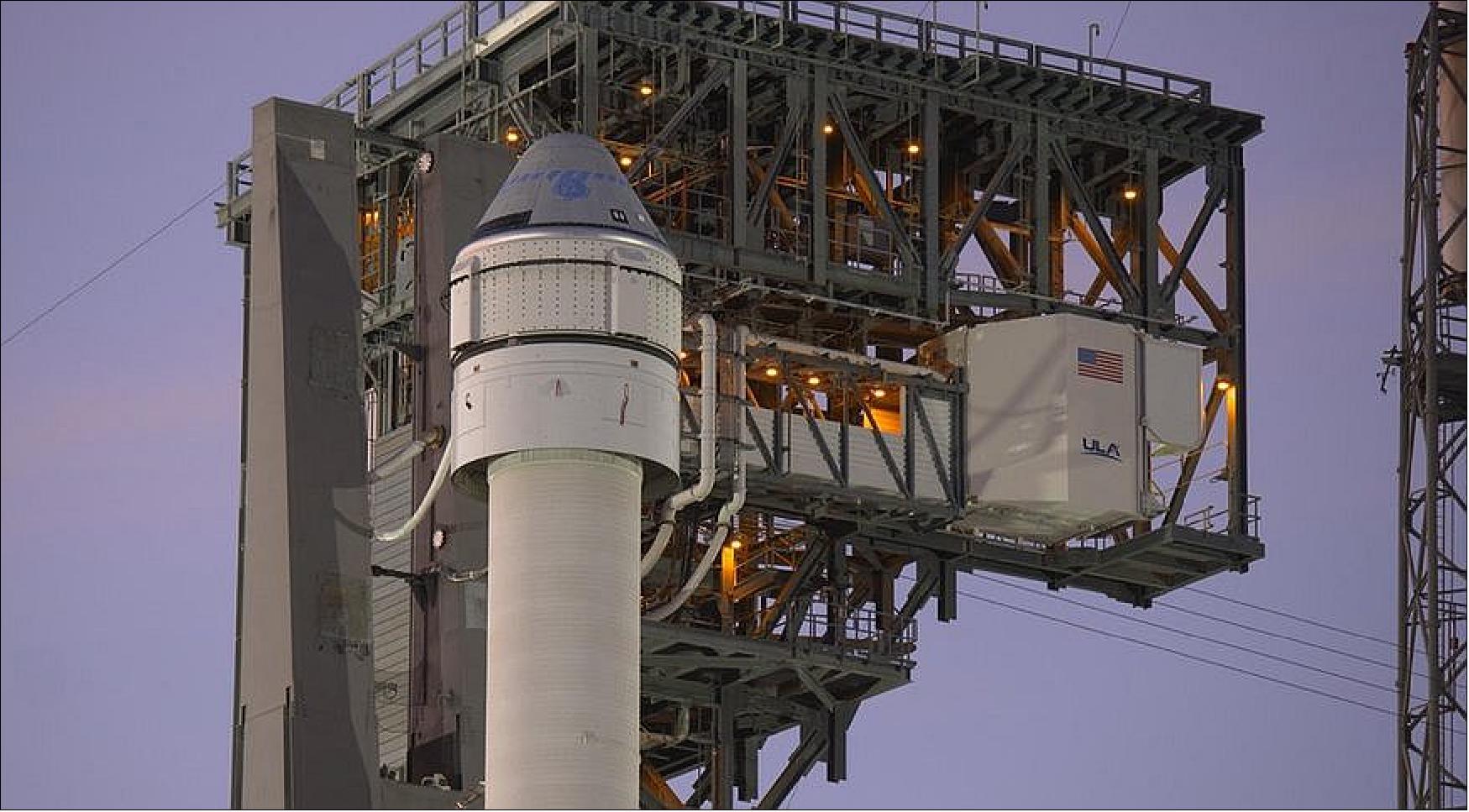
- Boeing had been working toward a launch of OFT-2 in late March or early April. However, by early March, NASA officials acknowledged that was no longer likely because of delays from the replacement of avionics units on the spacecraft that were damaged by a power surge during ground tests, as well as power outages in the Houston area caused by a winter storm in February that interrupted software testing.
- Neither NASA nor Boeing provided an updated launch date at the time, but noted the mission was unlikely to launch in either April or May. That was due to Soyuz and Crew Dragon missions to the ISS scheduled for launch in April, and the May launch of an Atlas 5 carrying a military spacecraft.
- At an April 15 briefing about the upcoming Crew-2 Crew Dragon mission, Steve Stich, NASA commercial crew program manager, said another factor was the next cargo Dragon mission to the space station, scheduled for launch in early June. That spacecraft, along with the Crew-2 spacecraft, will occupy the only two docking ports Starliner can use, meaning it can’t launch until after the cargo Dragon departs in mid-July.
- “Right now, the windows that we’re looking at are the August-September time frame for OFT-2,” he said.
- Boeing, in its statement, said that the Starliner flying OFT-2 will be “mission-ready” in May and the company “will evaluate options if an earlier launch opportunity becomes available.” For now, though, there are no plans to delay the cargo Dragon mission in June, in part because it is carrying solar panels NASA wants to get to the station as soon as possible to begin a long-anticipated upgrade of the station’s power supply.
- Stich said at the briefing that NASA and Boeing will take advantage of the delay to do additional software testing. Software issues were at the root of several major problems with the original OFT flight in December 2019, cutting the mission short and preventing the spacecraft from docking with the ISS.
- “Boeing expects to conclude all software testing in April and will support the agency’s post-test reviews as needed,” the company said, adding that it is completing all the recommendations made a year ago by an independent review, including those not considered mandatory before the spacecraft’s next flight.
- Despite the delay in OFT-2, NASA and Boeing said they are still working to make the vehicle’s first crewed flight, the Crew Flight Test, before the end of the year. Stich said at the briefing that the current target for that flight is the fourth quarter.
- That would mean the crewed flight would be no more than four months after OFT-2, while previous schedules suggested a gap of about half a year between them. Boeing said it is working to “enable the shortest turnaround time possible between flights while maintaining its focus on crew safety,” including having the three NASA astronauts who will fly that mission perform tests in the Starliner that will launch on OFT-2.
• February 17, 2021: NASA and Boeing now are targeting no earlier than Friday, April 2, for launch of the agency’s Boeing Orbital Flight Test-2 to the International Space Station. 27)
- As preparations continue for the second uncrewed flight test, teams remain focused on the safety and quality of the CST-100 Starliner spacecraft and successful launch of the end-to-end test to prove the system is ready to begin flying astronauts to and from the space station as part of NASA’s Commercial Crew Program.
- Teams are adjusting the launch date to allow more time for spacecraft and hardware processing. Ahead of final propellant loading, the company recently replaced avionics units affected as a result of a power surge due to a ground support equipment configuration issue during final checkouts.
- “NASA continues to work alongside Boeing to prepare for this first mission of 2021,” said Steve Stich, manager of NASA’s Commercial Crew Program. “The Boeing and NASA teamwork on all aspects of flight preparation including final certification, hazard analysis, and software testing is extraordinary. Even though this uncrewed flight test to the International Space Station is a key milestone on the path to the first Starliner crewed mission planned for later this year, we will fly when we are ready.”
- With formal software tests completed, Boeing is continuing with flight preparations. The company is ready to conduct an end-to-end mission rehearsal, using high-fidelity flight hardware and final flight software, to ensure the readiness of the team and combined systems.
- Boeing continues to support NASA as it reviews flight readiness, and teams have completed about 95% of the recommendations identified by the joint NASA and Boeing Independent Review Team, formed following the anomalies during the company’s first uncrewed Orbital Flight Test in December 2019.
- “We appreciate the significant work NASA is undertaking ahead of launch,” said John Vollmer, Starliner’s vice president and program manager at Boeing. “We’re fully engaged in the agency’s review process as a valuable investment of our time to ensure confidence in the spacecraft.”
• January 25, 2021: NASA and Boeing are targeting no earlier than Thursday, March 25, for the launch of Starliner’s second uncrewed flight test as part of the agency’s Commercial Crew Program. Boeing’s OFT-2 (Orbital Flight Test-2) is a critical developmental milestone on the company’s path to fly crew missions for NASA to the International Space Station. 28)
- The target launch date is enabled by an opening on the Eastern Range, the availability of the United Launch Alliance Atlas V rocket, steady progress on hardware and software, and an International Space Station docking opportunity.
- Boeing recently mated the spacecraft’s reusable crew module on its brand new service module inside the Starliner production factory at Kennedy Space Center in Florida. Teams are working to complete outfitting of the vehicle’s interior before loading cargo and conducting final spacecraft checkouts.
- Boeing also recently completed the formal requalification of Starliner’s OFT-2 flight software. Teams conducted a full software review and several series of tests to verify Starliner’s software meets design specifications. Boeing also will complete an end-to-end simulation of the OFT-2 test flight using flight hardware and final versions of Starliner’s flight software to model the vehicle’s expected behavior before flight.
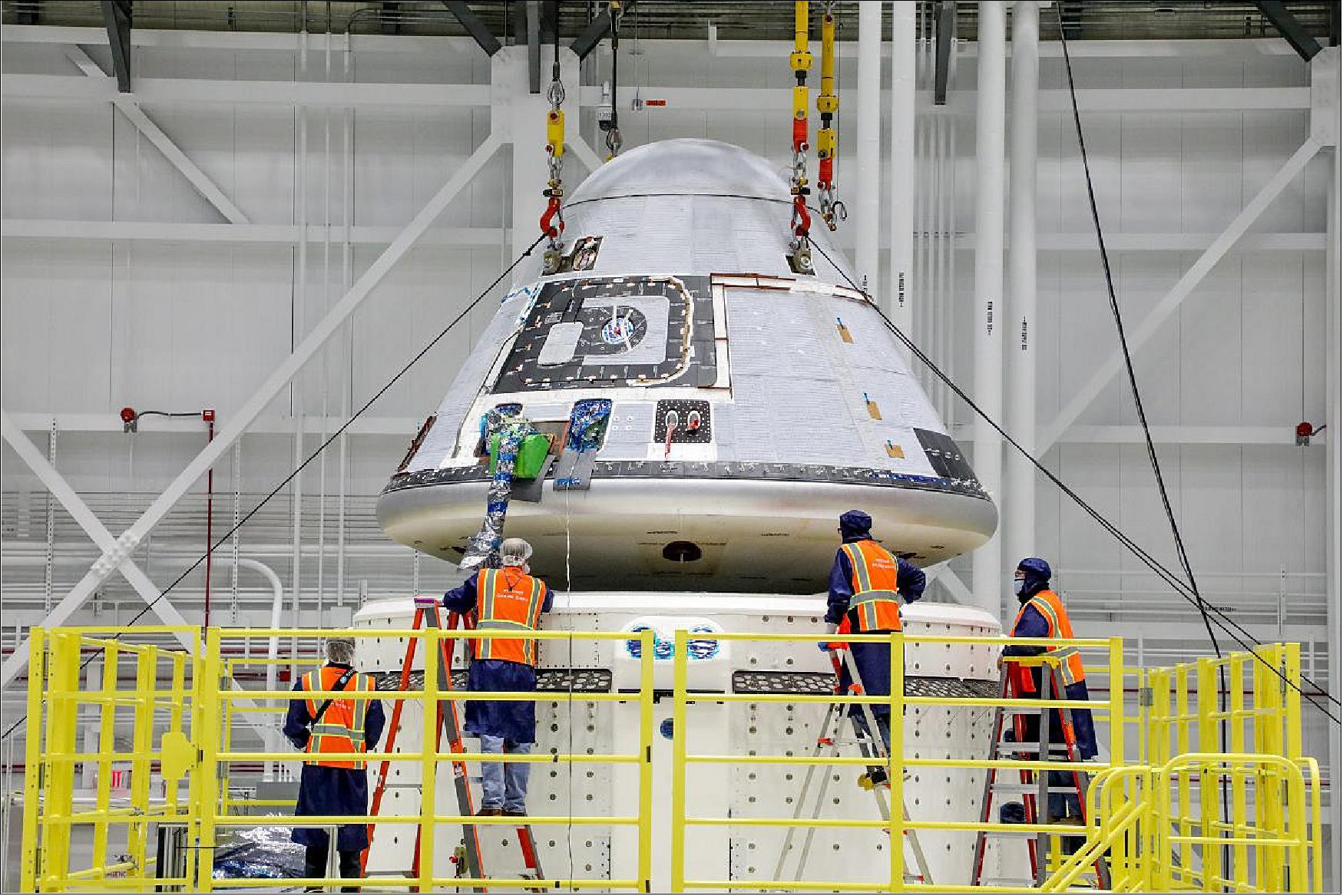
- The OFT-2 mission will launch Starliner on a United Launch Alliance Atlas V rocket from Space Launch Complex-41 at Cape Canaveral Space Force Station in Florida, dock to the space station and return to land in the western United States about a week later as part of an end-to-end test flight to prove the system is ready to fly crew.
• December 11, 2020: A second uncrewed test flight of Boeing’s CST-100 Starliner commercial crew spacecraft is now scheduled for no earlier than the end of March, 15 months after its first, flawed mission. 29)
- NASA and Boeing announced Dec. 9 that the launch of the Orbital Flight Test (OFT) 2 mission is scheduled for March 29 on a United Launch Alliance Atlas 5 rocket from Cape Canaveral. That is three months later than the last formal update for the mission announced by the organizations in August, when they still hoped to fly the mission by the end of 2020.
- Agency officials said last month that updates to the spacecraft’s software was driving the revised launch schedule. “The pacing item really is getting the software ready to go,” said Steve Stich, NASA commercial crew program manager, at a press conference in November ahead of SpaceX’s Crew-1 commercial crew launch. At the time he said the launch was expected no earlier than the first quarter of 2021. “As they continue to make progress on the flight software and the testing of that software, we’ll be able to refine that date a little bit better.”
- NASA said in a statement about the new OFT-2 launch date that Boeing had completed more than 90% of the recommended actions from an independent review earlier this year of the original OFT mission. “NASA and Boeing are doing a tremendous amount of work on all aspects of their flight software,” Stich said in the statement.
- “With each vehicle closeout, line of code tested and document delivered, we’re on a path to proving we have a robust, fully operational vehicle,” said John Vollmer, Starliner vice president and program manager at Boeing, in a statement.
- Boeing announced in April it would fly the OFT-2 mission, at its own expense, after the OFT mission in December 2019 suffered problems that truncated its mission and prevented the spacecraft from docking with the International Space Station. Those problems included a miscalibrated timer that led the spacecraft to think it was in the wrong phase of its mission immediately after launch, and another software flaw corrected just before reentry that could have caused the spacecraft’s service module to collide with the crew capsule after separation.
- While engineers complete updates to the spacecraft’s software, the spacecraft itself is nearing final assembly, Boeing said, with all the major components if the crew capsule installed and final checkouts of systems underway. It will then be mated to the spacecraft’s service module, which is already complete.
- Despite the delay in the OFT-2 mission, NASA and Boeing said they’re still planning to follow it with a Crew Flight Test (CFT) mission in the summer. In August, when OFT-2 was scheduled for launch at the end of 2020, NASA said CFT would fly no earlier than June 2021.
- The CFT mission will fly NASA astronauts Mike Fincke, Nicole Mann and Barry Wilmore to the ISS. NASA and Boeing announced in October that Wilmore would replace Boeing’s Chris Ferguson, who stepped aside from the CFT mission for personal reasons.
- NASA hasn’t announced how long the CFT mission will last. NASA had prepared to extend what was originally envisioned as a short test flight to a stay of as long as six months on the ISS when it was worried that delays in the commercial crew program would jeopardize access to the station. With SpaceX’s Crew Dragon now in service, those concerns have faded.
- NASA had targeted the launch of the second operational Crew Dragon mission, Crew-2, for as soon as late March, but the decision to schedule OFT-2 for that date suggests that Crew-2 could be moved to later in the spring, avoiding conflicts with both OFT-2 and a Soyuz mission planned for April. There are only two docking ports on the ISS for commercial crew vehicles, with the Crew-1 spacecraft occupying one of them.
- The schedule for a third Crew Dragon mission, as well as the first operational Starliner mission, Starliner-1, remain uncertain. NASA announced in August that Starliner-1, with NASA astronauts Sunita Williams, Josh Cassada and Jeanette Epps, along with a fourth crew member yet to be assigned, would launch no earlier than the end of 2021.
• October 2, 2020: A NASA safety panel said that while Boeing was making good progress on implementing changes to its CST-100 Starliner commercial crew vehicle, it had doubts that work could be done in time to allow another test flight this year. 30)
- At an Oct. 1 meeting of the ASAP (Aerospace Safety Advisory Panel), committee member Donald McErlean said Boeing was making “substantial progress” on preparations for Orbital Flight Test (OFT) 2, a second uncrewed test flight that the company said earlier this year it would fly after the original OFT mission last December suffered a series of problems.
- He said the Starliner crew module that will fly the OFT-2 mission is about 80% complete and its service module 90% complete. Other components for the mission, including its Atlas 5 launch vehicle and a spacecraft adaptor, have either been delivered or are being completed.
- NASA and Boeing announced Aug. 28 that the OFT-2 mission would launch no earlier than December. It will be followed by a Crew Flight Test (CFT) mission, with three astronauts from NASA and Boeing on board, no earlier than June 2021. If those missions fly as scheduled and are successful, Starliner could begin regular crew rotation missions to the International Space Station at the end of 2021.
- That schedule, though, is subject to resolving recommendations by a joint NASA-Boeing independent review team that investigated the problems with the OFT mission. That team provided 61 recommendations, primarily dealing with spacecraft software and “mission data loads” for Starliner. It later provided 19 additional recommendations involving a communications problem Starliner experienced during the OFT mission.
- McErlean said of the 61 original recommendations, 27 were classified as “mandatory” to resolve before the next mission, while 13 were “highly recommended” to resolve before the next flight and the other 21 were considered a lower priority. Of the additional 19 recommendations, 15 were considered mandatory and 1 highly recommended.
- However, he said, “Boeing has committed and is working towards correcting all of these items prior to OFT-2.” That requires, he said, working with the independent review team to both fully understand the recommendation and to ensure that corrective actions meet the intent of the recommendation.
- That effort involves “a very intense and significant amount of work,” he said. “We continue to worry, and show a source of concern, as to whether or not their progress towards final resolution will, in fact, meet the current evolved schedule.”
- A Boeing spokesperson told SpaceNews Oct. 2 that the company has either completed or is in the process of completing all the recommendations from the independent review. “This work will be completed prior to our next flight,” the company said.
- That work includes implementing 95% of all software-related recommendations in preparation for upcoming end-to-end testing. More than half of the recommendations regarding to the communications system are also complete.
- During the ASAP meeting, other members noted that NASA was applying some of the recommendations from the OFT investigation into planning for its exploration programs, such as improved software testing for both the Space Launch System and Orion. The panel endorsed that effort.
- “There are many lessons learned that can benefit both ongoing programs and many of the new efforts being initiated,” said Patricia Sanders, chair of the panel. “Instituting a formal review process will ensure that lessons learned both in development and during operations from the commercial crew providers, Boeing and SpaceX, can benefit other agency programs and future commercial partners.”
• August 28, 2020: NASA and Boeing continue to make progress toward the company’s second uncrewed flight test of the CST-100 Starliner spacecraft prior to flying astronauts to the International Space Station as part of NASA’s Commercial Crew Program. 31)
- The Commercial Crew Program currently is targeting no earlier than December 2020 for launch of the uncrewed Orbital Flight Test-2 (OFT-2) pending hardware readiness, flight software qualification, and launch vehicle and space station manifest priorities.
- Over the summer, Boeing’s Starliner team focused on readying the next spacecraft for its upcoming flight tests as well as making improvements identified during various review processes throughout the beginning of the year. NASA also announced an additional crew assignment for its first operational mission, NASA’s Boeing Starliner-1, with astronauts to the space station. Here’s more on the recent progress:
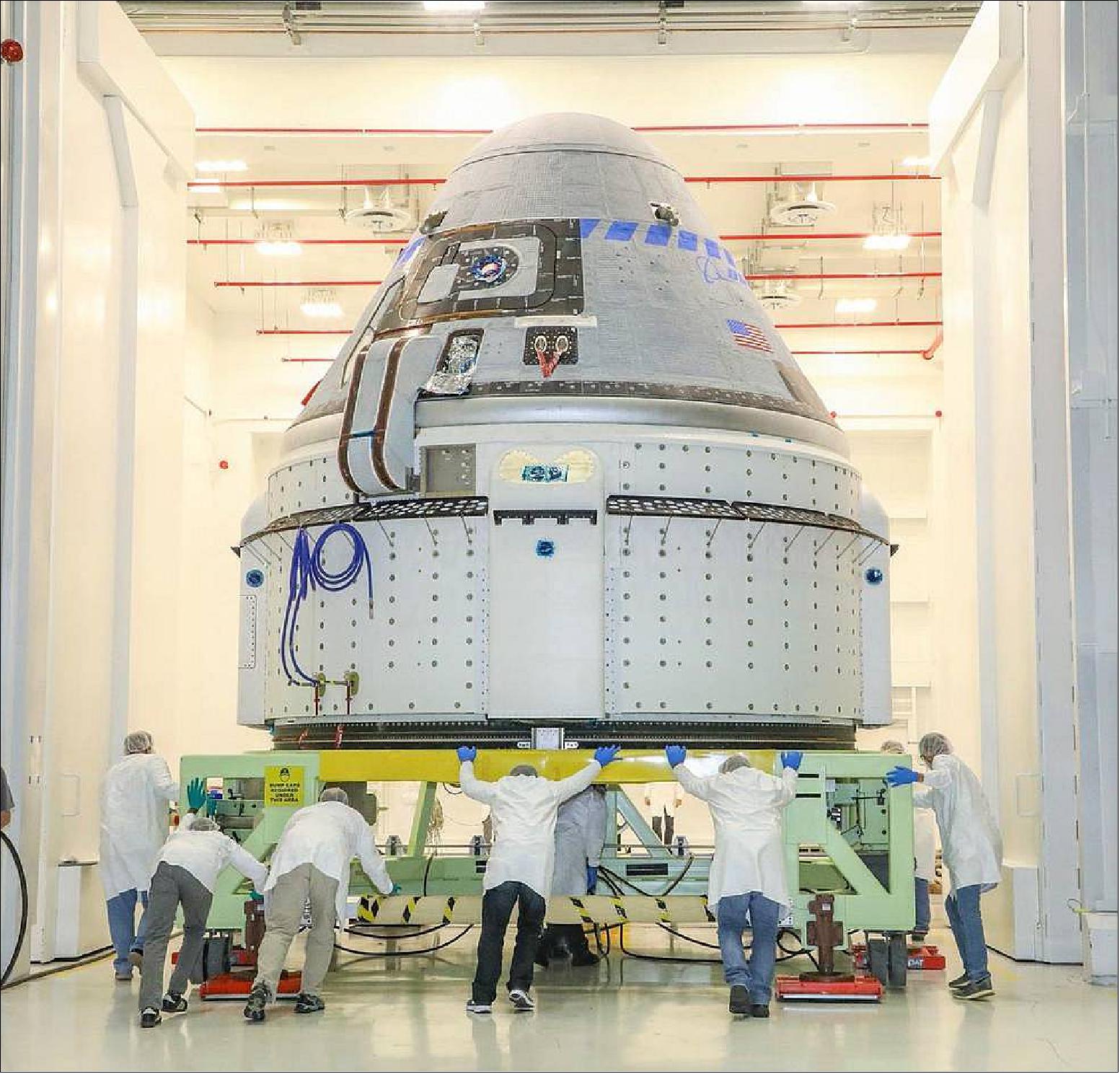
Starliner Progress
- Teams from Boeing are well into final assembly of the crew and service modules that will fly OFT-2 to the space station inside of the company’s Commercial Crew and Cargo Processing Facility (C3PF) at NASA’s Kennedy Space Center in Florida. OFT-2 will fly a new, reusable Starliner crew module providing additional on-orbit experience for the operational teams prior to flying missions with astronauts. For Boeing’s Commercial Crew missions, the Starliner spacecraft will launch atop a United Launch Alliance Atlas V rocket.
- With the majority of assembly complete, recent progress is focused on the NASA docking system re-entry cover, which was added to the design for additional protection of the system. The team also has completed the installation of the Starliner propellant heater, thermal protection system tiles and the air bags that will be used when the spacecraft touches down for landing. As final production activities continue to progress, the crew module recently entered acceptance testing, which will prove out the systems on the spacecraft before it’s mated with its service module.
- In Houston, the software team is nearing the final stages of modifying and re-verifying the flight code after the first uncrewed flight test. As part of that effort, the team recently began a major milestone called Formal Qualification Testing, which is a comprehensive test of flight software and an important step in preparing for an end-to-end mission rehearsal test.
- Boeing also remains focused on incorporating the recommendations from the joint NASA-Boeing Independent Review Team with almost 75% of the 80 proposed actions implemented. The independent team was formed to review anomalies experienced during OFT, which led to Starliner not reaching its planned orbit or docking to station as planned, and to provide recommendations to ensure a robust design for future missions. In addition to opting to re-fly its uncrewed flight test, Boeing elected to comprehensively implement all of the recommendations provided by the review team.
- Following a successful OFT-2, Boeing will focus full attention on preparations for its final flight test with astronauts and is already completing work on the Crew Flight Test spacecraft in parallel. Teams continue refurbishing the crew module flown on Starliner’s first uncrewed flight test for reuse with astronauts. After removing and conducting checkouts on various systems and flight hardware, Boeing is preparing to reassemble the vehicle for flight. Soon, outfitting of the crew module’s interior will begin along with packing parachutes and airbags ahead of installation. The vehicle’s NASA Docking System has been modified to accommodate the new cover, and outfitting of subsystem components continues on the spacecraft’s brand new service module.
Crew Updates and Target Flight Schedules
- In advance of the OFT-2 mission, flight control teams from NASA and Boeing completed an integrated launch-to-docking simulation in August with additional mission simulations on the horizon as the teams fine-tune flight rules and procedures.
- After a successful OFT-2, Boeing and NASA will fly Starliner’s first crewed mission, the Crew Flight Test, currently targeted for no earlier than June 2021, with the first post-certification mission, called Starliner-1, tentatively scheduled for no earlier than late December 2021.
- The CFT crew members are Boeing astronaut Chris Ferguson and NASA astronauts Mike Fincke and Nicole Mann.
- In addition to training for living and working on station, astronauts continue to work closely with Starliner test teams. Several crew members plan to participate in ongoing acceptance testing of the OFT-2 crew module inside the C3PF.
- Recently, the CFT (Boeing’s Crew Flight Test) crew helped test software updates with real flight hardware in Boeing’s Avionics and Software Integration Lab in Houston. They practiced performing manual separation events for several low likelihood contingencies, demonstrating the software improvements had no adverse effect on controls needed to stay safe in any situation. The crew also participated in procedural dry runs for future life support tests with the Starliner spacecraft in Florida. Later this year, the CFT crew will be suited inside the spacecraft with the vehicle providing all of their life support.
- NASA astronauts Sunita Williams, Josh Cassada and Jeanette Epps are crew members of the Starliner-1 mission. Cassada and Williams were both selected for the mission in August 2018, and NASA announced Epps’ assignment Aug. 25.
- Astronauts for both CFT and Starliner-1 missions regularly participate in rehearsals of launch and mission operations in both normal and emergency scenarios. They also are continuing with on-going mission-specific training for life in orbit including the work they’ll perform after joining their respective Expedition crews awaiting them on station.
- The goal of NASA’s Commercial Crew Program is safe, reliable and cost-effective transportation to and from the International Space Station. This could allow for additional research time and increase the opportunity for discovery aboard humanity’s testbed for exploration, including helping us prepare for human exploration of the Moon and Mars.
• July 7, 2020: NASA and Boeing have completed major reviews of the company’s uncrewed Orbital Flight Test in December 2019 and are continuing with preparations to refly the test, designated Orbital Flight Test-2 (OFT-2), to the International Space Station as part of NASA’s Commercial Crew Program. 32)
- “NASA and Boeing have completed a tremendous amount of work reviewing the issues experienced during the uncrewed flight test of Starliner,” said Steve Jurczyk, associate administrator at NASA. “Ultimately, everything we’ve found will help us improve as we move forward in the development and testing of Starliner, and in our future work with commercial industry as a whole.”
- The joint NASA-Boeing Independent Review team completed the final assessment into the intermittent space-to-ground communication issue detected during the first uncrewed Orbital Flight Test of Boeing’s Starliner spacecraft. The review team previously completed its investigation into the two other primary anomalies experienced during the test.
- With the completion of the investigation’s third and final focus area, the review team identified a total of 80 recommendations that Boeing, in collaboration with NASA, is addressing, with action plans for each already well under way. Although the full list of recommendations is company sensitive and proprietary, the categories of the corrective and preventative actions are as follows:
a) Testing and Simulation: 21 recommendations including the need for greater hardware and software integration testing; performance of an end-to-end “run for record” test prior to each flight using the maximum amount of flight hardware available; reviewing subsystem behaviors and limitations; and addressing any identified simulation or emulation gaps.
b) Requirements: 10 recommendations including an assessment of all software requirements with multiple logic conditions to ensure test coverage.
c) Process and Operational Improvements: 35 recommendations including modifications to change board documentation; bolstering required participants in peer reviews and test data reviews; and increasing the involvement of subject matter experts in safety critical areas.
d) Software: 7 recommendations including updating the software code and associated artifacts to correct the Mission Elapsed Timer Epoch and Service Module disposal anomalies; and making the antenna selection algorithm more robust.
e) Knowledge Capture and Hardware Modification: 7 recommendations such as organizational changes to the safety reporting structure; amending the Independent Verification and Validation (IV&V) approach; and the addition of an external Radio Frequency (RF) filter to reject out-of-band interference.
- As a result of this work and Boeing’s separate analysis, the company proactively announced in April it would fly a second orbital test at no cost to the government to prove the Starliner system meets NASA’s requirements, including docking to the space station.
- Boeing and NASA have asked the independent review team to remain engaged as a valuable and important partner in the Starliner’s path to crewed flight. Additionally, lessons learned from the Starliner’s first uncrewed flight test are being shared across the human spaceflight community to strengthen the industry as a whole.
- “As vital as it is to understand the technical causes that resulted in the flight test not fulfilling all of its planned objectives, it’s equally as important to understand how those causes connect to organizational factors that could be contributors,” said Jurczyk. “That’s why NASA also decided to perform a high visibility close call review that looked at our combined teams.”
- NASA has now also completed the high visibility close call investigation to specifically review the organizational factors within NASA and Boeing that could have contributed to the flight test anomalies. The close call investigation team, established in March, was tasked with developing recommendations that could be used to prevent similar close calls from occurring in the future.
- The close call team built off the technical findings of the joint independent review team related to the software coding errors made during the development of the spacecraft. The team also received additional briefings, held subject matter expert discussions and conducted interviews across the organizations.
Recommendations for the NASA Human Exploration and Operations Mission Directorate to Incorporate into Future Programs
- Require that the systems engineering management plan delivered by each contractor contain specific requirements related to the contractor’s management approach.
- Ensure that NASA reviews and approves the contractor’s hazard verification test plans prior to test execution.
- Ensure NASA independent validation and verification (IV&V) teams provide insight to contractor IV&V agents.
- Implement an approach that ensures alternate standards are reviewed and approved prior to beginning development work.
- Develop a best practices document for use by future programs that implement the shared accountability model used in NASA’s Commercial Crew Program.
- Evaluate Boeing’s actions developed by the joint independent review team for applicability post-certification.
Consequences of Recommendations
- With the development of these recommendations, the high visibility close call investigation has concluded.
- “I can’t stress enough how committed the Boeing team has been throughout this process,” said Phil McAlister, director of commercial spaceflight development at NASA. “Boeing has worked collaboratively with NASA to perform these detailed assessments. To be clear, we have a lot more work ahead, but these significant steps help us move forward on the path toward resuming our flight tests.”
- Boeing and NASA have not yet established a launch date for OFT-2.
Further Updates
• April 6, 2020: Boeing has decided to fly a second uncrewed flight test as a part of NASA’s Commercial Crew Program. Although no new launch date has been set, NASA has accepted the proposal to fly the mission again and will work side-by-side with Boeing to resume flight tests to the International Space Station on the company’s CST-100 Starliner system. 33)
- The agency’s Commercial Crew Program is a unique approach to human spaceflight in which NASA provides a set of mission and safety requirements and private companies, like Boeing and SpaceX, propose their own unique strategies to prove the systems meet the intent of the requirements. Consistent with that approach, Boeing had the responsibility to bring NASA its proposal on how to proceed with the flights.
- An uncrewed flight test originally was proposed by Boeing to demonstrate the Starliner system could perform as designed to fly to the space station prior to having a crew onboard. With that proposal, the uncrewed flight became a part of the Commercial Crew Transportation Capability contract in 2014 between NASA and Boeing.
- Although many of the objectives of Boeing’s first uncrewed flight test in December 2019 were accomplished, Boeing decided the best approach to meeting the agency’s requirements would be to fly the mission again, including docking with the space station. Data from the next and previous flight test will be used as part of NASA’s process of certifying Boeing’s crew transportation system for carrying astronauts to and from the space station.
- If Boeing would have proposed a crewed mission as the next flight, NASA would have completed a detailed review and analysis of the proposal to determine the feasibility of the plan. However, as this was not the recommendation made by Boeing, NASA will not speculate on what the agency would have required.
- The second uncrewed flight does not relieve Boeing from completing all the actions determined from the joint NASA/Boeing independent review team, which was commissioned following the flawed initial flight. NASA still intends to conduct the needed oversight to make sure those corrective actions are taken.
- NASA and Boeing are in the early stages of the decision to fly a second uncrewed orbital mission to the station, and a timeline for flying crew has not been determined.
- Although completing a second uncrewed flight test was not in the timeline for returning U.S. human spaceflight on Starliner, NASA fully supports our Boeing partner’s commitment to flying astronauts as safely as possible.
- This is exactly why NASA decided to select two partners in the commercial crew effort. Having dissimilar redundancy is key in NASA’s approach to maintaining a crew and cargo aboard the space station and to keeping our commitments to international partners. It also allows our private industry partners to focus on crew safety rather than schedule. The safety of our commercial crew team always will remain as our top priority.
• December 16, 2019: When Boeing’s Orbital Flight Test (OFT) launches on Dec. 20, 2019, it will be a major step toward returning human spaceflight capability to the U.S. 34)
- The uncrewed mission for NASA’s Commercial Crew Program will rendezvous and dock Boeing’s CST-100 Starliner spacecraft with the International Space Station and return to Earth on Dec. 28. Starliner will launch atop a United Launch Alliance Atlas V rocket from Space Launch Complex 41 (SLC-41) at Cape Canaveral Air Force Station in Florida.
- “This test flight will give us valuable data about Starliner’s performance in the actual environment through each phase of flight and demonstrate its capability to transport crew to the space station and bring them home safely,” said Trip Healey, NASA’s mission manager for OFT. “Being on the cusp of this huge moment in history is really exciting.”
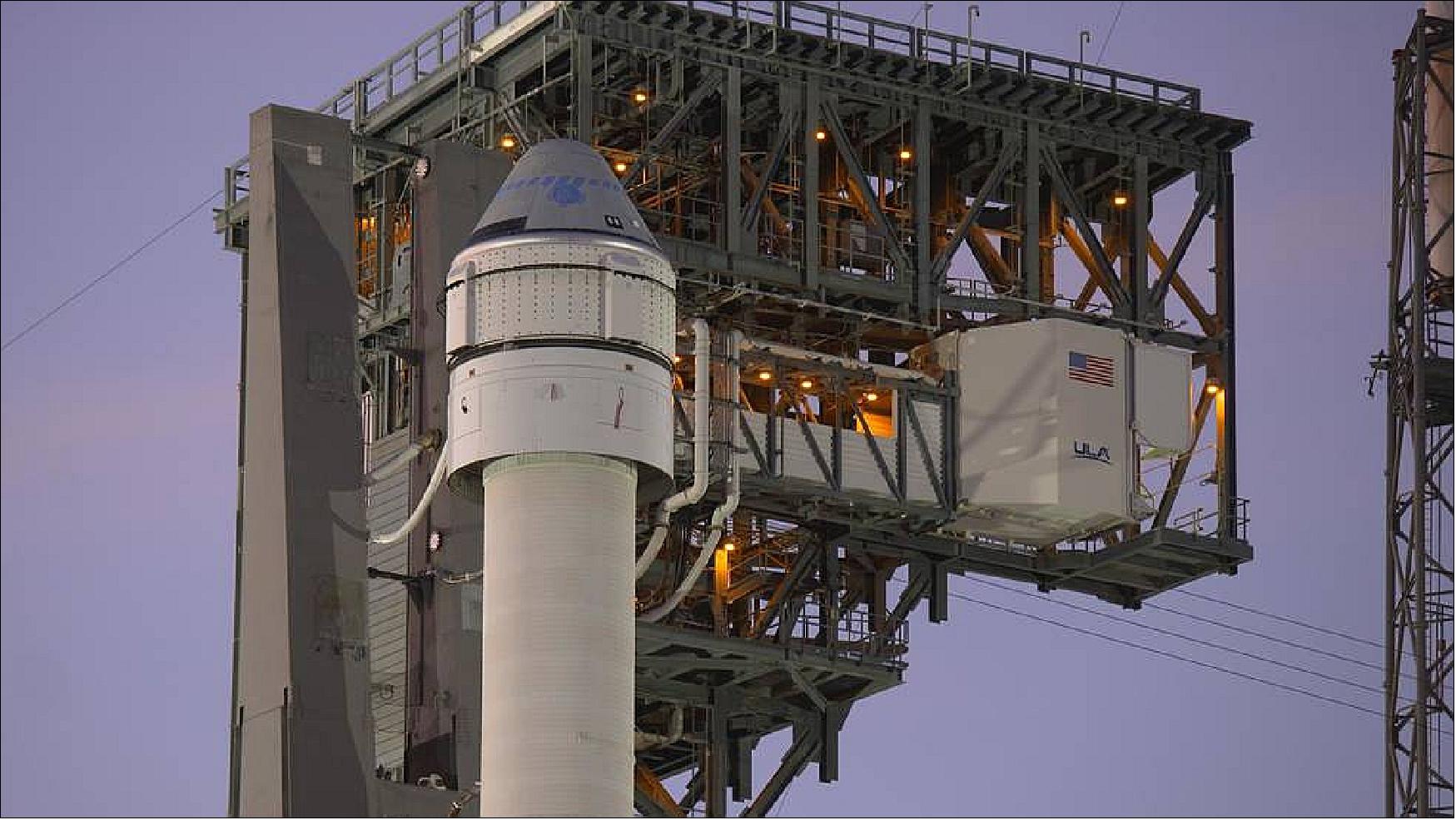
- Data from the mission will validate spacecraft system performance and will move Starliner farther down the path toward its first flight with astronauts aboard — Boeing’s Crew Flight Test (CFT).
- NASA astronauts Michael Fincke and Nicole Mann and Boeing astronaut Chris Ferguson will be onboard Starliner for CFT. All three were on hand when the spacecraft for this flight test rolled out of Boeing’s Commercial Crew and Cargo Processing Facility at NASA’s Kennedy Space Center in Florida on Nov. 21, making the roughly six-mile trek on a transport vehicle to SLC-41 to be mated atop the Atlas V rocket.
- The crew also recently participated in an integrated day of launch test for OFT and witnessed Boeing’s Pad Abort Test. These tests are part of verifying each of Starliner’s systems will function not only separately, but in concert, to protect astronauts on the Crew Flight Test and future missions by carrying them safely away from the launch pad in the unlikely event of an emergency prior to liftoff. For this test without crew members, the abort system will not be active.
- “We’re looking forward to the day when we’re launching people on a regular basis,” said Fincke. “As graduates of military test pilot schools, we are really excited to see how Starliner’s going to behave; we know it’s going to be awesome, and we’re going to get all kinds of really great test data from it.”
- The uncrewed flight test is the culmination of years of ingenuity and perseverance throughout the design, build, and test phases of the program.
- “The most inspiring thing to note through this partnership is how the Boeing, ULA and NASA teams continue to work together to resolve challenges,” Healey said. “There is definitely a team spirit, or esprit de corps, that has helped bring us to this point.”
• December 12, 2019: NASA and Boeing are proceeding with plans for Boeing’s Orbital Flight Test following a full day of briefings and discussion called a Flight Readiness Review that took place at the agency’s Kennedy Space Center in Florida. 35)
- Launch of the CST-100 Starliner spacecraft atop a United Launch Alliance Atlas V rocket is scheduled for 6:36 a.m. EST Friday, Dec. 20, from Space Launch Complex 41 on Cape Canaveral Air Force Station. The uncrewed flight test will be Starliner’s maiden mission to the International Space Station for NASA’s Commercial Crew Program.
- NASA is working with its commercial partners to launch astronauts on American rockets and spacecraft from American soil for the first time since 2011. Safe, reliable and cost-effective human transportation to and from the space station will allow for additional research time and increase the opportunity for discovery aboard humanity’s testbed for exploration.
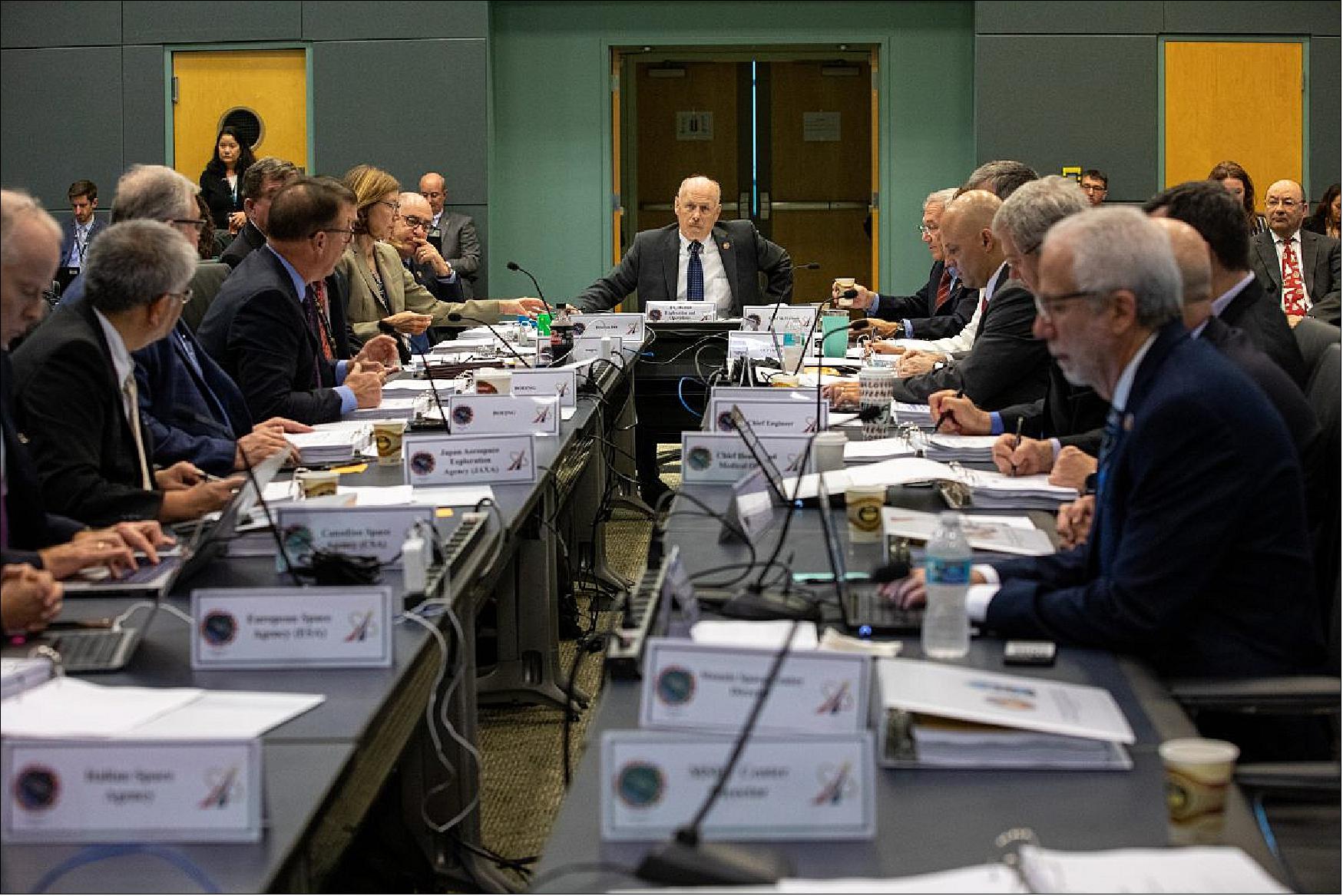
• November 22, 2019: Boeing's CST-100 Starliner spacecraft was transported from NASA's Kennedy Space Center to a facility at Cape Canaveral Air Force Station on Thursday, Nov. 21, 2019. Later in the day it was placed atop a United Launch Alliance Atlas V rocket ahead of Boeing’s uncrewed Orbital Flight Test to the International Space Station. 36)
Boeing’s uncrewed flight test, which is targeted for Dec. 17, will provide valuable data on the end-to-end performance of the rocket, spacecraft and ground systems, as well as, in-orbit and landing operations. The data will be used toward certification of Boeing’s crew transportation system for carrying astronauts to and from the space station.
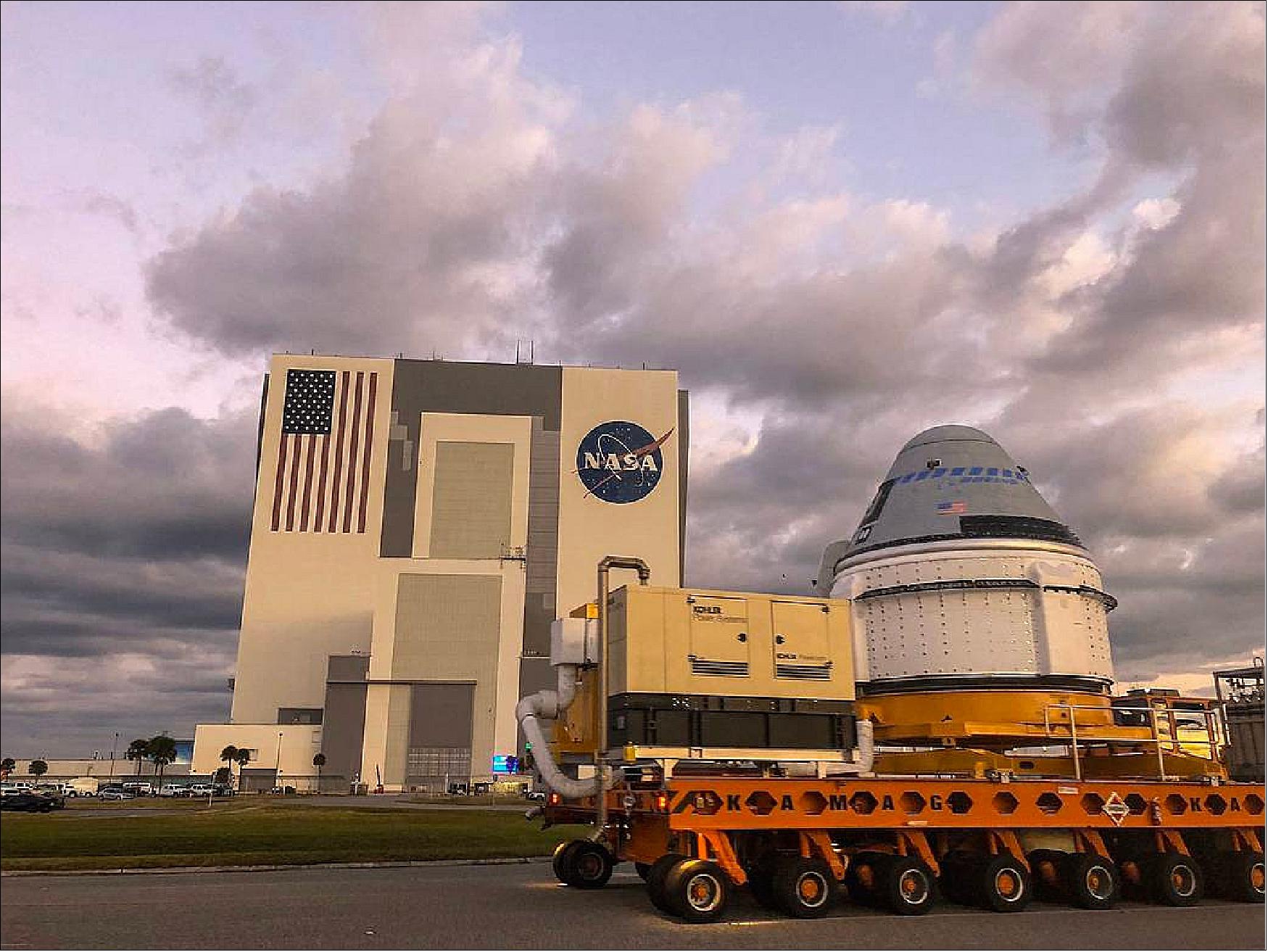
- NASA’s Commercial Crew Program is working with the American aerospace industry through public-private partnerships to launch astronauts on American rockets and spacecraft from American soil for the first time since 2011. The goal of the program is safe, reliable and cost-effective human space transportation to and from the International Space Station. This could allow for additional research time aboard the station and increase the opportunity for discovery aboard humanity’s testbed for exploration, which includes sending astronauts to the Moon and Mars.
• November 4, 2019: Boeing's CST-100 Starliner spacecraft completed a critical safety milestone on Monday in an end-to-end test of its abort system. The Pad Abort Test took place at Launch Complex 32 at the U.S. Army's White Sands Missile Range in New Mexico. 37) 38)
- The test was designed to verify each of Starliner’s systems will function not only separately, but in concert, to protect astronauts by carrying them safely away from the launch pad in the unlikely event of an emergency prior to liftoff. This was Boeing’s first flight test with Starliner as part of NASA’s Commercial Crew Program to return human spaceflight launches to the International Space Station from American soil.
- “Tests like this one are crucial to help us make sure the systems are as safe as possible,” said Kathy Lueders, NASA’s Commercial Crew Program manager. “We are thrilled with the preliminary results, and now we have the job of really digging into the data and analyzing whether everything worked as we expected.”
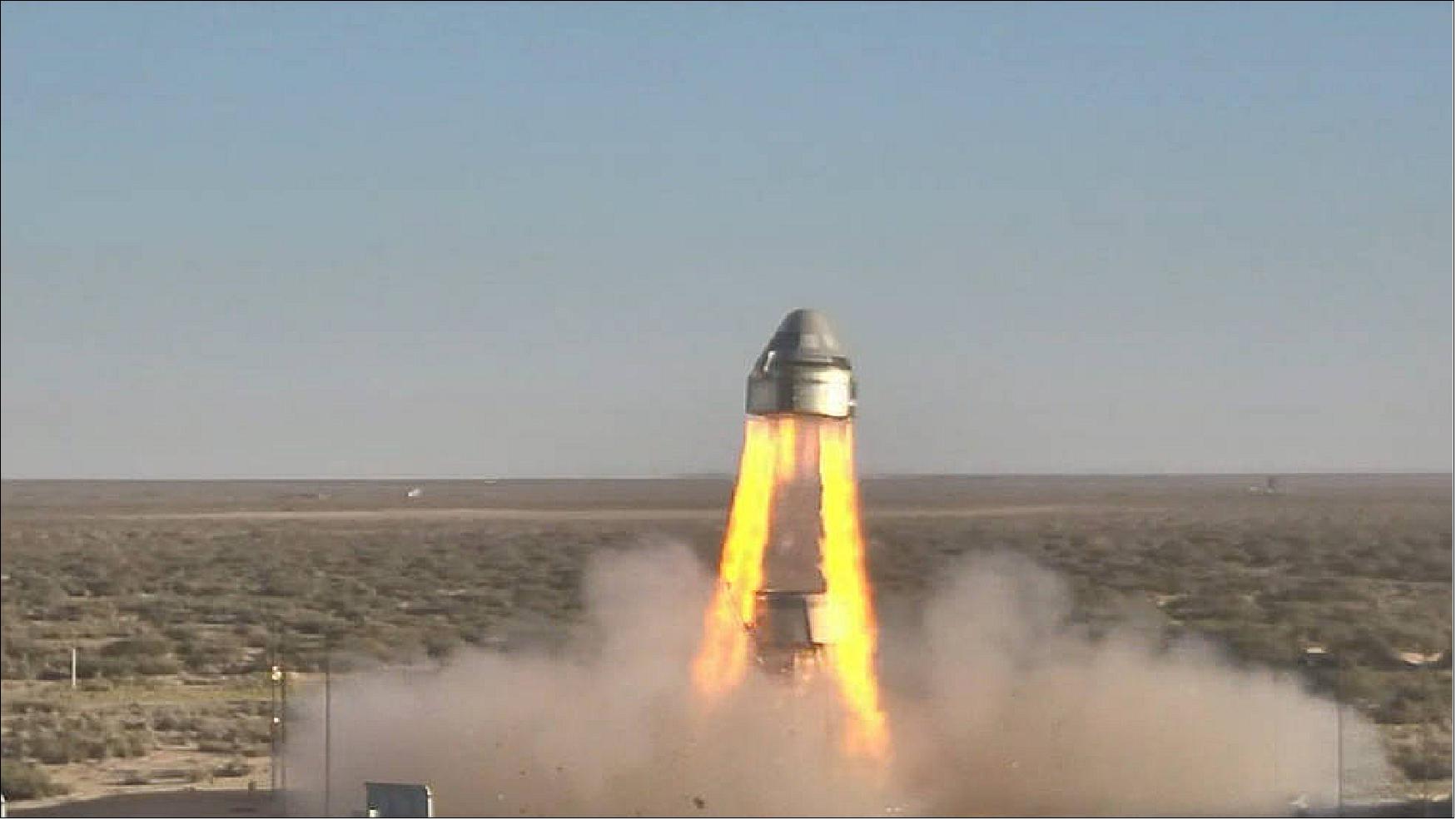
- During the test, Starliner’s four launch abort engines, and several orbital maneuvering and attitude control thrusters simultaneously ignited to rapidly push the spacecraft away from the test stand. Five seconds into flight, the abort engines shut off as planned, transferring steering to the control thrusters for the next five seconds.
- A pitcharound maneuver rotated the spacecraft into position for landing as it neared its peak altitude of approximately 4,500 feet. Two of three Starliner’s main parachutes deployed just under half a minute into the test, and the service module separated from the crew module a few seconds later. Although designed with three parachutes, two opening successfully is acceptable for the test parameters and crew safety. After one minute, the heat shield was released and airbags inflated, and the Starliner eased to the ground beneath its parachutes.
- The demonstration took only about 95 seconds from the moment the simulated abort was initiated until the Starliner crew module touched down on the desert ground.
- “Emergency scenario testing is very complex, and today our team validated that the spacecraft will keep our crew safe in the unlikely event of an abort,” said John Mulholland, Vice President and Program Manager, Boeing’s Commercial Crew Program. “Our teams across the program have made remarkable progress to get us to this point, and we are fully focused on the next challenge—Starliner’s uncrewed flight to demonstrate Boeing’s capability to safely fly crew to and from the space station.”
- Boeing’s next mission, called Orbital Flight Test, will launch an uncrewed Starliner spacecraft to the station on a UAL (United Launch Alliance) Atlas V rocket from Cape Canaveral Air Force Station’s Space Launch Complex 41. The launch is targeted for 17 December 2019.
• October 9, 2019: Boeing expects to carry out a pad abort test for its CST-100 Starliner commercial crew vehicle in early November, followed by an uncrewed orbital flight test in mid-December, a company executive said on 8 October. 39)
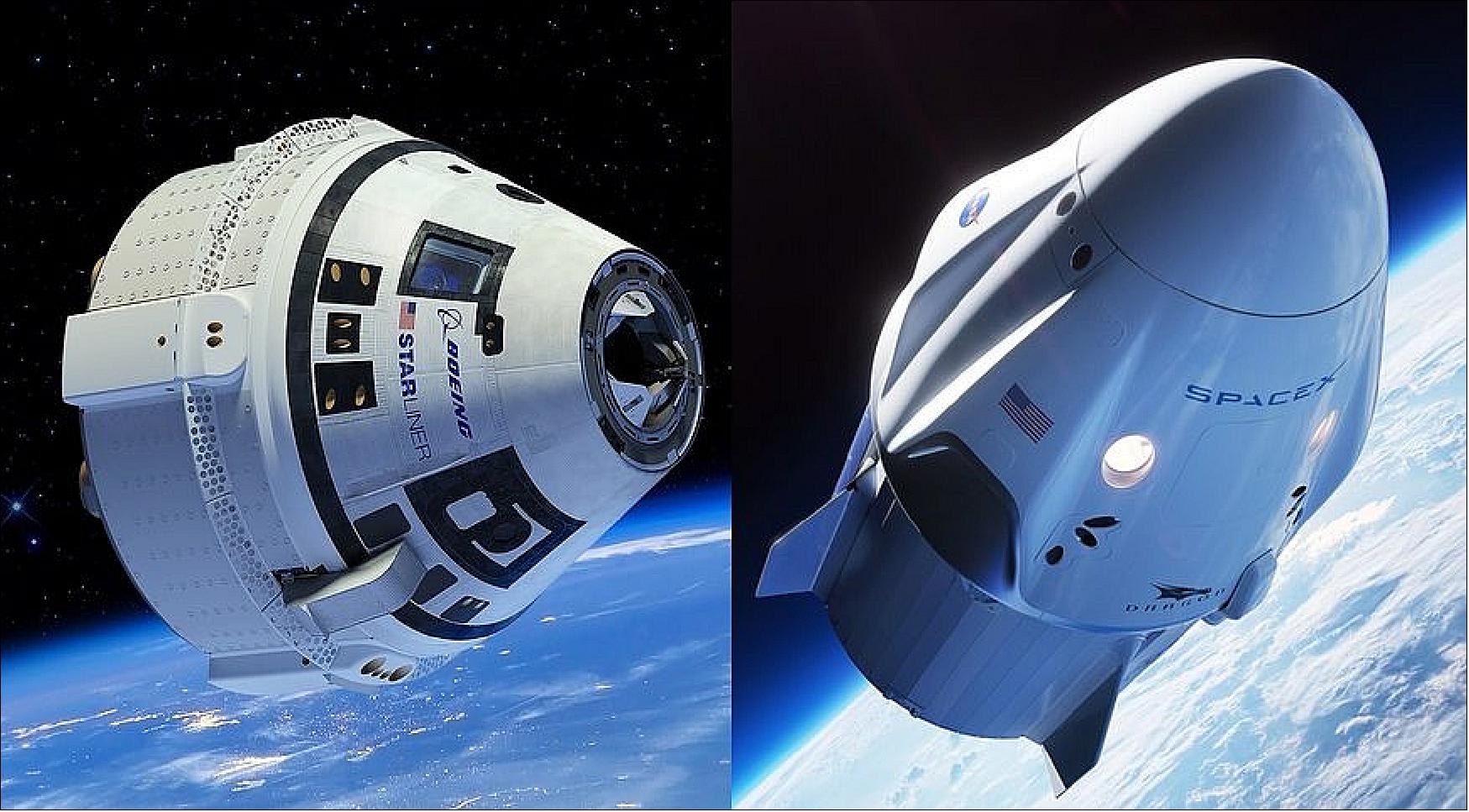
- That mission, called the Orbital Flight Test (OFT) by Boeing, will send the Starliner to the International Space Station, docking with the station and remaining there for about a week before undocking and landing at one of several locations in the western United States. Mulholland said that if the mission launches as currently scheduled, the landing would most likely be at White Sands Missile Range in New Mexico.
- Boeing had planned to fly OFT earlier this year, but announced in April it was delaying the launch, then scheduled for May, until later in the summer because of a tight schedule and a conflict with another Atlas 5 launch.
• May 24, 2019: Boeing’s CST-100 Starliner propulsion system was put to the test on Thursday at NASA’s White Sands Test Facility in New Mexico in support of NASA’s Commercial Crew Program. Teams ran multiple tests on Starliner’s in-space maneuvering system and the spacecraft’s launch abort system, which are key elements on the path to restore America’s capability to fly astronauts to the International Space Station on American rockets and spacecraft from U.S. soil. 40)
- The test used a flight-like Starliner service module with a full propulsion system comprising of fuel and helium tanks, reaction control system and orbital maneuvering and attitude control thrusters, launch abort engines and all necessary fuel lines and avionics.
During the test:
a) 19 thrusters fired to simulate in-space maneuvers.
b) 12 thrusters fired to simulate a high-altitude abort.
c) 22 propulsion elements, including the launch abort engines, fired to simulate a low-altitude abort.
- Boeing’s Starliner will launch on a United Launch Alliance Atlas V rocket from Space Launch Complex-41 at Cape Canaveral Air Force Station in Florida. The company will complete a Starliner pad abort test and uncrewed flight test, called Orbital Flight Test, to the station ahead of the first flight test with a crew onboard. As commercial crew providers, Boeing and SpaceX, begin to make regular flights to the space station, NASA will continue to advance its mission to go beyond low-Earth orbit and establish a human presence on the Moon with the ultimate goal of sending astronauts to Mars.
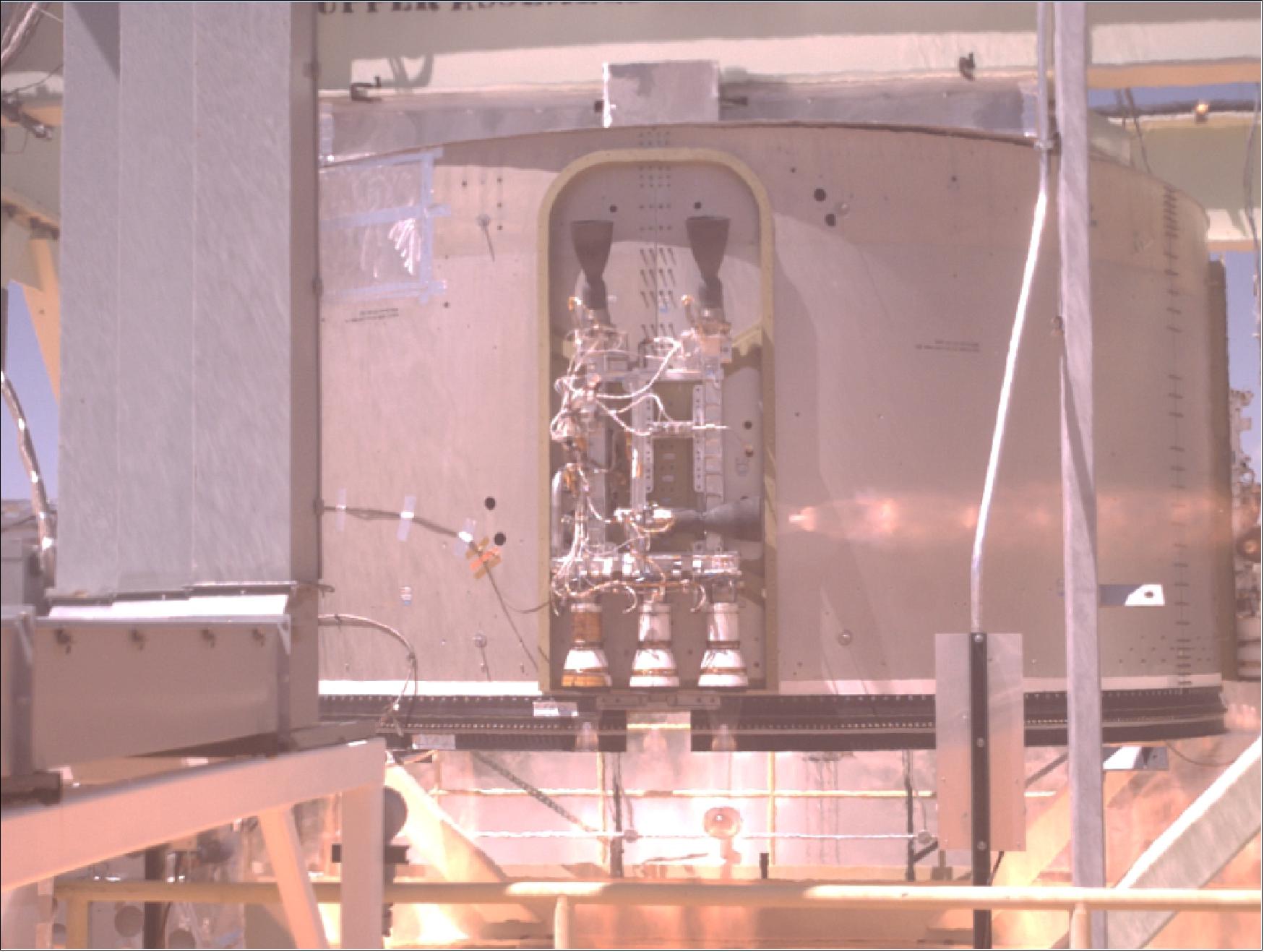
• March 18, 2018: Aerojet Rocketdyne recently completed delivery of all of the crew module engines for Boeing's Crew Space Transportation (CST)-100 Starliner spacecraft. Boeing will integrate the engines into the Starliner crew module at its Commercial Crew and Cargo Processing Facility at NASA's Kennedy Space Center in Florida. 41)
- The Starliner crew module is designed to transport up to seven passengers or a mix of crew and cargo for missions to low-Earth orbit destinations. Developed in partnership with NASA's Commercial Crew Program, the Starliner will carry up to four astronauts to and from the International Space Station for NASA missions.
• January 4, 2018: NASA and industry partners, Boeing and SpaceX, are targeting the return of human spaceflight from Florida’s Space Coast in 2018. Both companies are scheduled to begin flight tests to prove the space systems meet NASA’s requirements for certification in the coming year. 42)
- Since NASA awarded contracts to Boeing and SpaceX, the companies have matured space system designs and now have substantial spacecraft and launch vehicle hardware in development and testing in preparation for the test flights. The goal of the Commercial Crew Program is safe, reliable and cost-effective transportation to and from the International Space Station from the United States through a public-private approach. NASA, Boeing and SpaceX have significant testing underway, which will ultimately lead to test missions when the systems are ready and meet safety requirements.
- Boeing’s Starliner will launch on a United Launch Alliance Atlas V rocket from Space Launch Complex 41 and SpaceX’s Crew Dragon will launch on the company’s Falcon 9 rocket from Launch Complex 39A.
- After completion of each company’s uncrewed and crewed flight tests, NASA will review the flight data to verify the systems meet the requirements for certification. Upon NASA certification, the companies are each slated to fly six crew missions to the International Space Station beginning in 2019 and continuing through 2024.
- Spacecraft: In 2018, Boeing will continue with the production and outfitting of three crew modules and multiple service modules inside the Commercial Crew and Cargo Processing Facility at NASA’s Kennedy Space Center in Florida. Boeing already has a structural version of its spacecraft going through loads, shock and separation test events in Huntington Beach, California. It will conduct a series of service module hot-fire tests in White Sands, New Mexico, as well as environmental testing to include thermal, vacuum and electromagnetic frequency in El Segundo, California.
- Spacesuit: Boeing’s spacesuit will continue to undergo integrated system verification tests. These include environmental control and life support system testing, immersing the suit in water, egress demos with the aid of virtual reality, suited launch and landing cabin operations, prelaunch emergency exit with ground crews, ascent simulations with mission operations teams and post-landing egress.
- Engine Testing: Boeing and Aerojet Rocketdyne will finish qualification testing of the launch abort engines and thrusters that will power the Starliner through the pad abort, uncrewed and crew flight tests. Each of the four launch abort engines and 48 thrusters is tested at the White Sands Test Facility in New Mexico prior to installation on the service module.
- Parachute Testing: Boeing will continue with the Starliner’s parachute test program in 2018. To date, Boeing has completed two of five planned qualification tests. The testing involves a giant helium-filled balloon that lifts a full-size version of the spacecraft over the desert in New Mexico before releasing it. The spacecraft climbs more than 300 m per minute before it is dropped from an altitude of about 12 km. A choreographed parachute deployment sequence initiates, involving two drogue, three pilot and three main chutes that slow the spacecraft enough for a safe touchdown on land. Additional parachute testing with a long-dart shaped vehicle released from a C-17 aircraft near Yuma, Arizona, is also scheduled to begin next year.
- Pad Abort Test: In 2018, Boeing will complete an uncrewed pad abort test at White Sands Missile Range in New Mexico to demonstrate the ability of the Starliner to safely accomplish an emergency escape of the capsule and its crew members from a rocket. During the test, four launch abort engines and 20 orbital maneuvering engines will fire to simulate an abort from the Atlas V rocket on the launch pad. Together, the engines produce about 188,000 pounds of thrust for about six seconds to push the spacecraft to one mile in altitude to clear the launch vehicle in an emergency. At the proper time in the abort sequence, the service module will separate from the crew module so that it can parachute down to a safe landing.
- Orbital Flight Test: Following launch from Space Launch Complex 41, the uncrewed Starliner will dock to the International Space Station. After about two weeks connected to the station during which the teams will gather extensive performance data, the spacecraft will return to Earth under parachutes to land in the Western United States. The test will demonstrate the launch vehicle, Starliner, the ground system and the Boeing team are ready to perform a crew flight test.
- Crew Flight Test: Two crew members will be aboard the Starliner for Boeing’s first commercial spaceflight to the International Space Station. The spacecraft will launch atop a United Launch Alliance Atlas V rocket from Space Launch Complex 41 and land again in the western United States. The mission will represent a major milestone in the return of human spaceflight from the United States. After the test and NASA certification, Boeing’s Starliner can begin regularly flying astronauts to and from the space station on NASA missions.
- Recovery Training: Boeing, NASA, and the Department of Defense will conduct rehearsals of crew recovery training during the coming year. The final full scale rehearsal tests will simulate astronaut returns to Earth in the Western region of the United States. Boeing’s Starliner is designed to land on land, but testing is also being conducted to prepare for water landings in case of an emergency.
Launch
The uncrewed Boeing Starliner spacecraft lifted off aboard a ULA Atlas V rocket on Dec. 20, 2019 at 6:36 a.m. EST (11.36 UTC), from Space Launch Complex 41 at Cape Canaveral Air Force Station in Florida on a flight test to the International Space Station. The Starliner did not reach the planned orbit and will not dock to the space station. Teams worked quickly to ensure the spacecraft was in a stable orbit and preserved enough fuel to ensure a landing opportunity. Boeing, in coordination with NASA, is working to return Starliner to land in White Sands, New Mexico on Sunday, Dec. 22. 43)
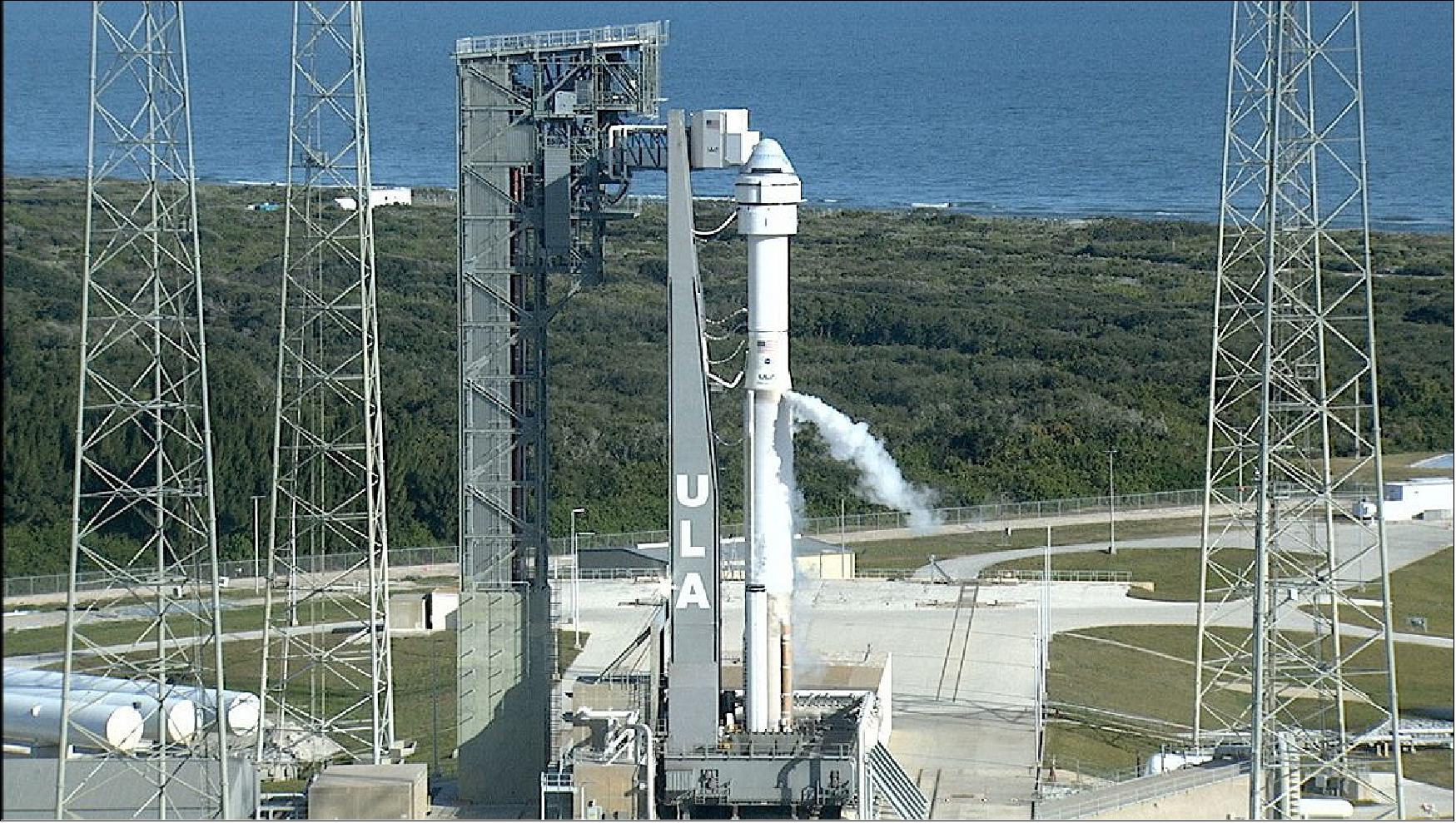
Orbit: Near circular orbit, altitude of ~400 km, inclination = 51.6º.
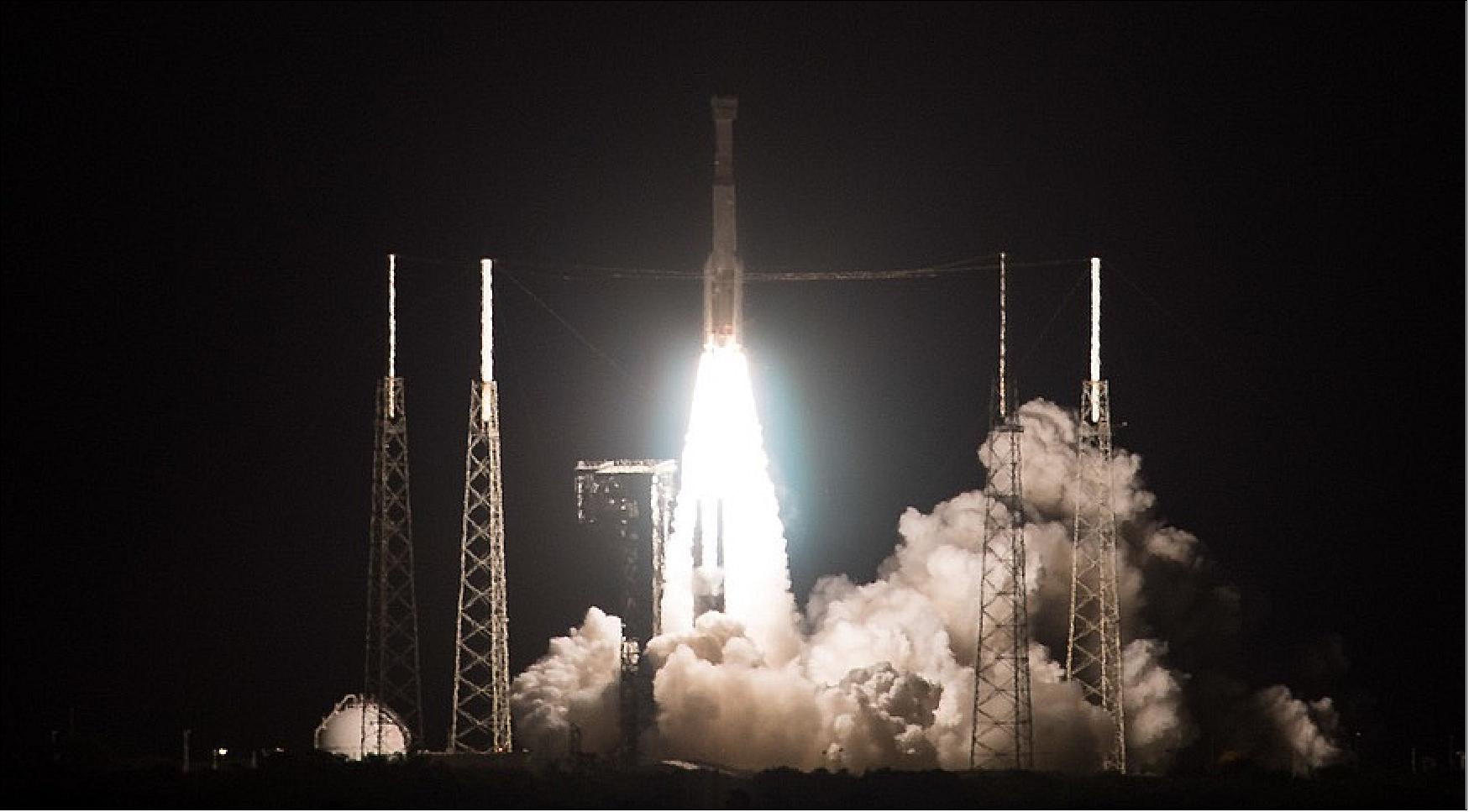
• December 20, 2019: The Starliner spacecraft separated from the Centaur nearly 15 minutes after liftoff, having been placed into a suborbital trajectory designed to permit safe aborts for the Starliner during ascent. Four orbital maneuvering and attitude control thrusters on the Starliner were scheduled to fire 31 minutes after liftoff to put the spacecraft into an initial orbit. 44)
- However, that burn did not take place as planned. NASA and Boeing commentators said the spacecraft suffered an “off-nominal” orbital insertion and was in a “stable” orbit with electrical power, but didn’t specify the orbital parameters. Spacecraft controllers “are assessing options,” they said.
- “Boeing’s CST-100 Starliner is not in its planned orbit. The spacecraft currently is in a stable configuration while flight controllers are troubleshooting,” NASA said in a brief statement. NASA Administrator Jim Bridenstine tweeted that a thruster burn did not take place but that the spacecraft was in a stable orbit.
- Bridenstine later tweeted that the problem was a “Mission Elapsed Time (MET) anomaly” with Starliner, “causing the spacecraft to believe that it was in an orbital insertion burn, when it was not.” The spacecraft, he said, consumed more fuel than expected, precluding a docking with the International Space Station.
- This mission, formally unknown as Orbital Flight Test (OFT), is a key test of the spacecraft before carrying people, and is similar to the Demo-1 mission that SpaceX’s Crew Dragon spacecraft flew in March. A successful OFT would allow a crewed flight to take place some time in 2020, although both NASA and Boeing officials have been hesitant to estimate a more precise date until after the OFT mission ends.
• December 22, 2019: In retrospect, it was discovered that the capsule started its flight with an 11-hour error in its mission elapsed timer setting, triggering a cascading series of problems that led to the Starliner burning too much fuel to reach the space station and deliver its cargo. 45)
Mission control uplinked commands for the spacecraft to perform a series of burns with its smaller thrusters to reach a stable, but unplanned orbit, but the ship was no longer in a position to reach the space station.
Hence, the unpiloted demonstration flight of Boeing’s Starliner crew capsule ended prematurely on Sunday (Dec. 22) with a smooth airbag-cushioned predawn landing in New Mexico after a timing glitch prevented it from docking with the International Space Station, leaving some test objectives incomplete as NASA begins analyzing data to determine if astronauts should fly on the next Starliner mission.
NASA, Boeing Complete Successful Landing of Starliner Flight Test — and Inspection
• March 7, 2020: A review team studying software glitches and other miscues that cropped up during an unpiloted test flight of Boeing’s Starliner (CST-100) crew capsule last December has made some 60 recommendations to make sure all the known shortcomings are addressed before the spacecraft is cleared for another flight, NASA managers said Friday. 46)
- During the December test flight, a major software error, coupled with communications dropouts, prevented a planned rendezvous and docking with the International Space Station. Another software mistake could have caused a catastrophic failure during the capsule’s return to Earth had it not been caught in time.
- Douglas Loverro, director of spaceflight at NASA Headquarters, told reporters Friday he classified the incidents as a “high-visibility close call,” a formal designation that kicks off additional government review. In the meantime, he said the agency will make sure the review team’s recommendations are implemented.
- It’s not clear how long that may take. Loverro said he did not yet know whether NASA might require a second unpiloted orbital flight test, or OFT, to verify the performance of all of the CST-100 Starliner’s systems, or whether Boeing could develop a rationale for pressing straight ahead to a crewed flight test to the International Space Station.
- “Quite frankly, right now we don’t know,” Loverro said. “They have to now come back to NASA with a plan, how they’re going to go ahead and address all of those (recommendations). .... We will do our own inspection of the results of their work. And then we’ll be in a position to decide whether or not we need another (uncrewed) test flight or not.
- “So we are still a ways away from that. And I can’t even tell you what the schedule is for making that decision, because it’s very dependent upon what we see as Boeing’s corrective action plan and the thoroughness by which we believe that correction action plan has been implemented.”
- Jim Chilton, senior vice president at Boeing Space and Launch, said the company will do whatever NASA asks. The company told investors earlier that it was taking a $410 million charge against pre-tax earnings in large part to cover the possible cost of another test flight.
- “For us, it’s not that complicated,” he said. “Boeing stands ready to repeat an OFT (if required). .... There’s not any intent on our part to avoid it. We just want to make sure that whatever we fly next is aligned with NASA’s preferences. And of course for all of us, crew safety is number one.”
• February 27, 2020: Boeing's decision to break up tests of its Starliner space capsule flight software into segments was a major reason the craft failed to reach the International Space Station in December, company Vice president John Mulholland said Friday. 47)
- Boeing made the ill-fated decision to skip end-to-end software tests for the entire length of its Starliner space capsule flight to the International Space, breaking the flight into segments for testing instead.
- One of the tests ended at the point where the capsule separated from Atlas V rocket, which meant they missed a flaw that caused the capsule to utilize erroneous data about the mission clock, he said.
- "From a hindsight standpoint, it's very easy to see what we should have done because we uncovered an error," Mulholland said. "This is a tough business. It's a game of inches."
- He said the decision to break up flight software testing was "definitely not a matter of cost," but was done because engineers thought it was logical to avoid running the entire flight at once — which would have taken about 25 continuous hours of testing.
- In the future, the company will run the full launch-to-docking scenario, and then another complete test from undocking to landing, Mulholland said.
- NASA is preparing to announce the results March 6 of a two-month investigation by a joint, independent team into the flight failure.
- Boeing and competitor SpaceX, are years behind schedule developing a new spacecraft to carry people. SpaceX successfully tested its Crew Dragon capsule last year in a flight to the space station, and is expected to launch astronauts before mid-2020.
- Starliner was launched Dec. 20 , 2019 without a crew, and the problem with its mission clock caused it to burn fuel needlessly. That meant it wasn't able to reach the orbit necessary to catch up with the space station.
- Despite the problem, Boeing and NASA said the test mission accomplished most of its goals. Initial data showed the capsule was a safe environment in which to carry people.
- However, investigations into the mission also showed additional software problems that could have caused a more catastrophic failure. Mulholland said the company still is working through the problems, but the longer tests would have detected them.
- NASA said data from the uncrewed test flight is essential for certification, but other ways might exist to demonstrate the capsule's full capabilities.
- "NASA is evaluating the data received during the mission to determine if another uncrewed demonstration is required," the agency said in January.
- The probe also comes as a federal watchdog, the Aerospace Safety Advisory Panel, said NASA needs a new approach to investigating private contractors like Boeing and SpaceX. That's because NASA is relying more on those contractors than ever before.
- The Starliner capsule that flew is being refurbished at the Commercial Crew and Cargo Processing Facility at Kennedy Space Center in Florida.
• February 7, 2020: Following the anomaly that occurred during the December Boeing Starliner Orbital Fight Test (OFT), NASA and Boeing formed a joint investigation team tasked with examining the primary issues, which occurred during that test. Those issues included three specific concerns revealed during flight: 48)
1) An error with the Mission Elapsed Timer (MET), which incorrectly polled time from the Atlas V booster nearly 11 hours prior to launch.
2) A software issue within the Service Module (SM) Disposal Sequence, which incorrectly translated the SM disposal sequence into the SM Integrated Propulsion Controller (IPC).
3) An Intermittent Space-to-Ground (S/G) forward link issue, which impeded the Flight Control team’s ability to command and control the vehicle.
- The joint investigation team convened in early January and has now identified the direct causes and preliminary corrective actions for the first two anomalies. The intermittent communications issues still are under investigation. NASA reviewed these results on Friday, Jan. 31 along with multiple suggested corrective actions recommended by the team. While NASA was satisfied that the team had properly identified the technical root cause of the two anomalies, they requested the team to perform a more in-depth analysis as to why the anomalies occurred, including an analysis of whether the issues were indicative of weak internal software processes or failure in applying those processes. The team is in the process of performing this additional analysis, as well as continuing the investigation of the intermittent communications issues. NASA briefed the Aerospace Safety Advisory Panel on the status of the investigation this week.
- Regarding the first two anomalies, the team found the two critical software defects were not detected ahead of flight despite multiple safeguards. Ground intervention prevented loss of vehicle in both cases. Breakdowns in the design and code phase inserted the original defects. Additionally, breakdowns in the test and verification phase failed to identify the defects preflight despite their detectability. While both errors could have led to risk of spacecraft loss, the actions of the NASA-Boeing team were able to correct the issues and return the Starliner spacecraft safely to Earth.
- There was no simple cause of the two software defects making it into flight. Software defects, particularly in complex spacecraft code, are not unexpected. However, there were numerous instances where the Boeing software quality processes either should have or could have uncovered the defects. Due to these breakdowns found in design, code and test of the software, they will require systemic corrective actions. The team has already identified a robust set of 11 top-priority corrective actions. More will be identified after the team completes its additional work.
- The joint team made excellent progress for this stage of the investigation. However, it’s still too early for us to definitively share the root causes and full set of corrective actions needed for the Starliner system. We do expect to have those results at the end of February, as was our initial plan. We want to make sure we have a comprehensive understanding of what happened so that we can fully explain the root causes and better assess future work that will be needed. Most critically, we want to assure that these necessary steps are completely understood prior to determining the plan for future flights. Separate from the anomaly investigation, NASA also is still reviewing the data collected during the flight test to help determine that future plan. NASA expects a decision on this review to be complete in the next several weeks.
- NASA and Boeing are committed to openly sharing the information related to the mission with the public. Thus, NASA will be holding a media teleconference at 3:30 p.m. EST Friday, Feb. 7.
- In addition to these reviews, NASA is planning to perform an Organizational Safety Assessment of Boeing’s work related to the Commercial Crew Program. The comprehensive safety review will include individual employee interviews with a sampling from a cross section of personnel, including senior managers, mid-level management and supervision, and engineers and technicians at multiple sites. The review would be added to the company’s Commercial Crew Transportation Capability contract. NASA previously completed a more limited review of the company. The goal of the Organizational Safety Assessment will be to examine the workplace culture with the commercial crew provider ahead of a mission with astronauts.
- Boeing’s Orbital Flight test launched on Friday, Dec. 20, on United Launch Alliance Atlas V rocket from Space Launch Complex 41 at Cape Canaveral Air Force Station in Florida. The mission successfully landed two days later on Sunday, Dec. 22, completing an abbreviated test that performed several mission objectives before returning to Earth as the first orbital land touchdown of a human-rated capsule in U.S. history.
• January 15, 2020: While NASA and Boeing engineers investigate the cause of a software error that cut short the first orbital test flight of the Starliner crew capsule last month, ground teams have returned the spaceship from its landing site in New Mexico back to the Kennedy Space Center in Florida. 49)
- Preliminary inspections indicate the reusable spacecraft weathered its first trip into orbit better than expected, and Boeing teams are confident the ship will need only “minimal refurbishment” before its next launch with astronauts.
- While teams sort out the Starliner software problem, Boeing says the hardware performed as designed.
- “It’s in really good shape, very little external wear on the outside,” said Tim Reith, spacecraft engineering manager for Boeing’s Starliner program.
- “The team built an awesome vehicle,” said Ramon Sanchez, senior operations lead for Boeing’s commercial crew program.
- “For the most part, the vehicle performed very well, and we’re looking at minimal refurbishment to return this thing to flight,” Sanchez told reporters Wednesday during a media briefing inside Boeing’s Commercial Crew and Cargo Processing Facility at NASA’s Kennedy Space Center in Florida.
- The capsule landed on 22 December 2019 at White Sands Space Harbor in New Mexico, descending under parachutes before deploying airbags to cushion its touchdown in the remote desert. The unpiloted Orbital Test Flight lifted off Dec. 20 aboard a United Launch Alliance Atlas 5 rocket from Cape Canaveral, but a timing error in the Starliner’s software that went undiscovered before launch caused the spacecraft to miss a planned orbital insertion burn.
- The insertion burn was planned a few minutes after the Atlas 5’s Centaur upper stage deployed the Starliner spacecraft on a trajectory with a velocity just shy of that needed to enter a stable orbit. The Atlas 5 put the Starliner where it needed to be, and the Boeing capsule’s orbital maneuvering rockets were supposed to ignite to boost the spaceship into a preliminary orbit to begin its pursuit of the space station.
- But an on-board mission elapsed timer had a wrong setting, causing the Starliner spacecraft’s computers to believe the capsule was operating in a different phase of its mission. The capsule’s service module began firing maneuvering thrusters to control the vehicle’s pointing, consuming much of the craft’s fuel and causing it to miss the automated orbit insertion burn.
- The spacecraft was trying to perform two functions at the same time time, Reith said.
- “That’s where the vehicle got a little confused,” he said. “The orbit insertion, which the vehicle thought had already happened in the past, it was trying to prepare for that, as well as do some pointing guidance, and those two events were kind of in conflict with each other.
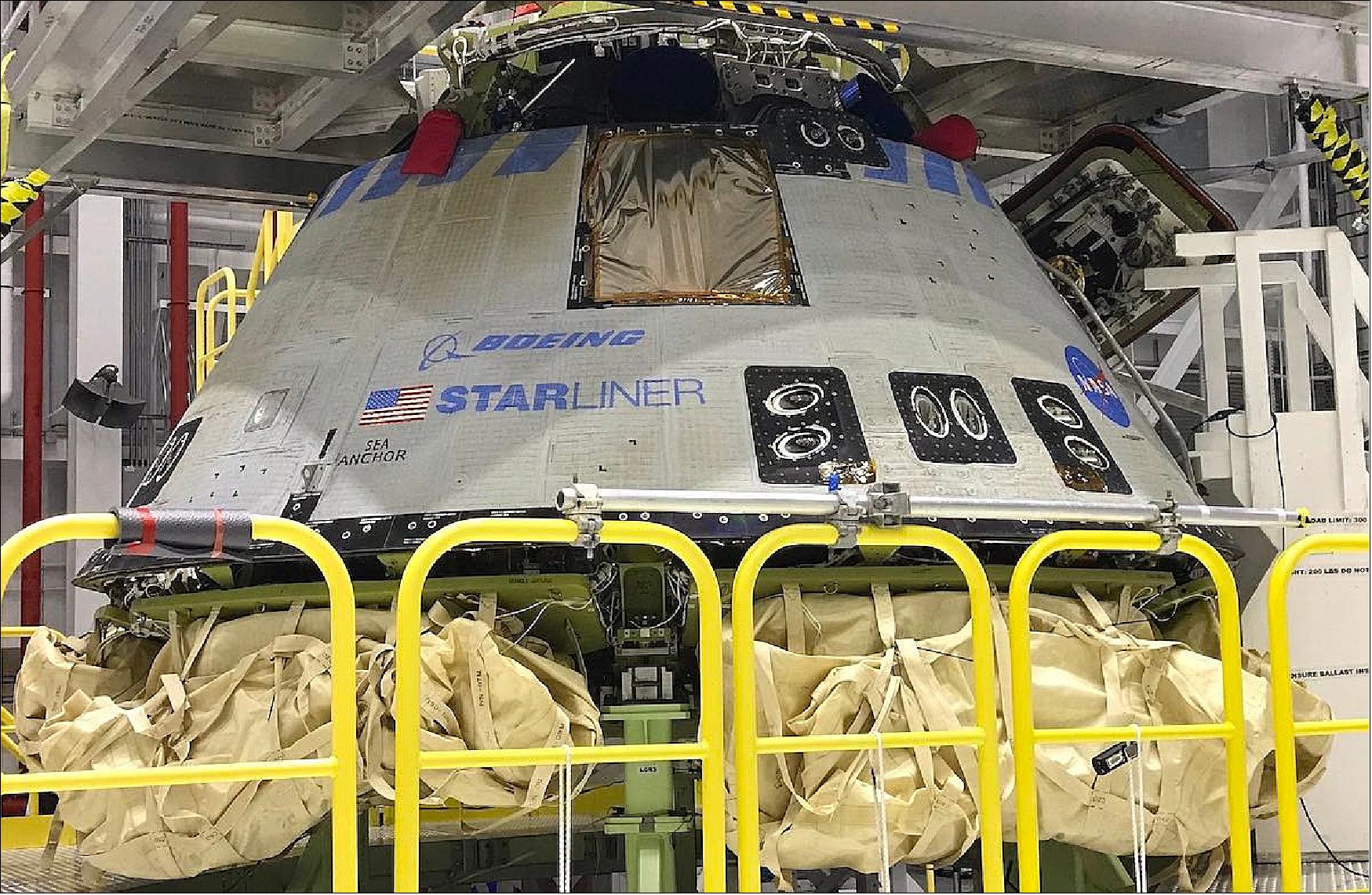
- “That’s were we had the vehicle kind of fighting itself, if you will, and the thruster firings going,” Reith said. “You’ve got multiple software sequences running, so that’s where it got confused with multiple things going on at the same time.
- Ground controllers noticed the problem and tried to intervene, but commands to override the Starliner’s automation did not reach the spacecraft in time to perform the planned orbit insertion burn and keep the mission on track to dock with the International Space Station.
- “Everything’s automated, so the vehicle should have started moving itself toward this orbit insertion burn,” Reith said. “When that wasn’t happening, the flight control team in Houston and the engineering support teams around the country, we were able to figure that out pretty quick.
- “It was very intense,” said Reith, who also served as spacecraft chief engineer in the Starliner mission support room during last month’s mission. “You also have to remember this was the first time we’d seen it fly, so you have an expectation of what should happen, but at the same time you’re not sure what it’s going to do. So as you’re seeing things for the first time, you’re trying to understand is that what it should be doing, or is there something anomalous going on?”
- “Essentially, there are two opportunities for us to prepare for that orbit insertion burn,” he said. “When the first opportunity missed, and at the same time we were watching the telemetry from the vehicle with a lot of thruster firings, you start realizing, OK, something’s not right. So the flight control team attempted to send commands, and the vehicle wasn’t in a really good orientation from an antenna standpoint to receive those commands. So it kind of went on for a while until we got the antennas where we could get a good command to the vehicle. Once we got that command uplinked, we were able to turn the vehicle and do that orbit insertion burn that at least raised it up a little bit. But by that time we had expended a lot of propellant.”
- Instead of performing the pre-programmed insertion burn, the Starliner fired its engines to reach a stable orbit that ensured the capsule could safely return to Earth. By that time, the capsule had consumed too much propellant to complete the required burns to pursue the space station and perform a docking.
- “We had full control of the vehicle,” Reith said. “It didn’t tumble or anything like that.”
- The original eight-day flight plan, which included demonstration maneuvers and a docking with the space station, was shortened to two days. The capsule successfully landed in New Mexico, achieving many — but not all — of the planned objectives of Boeing’s Orbital Flight Test.
- The demonstration mission was a precursor to the first planned Starliner mission with astronauts — known as the Crew Flight Test — scheduled to launch later this year.
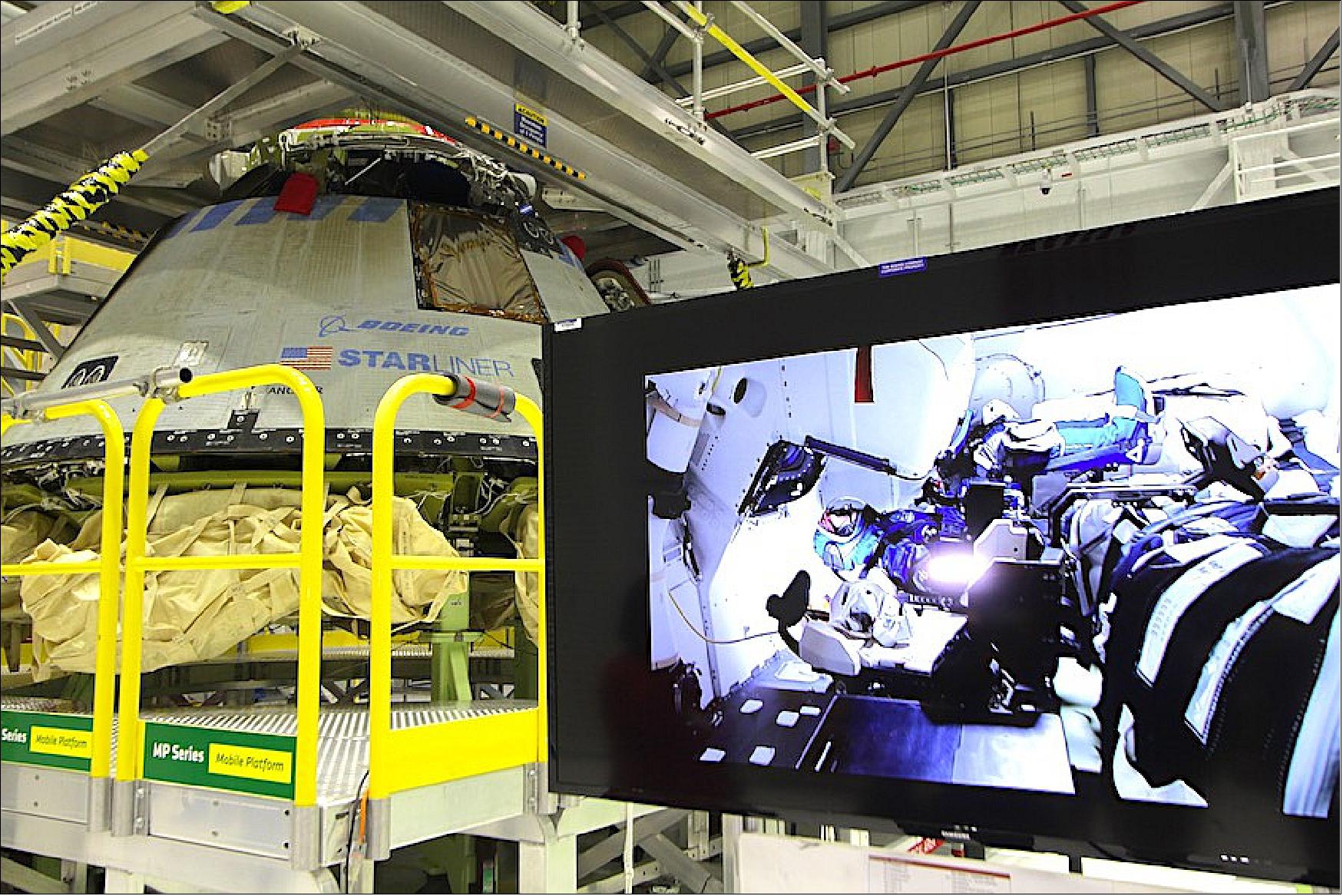
- Boeing technicians are assembling a separate Starliner spacecraft for the CFT (Crew Flight Test). Located in an integration cell just a stone’s throw away from the Starliner that just returned from space, the CFT capsule will carry Boeing astronaut Chris Ferguson and NASA crewmates Mike Fincke and Nicole Mann to the space station.
- Boeing has produced two reusable human-rated spaceships — each designed for 10 missions — for flights to the space station under a $4.2 billion contract with NASA. The space agency has signed a similar $2.6 billion contract with SpaceX in 2014 for development of the Crew Dragon spacecraft, on which astronauts will fly new vehicles on each mission.
- The CFT mission with Ferguson’s crew will pave the way for operational crew rotation flights to the station, the first of which will be commanded by NASA astronaut Suni Williams, a veteran of two long-duration space station expeditions. Williams is slated to launch and land on the same capsule that flew on last month’s two-day demonstration mission.
- She named the spacecraft “Calypso” after its Dec. 22 landing in honor of the research vessel used by French explorer Jacques Cousteau.
- The planned Starliner flight sequence hinges on the outcome of an investigation into the cause of the software error that prevented the Calypso spacecraft from docking with the space station last month.
- “The independent team will inform NASA and Boeing on the root cause of the mission elapsed timer anomaly and any other software issues and provide corrective actions needed before flying crew to the International Space Station for the agency’s Commercial Crew Program,” wrote NASA Administrator Jim Bridenstine on the space agency’s website Jan. 7.
- The investigation is expected to last about two months, according to Bridenstine.
- The NASA boss said agency officials are evaluating data from the Starliner’s Orbital Flight Test to determine if another unpiloted demonstration flight is required before the capsule is cleared to launch with astronauts. A decision on that matter is not expected for several weeks, Bridenstine wrote.
- ”Although docking was planned, it may not have to be accomplished prior to the crew demonstration,” he wrote. “Boeing would need NASA’s approval to proceed with a flight test with astronauts on-board.”
- After the Starliner’s landing Dec. 22, Boeing teams secured the spacecraft and transported it via truck from New Mexico back to the Kennedy Space Center, where it arrived Jan. 8.
- “Currently, it’s under assessment by ... many of our experts,” Sanchez said Wednesday. “We have got the hatch door open. We will take an assessment of the exterior of the vehicle.
- “We have to make sure the interior is flight-ready,” Sanchez said. “It’s an awesome vehicle, well-built with safety and quality in mind.”
- The Starliner spacecraft includes two segments — a crew module and a service module — for the trip to the International Space Station. After departing the station and performing a braking burn to re-enter the atmosphere, the crew module jettisons the service module to burn up over the Pacific Ocean.
- The crew module is fitted with an ablative base heat shield, thermal tiles, and protective blankets to withstand the scorching temperatures as hot as 3,000º Fahrenheit (1,650º Celsius) during re-entry. The capsule jettisons a forward heat shield at the start of its parachute deployment sequence, then releases the base heat shield to plunge to the ground, allowing airbags to inflate to soften the crew module’s landing.
- That means each Starliner mission will fly with a new service module, and new forward and base heat shield elements. Teams will also have to re-pack parachutes and replace the mortars that fire to unfurl the chutes during descent, and an ascent fairing that covers the Starliner docking module will also come new with each mission, according to Sanchez.
- According to Reith, a manager on the Starliner engineering team, the reusable thermal blankets on the “backshell” panels around the circumference of the Starliner spacecraft showed little sign of damage from the re-entry.
- “You can see on the front — the hot side or leading edge side of the vehicle where the tiles are — you see a little deposit there,” Reith said. “We’ll go through and clean that up,” Reith said. “That should come right off.
- “There’s a dark diagonal stripe up the vehicle,” Reith told reporters Wednesday. “There’s a matching one on the other side. That’s where the plasma flow is. It comes around the vehicle ... So as it was picking up ablation off the base heat shield, it streaked up there and left that deposit.
- “We’ve got high expectation that’s going to come right off, so we’ll be able to clean this vehicle up and get it to near factory-fresh (condition) again for its next mission” Reith said.
- “Right now, the team is doing their external inspections,” Reith said. “We’ve had teams in looking at the top where the NASA docking system is. They’ve done all their inspections looking at that, and also the thermal protection system team, they’ve been looking at the blankets, the tiles we have.
- “Once they’re done with their work, we’ll go ahead and take the backshell panels off,” he said. “These are the gray panels that enclose all of the equipment inside .... Then we’ll start doing our inspections on the inside. At the same time we’ll be starting to take the cargo (that was to be delivered to the space station) off, Rosie will come off, and then we’ll start our refurbishment of the inside of the vehicle getting ready for the next mission.”
- Reith said Boeing teams will also remove the airbags from the bottom of the crew module to check for damage. The airbags are also designed to be reused on future flights.
- “It looks really clean from a standpoint of the wear-and-tear it took coming through re-entry,” Reith said. “Our TPS (Thermal Protection System) team is really, really surprised. They expected more blanket wear, more deposits. They’re really happy with the way the vehicle performed.”
• January 7, 2020: NASA and Boeing are in the process of establishing a joint, independent investigation team to examine the primary issues associated with the company’s uncrewed Orbital Flight Test. 50)
The independent team will inform NASA and Boeing on the root cause of the mission elapsed timer anomaly and any other software issues and provide corrective actions needed before flying crew to the International Space Station for the agency’s Commercial Crew Program. The team will review the primary anomalies experienced during the Dec. 2019 flight test, any potential contributing factors and provide recommendations to ensure a robust design for future missions. Once underway, the investigation is targeted to last about two months before the team delivers its final assessment.
In parallel, NASA is evaluating the data received during the mission to determine if another uncrewed demonstration is required. This decision is not expected for several weeks as teams take the necessary time for this review. NASA’s approach will be to determine if NASA and Boeing received enough data to validate the system’s overall performance, including launch, on-orbit operations, guidance, navigation and control, docking/undocking to the space station, reentry and landing. Although data from the uncrewed test is important for certification, it may not be the only way that Boeing is able to demonstrate its system’s full capabilities.
In parallel, NASA is evaluating the data received during the mission to determine if another uncrewed demonstration is required. This decision is not expected for several weeks as teams take the necessary time for this review. NASA’s approach will be to determine if NASA and Boeing received enough data to validate the system’s overall performance, including launch, on-orbit operations, guidance, navigation and control, docking/undocking to the space station, reentry and landing. Although data from the uncrewed test is important for certification, it may not be the only way that Boeing is able to demonstrate its system’s full capabilities.
Starliner currently is being transported from the landing location near the U.S. Army’s White Sands Missile Range to the company’s Commercial Crew and Cargo Processing Facility in Florida. Since landing, teams have safed the spacecraft for transport, downloaded data from the spacecraft’s onboard systems for analysis and completed initial inspections of the interior and exterior of Starliner. A more detailed analysis will be conducted after the spacecraft arrives at its processing facility.
Boeing’s Orbital Flight test launched on Friday, Dec. 20, on United Launch Alliance Atlas V rocket from Space Launch Complex 41 at Cape Canaveral Air Force Station in Florida. The mission successfully landed two days later on Sunday, Dec. 22, completing an abbreviated test that performed several mission objectives before returning to Earth as the first orbital land touchdown of a human-rated capsule in U.S. history.
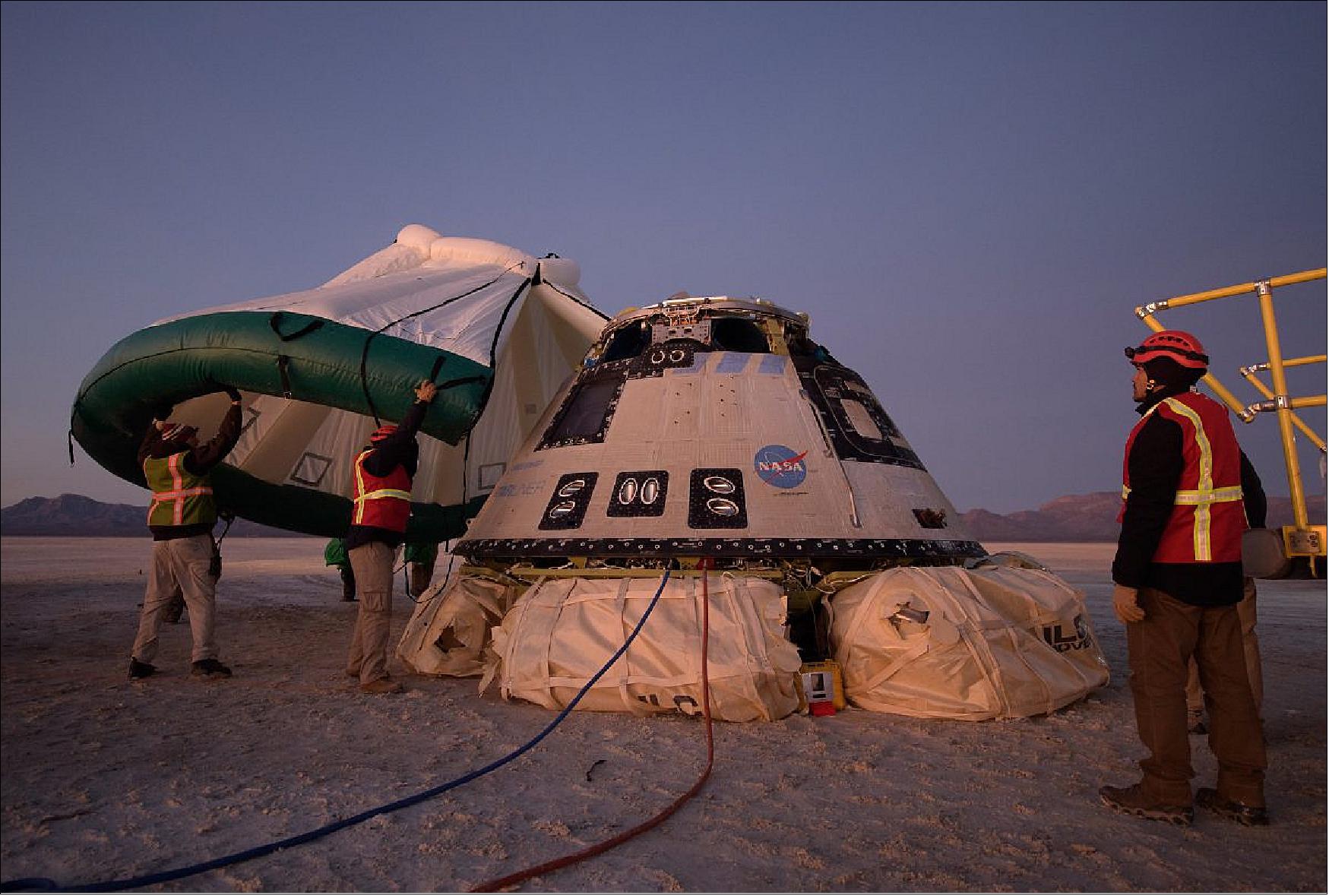
• December 22, 2019: Boeing’s CST-100 Starliner spacecraft completed the first land touchdown of a human-rated capsule in U.S. history Sunday at White Sands Space Harbor in New Mexico, wrapping up the company’s uncrewed Orbital Flight Test as part of NASA’s Commercial Crew Program. 51)
Starliner settled gently onto its airbags at 7:58 a.m. EST (5:58 a.m. MST) in a pre-dawn landing that helps set the stage for future crewed landings at the same site. The landing followed a deorbit burn at 7:23 a.m., separation of the spacecraft’s service module, and successful deployment of its three main parachutes and six airbags.
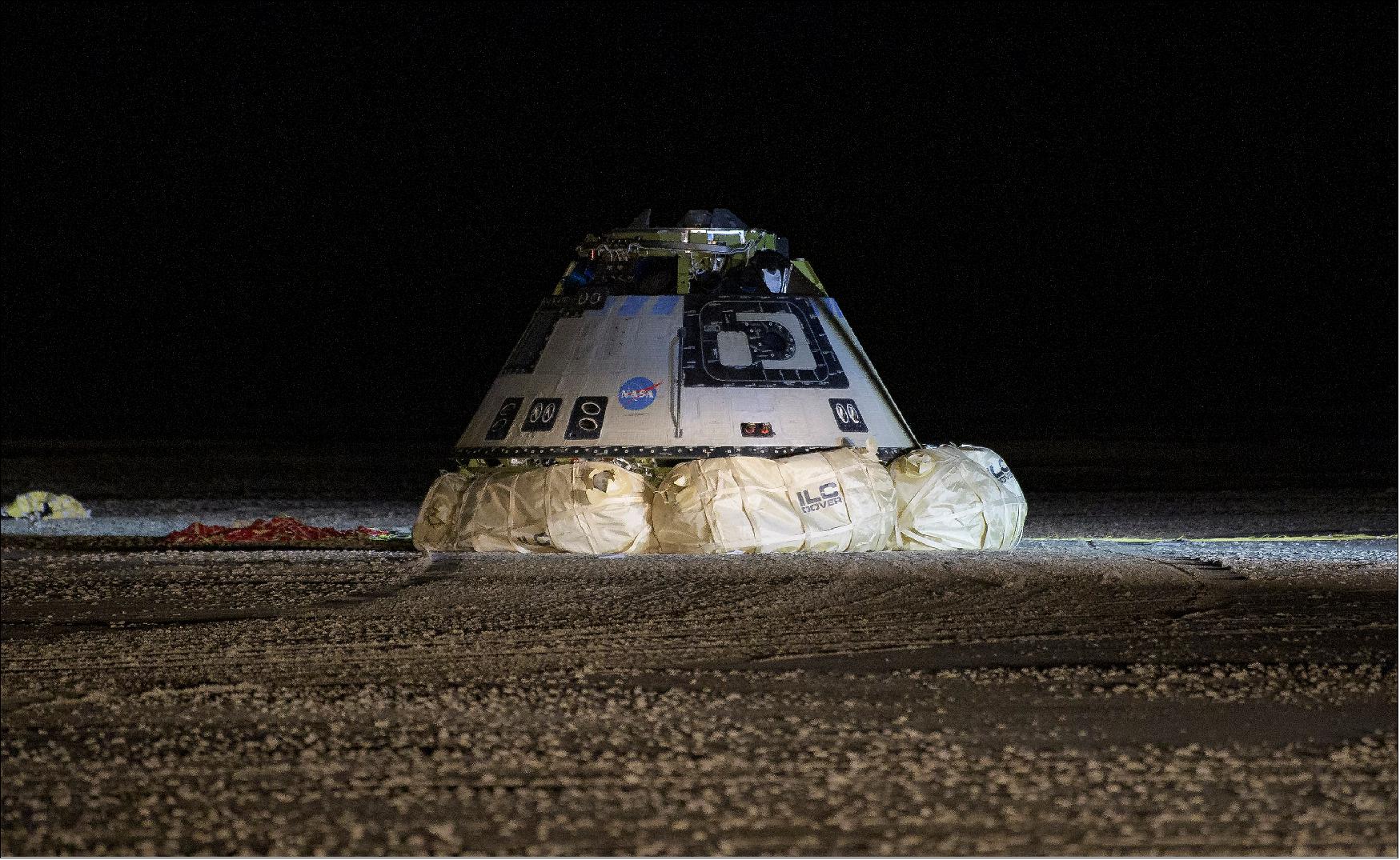
“Congratulations to the NASA and Boeing teams on a bullseye landing of the Starliner. The hardest parts of this orbital flight test were successful,” said NASA Administrator Jim Bridenstine. “This is why we conduct these tests, to learn and improve our systems. The information gained from this first mission of Starliner will be critical in our efforts to strengthen NASA’s Commercial Crew Program and return America’s human spaceflight capability.”
Although Starliner did not reach its planned orbit and dock to the International Space Station as planned, Boeing was able to complete a number of test objectives during the flight related to NASA’s Commercial Crew Program, including:
• Successful launch of the first human-rated United Launch Alliance (ULA) Atlas V rocket
• Checked out the Starliner propulsion systems
• Tested space-to-space communications
• Confirmed Starliner tracker alignments using its navigation system
• Tested Starliner’s NASA Docking System
• Validated all environment control and life support systems
• Completed a positive command uplink between the International Space Station and Starliner.
“Today’s successful landing of Boeing’s CST-100 Starliner spacecraft is a testament to the women and men who have dedicated themselves to ensuring Starliner can safely transport crews to low-Earth orbit and back to Earth,” said Boeing Senior Vice President of Space and Launch Jim Chilton. “The Starliner Orbital Flight Test has and will continue to provide incredibly valuable data that we, along with the NASA team, will use to support future Starliner missions launched from and returning to American soil.”
“This mission has only strengthened the resolve of the NASA, ULA, and Boeing teams," said NASA Deputy Administrator Jim Morhard. "Systems were tested, but more importantly the teams were tested. The hardest parts of this mission were a tremendous success. The Commercial Crew Program is strong. But keep in mind, this is a great reminder that human exploration is not for the faint of heart. We are just getting started!”
The Starliner that landed today will be refurbished for Boeing’s first operational crewed mission, following the Crew Flight Test. NASA astronaut Suni Williams, who will fly on that mission, dubbed the spacecraft “Calypso” after the ship of famed explorer Jacques Cousteau.
“I love what the ocean means to this planet,” said Williams. “We would not be this planet without the ocean. There’s so much to discover in the ocean, and there’s so much to discover in space.”
The uncrewed Starliner spacecraft launched on the ULA Atlas V rocket at 6:36 a.m. Friday, Dec. 20, from Space Launch Complex 41 at Cape Canaveral Air Force Station in Florida.
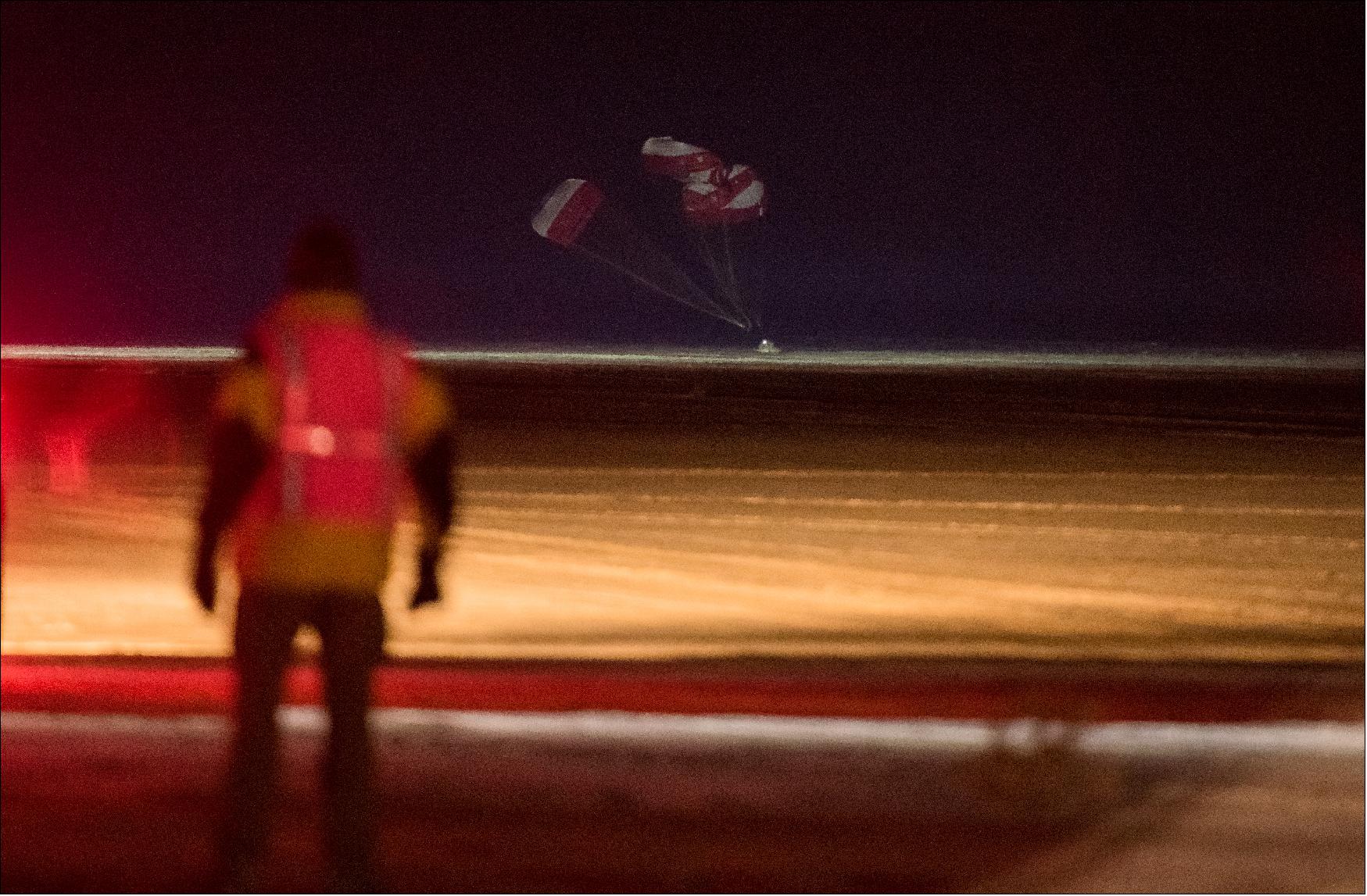
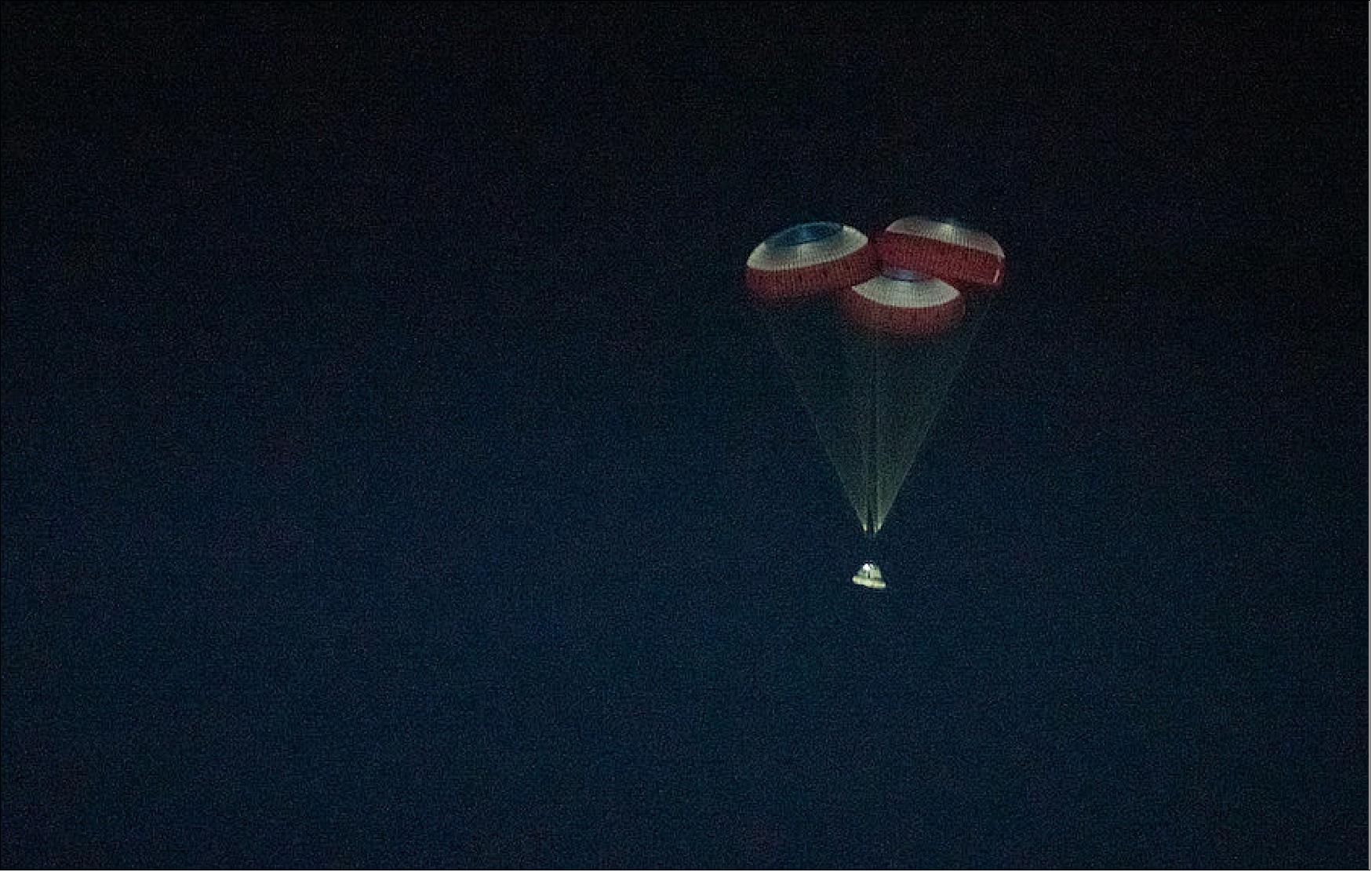
Starliner settled gently onto its air bags at 7:58 a.m. EST in a pre-dawn landing that helps set the stage for future crewed landings at the same site. The landing followed a deorbit burn at 7:23 a.m., separation of the spacecraft’s service module, and successful deployment of its three main parachutes and six airbags.
References
1) “NASA's Management of the Commercial Crew Program,” NASA, Report NO. IG-14-001 (Assignment NO. A-12-024-01), Nov. 13, 2013, URL: http://oig.nasa.gov/audits/reports/FY14/IG-14-001.pdf
2) Joshua Buck, Stephanie Martin, “NASA and Industry Complete First Phase to Certify New Crew Transportation Systems,” NASA, Release 14-148, May 30, 2014, URL: http://www.nasa.gov/press/2014/may/nasa-and-industry-complete-first-phase-to-certify-new-crew-transportation-systems/
3) Stephanie Schierholz, Stephanie Martin, “NASA Chooses American Companies to Transport U.S. Astronauts to International Space Station,” NASA, Release 14-256, Sept. 16, 2014, URL: http://www.nasa.gov/press/2014/september/nasa-chooses-american-companies-to-transport-us-astronauts-to-international/
4) ”CST-100 Starliner - A 21st Century Space Capsule,”Boeing, 2019, URL: https://www.boeing.com/space/starliner/
5) Jeff Foust, ”Boeing takes another Starliner charge against its earnings,” SpaceNews, 28 July 2022, URL: https://spacenews.com/boeing-takes-another-starliner-charge-against-its-earnings/
6) ”NASA Updates Astronaut Assignments for Boeing Starliner Test Flight,” NASA Press Release 22-061, 16 June 2022, URL: https://www.nasa.gov/press-release/nasa-updates-astronaut-assignments-for-boeing-starliner-test-flight
7) Josh Finch, Brittney Thorpe, Jennifer Wolfinger, Dan Huot, Sandra Jones, ”NASA, Boeing Complete Starliner Uncrewed Flight Test to Space Station,” NASA Press Release 22-050, 26 May 2022, URL: https://www.nasa.gov/press-release/nasa-boeing-complete-starliner-uncrewed-flight-test-to-space-station
8) Jeff Foust, ”NASA plans to make Starliner crew assignments this summer,” SpaceNews, 23 May 2022, URL: https://spacenews.com/nasa-plans-to-make-starliner-crew-assignments-this-summer/
9) Mark Garcia, ”Crew Works Starliner Operations and Studies Space Biology,” NASA’s Boeing Orbital Flight Test 2 (OFT-2), 23 May 2022, URL: https://blogs.nasa.gov/oft-2/2022/05/23/crew-works-starliner-operations-and-studies-space-biology/
10) Jeff Foust, ”Starliner launches to remain on Atlas 5,” SpaceNews, 22 May 2022, URL: https://spacenews.com/starliner-launches-to-remain-on-atlas-5/
11) Mark Garcia, ”Station Crew Opens Boeing Starliner Hatch, Enters Spacecraft,” NASA's Boeing Orbital Flight Test 2 (OFT-2), 21 May 2022, URL: https://blogs.nasa.gov/oft-2/2022/05/21/station-crew-opens-boeing-starliner-hatch-enters-spacecraft/
12) Jeff Foust, ”Starliner docks with ISS for the first time,” SpaceNews, 20 May 2022, URL: https://spacenews.com/starliner-docks-with-iss-for-the-first-time/
13) Joshua Finch, Brittney Thorpe, Jennifer Wolfinger, Dan Huot, ”Starliner Launches to Space Station on Uncrewed Flight Test for NASA,” NASA Press Release 220.046, 20 May 2022, URL: https://www.nasa.gov/press-release/starliner-launches-to-space-station-on-uncrewed-flight-test-for-nasa
14) Mark Garcia, ”What You Need to Know about NASA’s Boeing Orbital Flight Test-2,” NASA Feature, 16 May 2022, URL: https://www.nasa.gov/feature/what-you-need-to-know-about-nasa-s-boeing-orbital-flight-test-2-0
15) Amy Thompson, ”NASA sets mid-May launch for Boeing Starliner spacecraft's initial trip to ISS,” Space Daily, 3 May 2022, URL: https://www.spacedaily.com/reports/NASA_sets_mid-May_launch_for_Boeing_Starliner_spacecrafts_initial_trip_to_ISS_999.html
16) Jeff Foust, ”NASA safety panel recommends agency review how it manages human spaceflight programs,” SpaceNews, 18 January 2022, URL: https://spacenews.com/nasa-safety-panel-recommends-agency-review-how-it-manages-human-spaceflight-programs/
17) Jeff Foust, ”NASA supports Boeing as Starliner valve investigation continues,” SpaceNews, 19 October 2021, URL: https://spacenews.com/nasa-supports-boeing-as-starliner-valve-investigation-continues/
18) Jeff Foust, ”Boeing and NASA continue to investigate Starliner valve problem,” SpaceNews, 9 October 2021, URL: https://spacenews.com/boeing-and-nasa-continue-to-investigate-starliner-valve-problem/
19) Jeff Foust,”NASA reshuffles commercial crew astronaut assignments because of Starliner delays,” SpaceNews, 7 October 2021, URL: https://spacenews.com/nasa-reshuffles-commercial-crew-astronaut-assignments-because-of-starliner-delays/
20) Jeff Foust, ”Starliner test flight faces months-long delay,” SpaceNews, 13 August 2021, URL: https://spacenews.com/starliner-test-flight-faces-months-long-delay/
21) Jeff Foust, ”Starliner glitch delays launch,” SpaceNews, 3 August 2021, URL: https://spacenews.com/starliner-glitch-delays-launch/
22) Danielle Sempsrott, ”What You Need to Know about NASA’s Boeing Orbital Flight Test-2,” NASA Feature, 26 July 2021, URL: https://www.nasa.gov/feature/what-you-need-to-know-about-nasa-s-boeing-orbital-flight-test-2
23) Jeff Foust, ”Starliner cleared for second uncrewed test flight,” SpaceNews, 23 July 2021, URL: https://spacenews.com/starliner-cleared-for-second-uncrewed-test-flight/
24) Jeff Foust, ”NASA and Boeing close out recommendations from Starliner review,” SpaceNews, 17 June 2021, URL: https://spacenews.com/nasa-and-boeing-close-out-recommendations-from-starliner-review/
25) James Cawley,”Boeing’s Starliner System Completes Full Space Station Mission Simulation,” NASA Feature, 6 May 2021, URL: https://www.nasa.gov/feature/boeing-s-starliner-system-completes-full-space-station-mission-simulation
26) Jeff Foust, ”Next Starliner test flights slips to late summer,” SpaceNews, 18 April 2021, URL: https://spacenews.com/next-starliner-test-flights-slips-to-late-summer/
27) James Cawley, ”NASA, Boeing Update Starliner Orbital Flight Test Date,” NASA Commercial Crew Program, 17 February 2021, URL: https://blogs.nasa.gov/commercialcrew/category/boeing/
28) Anna Heiney, ”NASA and Boeing Target New Launch Date for Next Starliner Flight Test,” NASA Commercial Crew Program, 25 January 2021, URL: https://blogs.nasa.gov/commercialcrew/2021/01/25/nasa-and-boeing-target-new-launch-date-for-next-starliner-flight-test-2/
29) Jeff Foust, ”Next Starliner test flight scheduled for late March,” SpaceNews, 11 December 2020, URL: https://spacenews.com/next-starliner-test-flight-scheduled-for-late-march/
30) Jeff Foust, ”NASA safety panel raises doubts about Starliner test flight schedule,” SpaceNews, 2 October 2020, URL: https://spacenews.com/nasa-safety-panel-raises-doubts-about-starliner-test-flight-schedule/
31) James Cowley, ”Boeing’s Starliner Makes Progress Ahead of Flight Test with Astronauts,” NASA Commercial Crew, 28 August 2020, URL: https://www.nasa.gov/feature/boeing-s-starliner-makes-progress-ahead-of-flight-test-with-astronauts
32) Danielle Sempsrott, ”NASA and Boeing Complete Orbital Flight Test Reviews,” NASA, 8 July 2020, URL: https://www.nasa.gov/feature/nasa-and-boeing-complete-orbital-flight-test-reviews
33) Marie Lewis, ”Boeing to Fly Second Uncrewed Orbital Flight Test for NASA,” NASA Commercial Crew Program, 6 April 2020, URL: https://blogs.nasa.gov/commercialcrew/2020/04/06/boeing-to-fly-second-uncrewed-orbital-flight-test-for-nasa/
34) Jim Cawley, ”Boeing and NASA Approach Milestone Orbital Flight Test,” NASA, 16 December 2019, URL: https://www.nasa.gov/feature/boeing-and-nasa-approach-milestone-orbital-flight-test
35) Linda Herridge, ”Flight Readiness Concludes for Boeing’s Orbital Flight Test,” NASA Commercial Crew Program, 12 December 2019, URL: https://blogs.nasa.gov/commercialcrew/2019/12/12/flight-readiness-concludes-for-boeings-orbital-flight-test/
36) ”Boeing Starliner Crew Spacecraft Heads to Pre-Launch Processing,” NASA, 22 November 2019, URL: https://www.nasa.gov/image-feature/boeing-starliner-crew-spacecraft-heads-to-pre-launch-processing
37) ”Boeing's Starliner Completes Pad Abort Test for Commercial Crew,” NASA Press Release, 4 November 2019, URL: https://www.nasa.gov/press-release/boeing-s-starliner-completes-pad-abort-test-for-commercial-crew
38) ”Boeing tests space crew capsule, reports problem with parachute,” Space Daily, 5 November 2019, URL: http://www.spacedaily.com/reports/Boeing_tests_space_crew_capsule_reports_problem_with_parachute_999.html
39) Jeff Foust, ”Boeing, SpaceX press towards commercial crew test flights this year,” Space News, 9 October 2019, URL: https://spacenews.com/boeing-spacex-press-towards-commercial-crew-test-flights-this-year/
40) James Cawley, ”Boeing Completes Starliner Hot Fire Test,” NASA Commercial Crew Program, 24 May 2019, URL: https://blogs.nasa.gov/commercialcrew/tag/cst-100-starliner/
41) ”Aerojet Rocketdyne Ships Starliner Re-entry Thrusters,” Space Daily, 18 March 2018, URL: http://www.spacedaily.com/reports/Aerojet_Rocketdyne_Ships_Starliner_Re_entry_Thrusters_999.html
42) ”NASA Commercial Crew Program Mission in Sight for 2018,” NASA, 4 Jan. 2018, URL: https://www.nasa.gov/image-feature/boeing-cst-100-starliner-in-space
43) ”NASA Live: Boeing Starliner Orbital Flight Test,” NASA, 20 December 2019, URL: https://www.nasa.gov/nasalive
44) Jeff Foust, ”Starliner suffers “off-nominal” orbital insertion after launch,” SpaceNews, 20 December 2019, URL: https://spacenews.com/starliner-suffers-off-nominal-orbital-insertion-after-launch/
45) Stephen Clark, ”Boeing’s Starliner capsule lands after missing rendezvous with space station,” Spaceflight Now, 22 December 2019, URL: https://spaceflightnow.com/2019/12/22/boeings-starliner-capsule-safely-lands-after-missing-rendezvous-with-space-station/
46) William Harwood, ”No decision yet on additional test flight for Boeing Starliner spacecraft,” Spaceflight Now, 7 March 2020, URL: https://spaceflightnow.com/2020/03/07/no-decision-yet-on-additional-test-flight-for-boeing-starliner-spacecraft/
47) ”Boeing says longer Starliner software tests could have prevented flight failure,” Space Daily, 27 February 2020, URL: https://www.spacedaily.com/reports/Boeing_says_longer_Starliner_software_tests_could_have_prevented_flight_failure_999.html
48) ”NASA Shares Initial Findings from Boeing Starliner Orbital Flight Test Investigation,” NASA Commercial Crew Program, 7 February 2020, URL: https://blogs.nasa.gov/commercialcrew/2020/02/07/nasa-shares-initial-findings-from-boeing-starliner-orbital-flight-test-investigation/
49) Stephen Clark, ”Boeing expects ‘minimal refurbishment’ on reusable Starliner crew capsule,” Spaceflight Now, 15 January 2020, URL: https://spaceflightnow.com/2020/01/15/boeing-to-perform-minimal-refurbishment-on-reusable-starliner-crew-capsule/
50) Marie Lewis, ”NASA update on Boeing’s Orbital Flight Test,” NASA, Commercial Crew Program, 7 January, 2020, URL: https://blogs.nasa.gov/commercialcrew/2020/01/07/nasa-update-on-boeings-orbital-flight-test/
51) Josh Finch, Stephanie Schierholz, Dan Huot, ”NASA, Boeing Complete Successful Landing of Starliner Flight Test,” NASA Release 19-101, 22 December 2019, URL: https://www.nasa.gov/press-release/nasa-boeing-complete-successful-landing-of-starliner-flight-test
52) Mark Garcia, ”Boeing’s Starliner Spacecraft Touches Down in New Mexico,” NASA, 22 December 2019, URL: https://blogs.nasa.gov/spacestation/2019/12/22/boeings-starliner-spacecraft-touches-down-in-new-mexico/
The information compiled and edited in this article was provided by Herbert J. Kramer from his documentation of: ”Observation of the Earth and Its Environment: Survey of Missions and Sensors” (Springer Verlag) as well as many other sources after the publication of the 4th edition in 2002. - Comments and corrections to this article are always welcome for further updates (eoportal@symbios.space).